SAGE, AUGUSTUS B. (1842-1874). Colonel, 11th New York Infantry; captain, 170th New York Infantry, Company B; 17th New York Veteran Infantry, Companies D and A; 84th New York Infantry (14th Brooklyn). Born in Connecticut, Sage, a stationer, had an interest in rare coins and medals that led to his forming an Antiquarian Society, of which he served as corresponding secretary and curator, in his New York City home at 121 Essex Street. He was the first dealer to write a column in the New York Dispatch beginning in 1857 and the first dealer to issue a series of commemorative medals. A principal founder of the American Numismatic Society, he was the leading rare coin cataloguer in 1859.
Civil War Bio Search
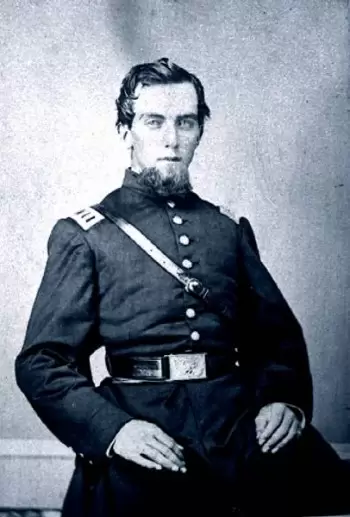
During the Civil War, Sage enlisted in the 84th New York on September 30, 1862, then joined Company B of the 170th New York Infantry as captain. Ill health forced him to resign a few months later, but he was soon able to join Company A of the 11th New York Infantry. He was quickly promoted to colonel, but the unit was discontinued and the men transferred to the 17th New York Veteran Infantry. After being made captain of the regiment, he resigned because he did not wish to serve as captain when he had previously been a colonel.
After the Civil War, Sage became a lawyer in New York City and wrote a few reminiscences for the American Numismatic Society in 1867. He died pneumonia in New York City where he lived at 32 Rutgers Street. Section 127, lot 2458, grave 541.
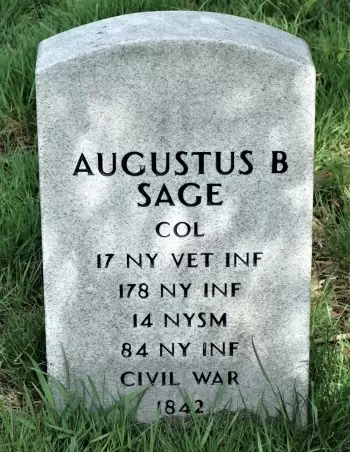
SAGE, ETIENNE (1826-1873). Private, 55th Regiment, New York State National Guard, Company E. A French native, he served in his company for 30 days in 1863. Sage was a producer of absinthe, a high-proof liquor, which was banned in United States for almost a century until the prohibition was lifted late in 2007. He died of apoplexy at sea aboard the steam ship Ville de Paris. Section M, lot 21373.
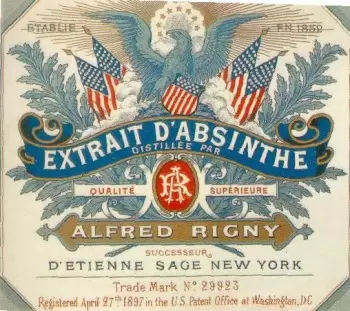
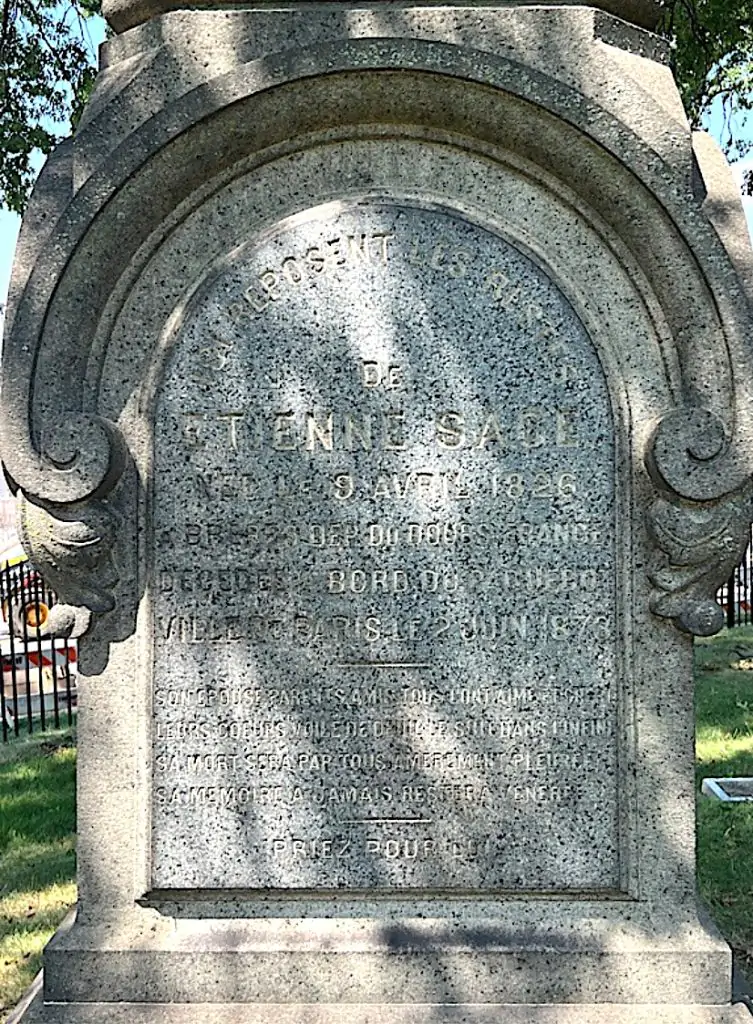
ST. GEORGE, JOHN FRANCIS (1842-1876). Private, 37th New York Infantry, Company K. A Brooklyn native, he served in the 37th New York but no further details about his service are known. He last lived at 71 State Street, Brooklyn, but died at Catskill, New York. Section 184, lot 22309.
ST. JOHN, GEORGE GILES (1829-1866). Corporal, 5th New York Veteran Infantry, Company H; private, 84th New York (14th Brooklyn) Infantry, Companies D and C. St. John was 5′ 3½” tall with a dark complexion, blue eyes and auburn hair. A compositor for The New York Herald, he had signed a memorandum with fellow employees dated August 21, 1862, asking to raise a relief fund for families of workers who entered the Union Army. He had enlisted at Brooklyn on August 20, 1862 (the day before the aforementioned memo), mustered into the 14th on August 21, and was transferred to Company C on November 13, 1862. He was wounded slightly by a shell to his face at the Battle of Gettysburg, Pennsylvania, in early July 1863. On June 2, 1864, he was transferred to the 5th New York Veterans. Promoted to corporal on November 1, 1864, he mustered out on May 31, 1865, at Alexandria, Virginia.
Many of St. John’s letters to his family have survived. They are eloquently written and are filled with news and descriptions of his whereabouts and living conditions, how he and his regiment are faring, concern for his family, and supplications to his family to write him. The tone and content of the letters change as the conflict progresses, from his first letter on September 29, 1862, when he concluded by saying, “…There is a great deal of fun connected with a soldier’s life-notwithstanding all its hardships.” However, St. John remained hopeful that he would see his family again. The following are excerpts from a few of these letters (unedited) written during the Civil War:
Nov. 27, 1862 Camp Brook, Brook’s Station, on the Aquia Creek and Fredericksburg Railroad, Virginia
…it was raining and rained all night and as we have nothing but what they call “shelter tents” – (made out of cheap drilling) of course everything on and off of us was wet and I can tell you it is not very agreeable to lay down on the wet ground with all your clothes on you also soaking wet, but it has to be done and I have stood it so far very well and am thankful that I have not fared worse…The one thing I have to complain about is not getting any pay yet and therefore not being able to send any home or to get the little necessaries which I need to make me comfortable and to have a little change from government “hard tack” and coffee…we are encamped about six miles from Aquia Creek and it takes a wagon…two days to go and come and bring a very light load…the roads have been so bad that the sutlers to the different regiments have been unable to get here…Our sutler has not been to the regiment in nearly a month …I have had the honor to be “Orderly to the Adjutant,” (which exempts me from all guard and other duty) ever since the 10th, just, so you see I have had a little luck after all. I have had the honor of a personal conversation with Major Gen Doubleday (Capt Doubleday of Fort Sumter fame)…
May 12, 1863 Camp Wadsworth, in the woods, near the Rappahannock
…Yesterday at “dress parade” four men “fell out” from sun stoke and cramps, occasioned from fatigue and the extreme heat. Dear “Sis” [St. John’s wife] in the past few days I have seen enough to sicken anyone of this war – seen the artillery mow down men by the hundreds and their comrades “closing up “the “gaps” so made and marching forward over the bodies of the killed and wounded, only to be added to them in turn, until they were piled up in heaps and at last compelled to fall back leaving them on the field. Then artillery had set the woods on fire in which they lay was terrible; we would not allow the “rebs” to remove their wounded nor they ours…we will attempt another crossing of the river, but if we do God help us! We have done well and the men have fought nobly and cheerfully, but they all seem to think that an attempt to cross again here is sheer folly and have but little faith and have lost courage, but after all you can have no idea how the first shot that is fired close by you changes you whole feelings and makes you forget everything but loading and looking out for something to fire at… I think it is a shame to keep one regiment so long at the “front” without any rest. It makes the boys feel bad to see regiment after regiment going home and they compelled to remain and they being the oldest regiment from the State in the field. Something singular in the treatment of this regiment. We are the first and oldest regiment from the State of New York…
May 30, 1863 Camp Wadsworth
…I have not been entirely well since our raid to Port Royal, but continue to do duty as usual. On the first of June we will be the only regiment left in our brigade – all the rest will have gone home. What they will do with us I do not know…Since I last wrote you our ranks have been considerably reduced by killed, wounded and sick. Oh Mother how I wish this war would end, and so would those who cry all the time “On to Richmond”…If they could have seen the great “heaps” of killed and wounded at the battle of Chancellorsville, and then to see the woods on fire, hear the cries of the wounded, and both armies have to lay on their arms in plain sight and hearing, neither daring to go to their relief. I say to have to lay still and see them burn up it was dreadful – yet they still cry “On to Richmond”…
October 28, 1863, in camp at Bristoe Station, Virginia
…Ever since I got that awful shock at the battle of “Gettysburg” I have been growing deaf – and at present cannot hear ordinary conversation; another thing is I have had an “abscess” come in the worst place it could be for a soldier and that is just below the end of the back bone and near the rectum and causes me a great deal of pain in marching and drilling; I have to have it lanced every little while, unless I am where I cannot get to the doctor (perhaps on picket) and then I have to suffer until it breaks of itself…I have a proposition to make to you and that is about writing to Captain Paine to see if he could not have me detailed to do something – anything that would ease me as to marching, drilling and guard duty…A letter directed to Capt Paine, Chief of Topographical Engineers, Headquarters Army of the Potomac. If you do write be sure and tell him I am in “C” Co., 14th regiment N.Y.S.M, 2nd brigade, 1st division, 1st army corps now at Bristoe station. One thing I forgot to say that that is do not say anything to “Sis” [St. John’s wife] about my deafness or the “abscess”…
March 1, 1864 Culpeper Court House, Virginia
…you must forgive me for not writing more often…as [my] duty is very heavy here and what with “guard”, “patrol”, “fatigue”, and “drill” and “review” duty in the regiment and “cooking”, getting and cutting wood, cleaning quarters, washing clothes…I have very little time to either read and write – papers lay in my knapsack several days after…before I get time to read them very often. Another reason is that since losing “little frank” I have not felt as though I could write and find it hard work to do so…I am in comfortable quarters (a room in the Piedmont Hotel) and plenty (and good at that) to eat and to drink, with plenty of good warm clothing – with the exception of boots, they cost $10 or $12 at the sutler’s and I cannot afford them…P.S. – I hear our troops have crossed the Rapidan River and are near Mine Run – a large number of deserters came in this morning and among them were a captain and two lieutenants – they say the rebs are falling back on Richmond.
May 20, 1864 In the rifle pits near Spotsylvania Court House, Virginia
Here I sit, in our rifle pits, first line, our skirmishers about three hundred paces in front, writing these few lines to you and to let you know that I am still alive and this being the fifteenth day “under fire” and more than half of our regiment killed, wounded and missing; we have been in five different charges on the rebels works, when we were exposed to a terrible shower of musketry, grape and canister, solid shot and shell, and while I wrote to “Sis” [St. John’s wife] yesterday the solid shot and shell was flying over and around us in a perfect shower; but I am still safe thank God! … We have lost our Division Gen (Gen Wadworth) and our Brigade Gen (Gen Rice) with one Capt and two Lieuts killed and three Capts wounded out of our regiment…
August 6, 1864 In camp in the woods, near Petersburg, Virginia
…Just think of it – this is the 93rd day that we have been “under fire” and although we (our division) are held in reserve (we are in the “regular” brigade) and lying here in the woods, we are still “in range,” and shot and shell go over and around us whenever the artillery open; while I was at the spring this morning, between camp and the fort they (the rebs) opened on our working squad, who are counter–mining in front of our fort, and a solid shot struck the breastworks of our fort, and struck the ground about two hundred yards ahead of me; another passed over, stuck in the 146th reg (lying next in line to us) passed over our camp and struck one of our regiment who was walking along about twenty feet from the commanding officers tent, killing him instantly …I was “down along” the line last Sunday to see the fort that was blown up and our dead and wounded lying there it was an awful sight – the whole thing was a terrible failure – reason whiskey – all the officers were drunk, the men done well and all that was required of them… We could have taken the whole reb line and not lost half the men we did if “orders” had been obeyed and our officers had been sober; what do you think of officers who will make their men charge with unfixed bayonets! As they did last Saturday…
November 24, 1864 “In the pits”, in “front”
This is “Thanksgiving Day”. The weather is beautiful, overhead, but dreadful muddy under foot, on account of the rain which we have had for the last few days; but as we have all suffered severely by it still we have cause to give “thanks” for it as it has “delayed” or “put off” an army move that was in contemplation and thus has saved a great many of us, for it is impossible to move now. “Thanksgiving day:…for two or three weeks our “rations” have been very small…this campaign has been one continuous battle from the commencement up to within a short time, and that if one portion of the line was not actually engaged in fighting it was hard at work building fortifications and then what little time we might have had has been used in drilling the new officers and recruits and you know that the “old vets” have to suffer for all as they have extra duty…I don’t want any turkey or goose (ha! ha!) but oh! How I should like a piece of good cake, or some fries, or some of Mother’s short biscuits and butter, with a little smoking tobacco or something like that, but never mind I have less than nine months now to serve, and then hurrah! For home! God grant that I may live to see you all once more! You ask me to mention the number of battles I have been in – I will just give you the names, but some of them were two, three and four day fights, South Mountain; Antietam; First Fredericksburg; Reynold’s Crossing or “Second Fredericksburg”; Chancellorsville, “Gettysburg”; Rappahannock Station; Mine Run; Wilderness; Spotsylvania Court House; Laurel Hill; Po Run; Cold Harbor; before Petersburg; Waldon Road; with two “crabs” to the left from the road – these are the principle ones, with about as many more “skirmishes”…
He returned to his trade as a compositor for The Herald after the War. Cemetery records state that he died by drowning; according to a descendant, he committed suicide by jumping into the East River, a claim substantiated by news articles in local dailies about an unnamed man who plunged from a Greenpoint, Brooklyn, ferry boat. St. John’s obituary appearing in The Herald on Sunday, September 30, 1866, entitled “Death of a Soldier Printer,” recounted his military service and invited members of Company C of the 14th Regiment, N.G.S.N.Y. to meet at the Brooklyn Armory in full uniform to attend the funeral. Mary A. St. John applied for and received a widow’s pension of $8 per month commencing in 1890, certificate 348,715. Section B, lot 11005, grave 245.
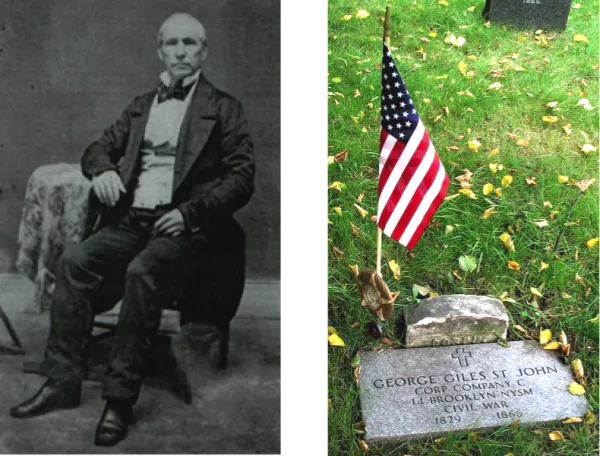
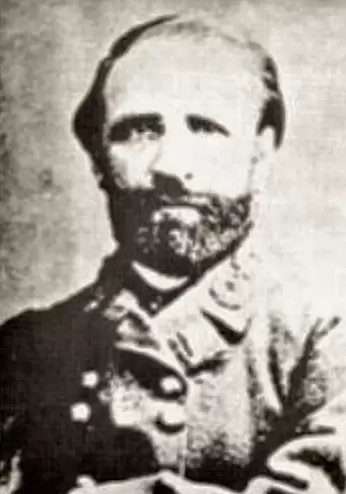
ST. JOHN, ISAAC MUNROE (1827-1880). Brigadier general, Nitre and Mining Bureau, War Department, Confederate States of America. Originally interred in lot 836, his remains were removed from Green-Wood on November 1, 1910, and re-interred at Hollywood Cemetery in Richmond, Virginia. Born in Augusta, Georgia, and raised in New York City, he was an 1845 graduate of Yale. He studied law in New York, then became an assistant editor of the Baltimore Patriot. He went on to pursue a career in civil engineering. From 1848 to 1855, he was on the engineering staff of the Baltimore & Ohio Railroad. St. John then lived for five years in South Carolina where he was chief of construction for the Blue Ridge Railroad.
During the Civil War, St. John joined the Fort Hill Guards, a South Carolina regiment, as a private. Holding the position of engineer in charge of the Yorktown, Virginia, defenses, he applied on October 13, 1861, to Judah P. Benjamin, Confederate Secretary of War, for a commission in the Engineer Corps of the Confederate Army. In 1862, he was chief engineer under General John B. Magruder and rose to the rank of captain and then major. In a letter dated February, 22, 1862, declining a commission as engineer, he wrote as follows:
It has been for some time my intention, as soon as relieved from duty at Yorktown, to explore the saltpeter caves of upper Georgia and East Tennessee – where I am informed the country has not been properly examined and the caves offered are badly worked. At Yorktown, I have been painfully impressed by our difficulty in ammunition. From want of power, the heavy guns were not sufficiently practiced. Without proper practice, our guns and batteries are of little use. Impressed with this view, I believe that I can better serve the cause in the manner indicated.
Appointed to the Confederate Mining and Nitre Bureau, created by Josiah Gorgas, records indicate that he received $426.88 for 64 days service as General Superintendent of Nitre Works in June 1862. In 1863, St. John was promoted to lieutenant colonel in this Bureau. According to James M. McPherson’s Battle Cry of Freedom, p. 320, “[St. John] located limestone caves containing saltpeter in the south Appalachians, and appealed to southern women to save the contents of chamber pots to be leached for niter.” In a letter dated December 22, 1863, and addressed to the Honorable W. P. Miles, House of Representatives, St. John transmitted “a statement of the entire force employed [by the Nitre and Mining Bureau] East of the Mississippi river – on government and contract work upon munitions charged to this Bureau.” There were 1,427 conscripts and 1,282 non-conscripts (“chiefly negroes”) who were employed in the Nitre Service; 986 conscripts and 818 non-conscripts in the Iron and Mining service; and 350 conscripts and 3,500 non-conscripts in the Iron and Mining Service south of North Carolina and “including coal in Ala.” St. John noted, “This total is materially less than the working force allotted to the service, when organized as an independent branch of the public defence (sic).” He went on, “Persistent efforts will be continued to substitute negro labor wherever practicable in the iron and mining service. But in the Nitre service, the experiment so often tried, can only be repeated with danger.” He concluded, “Permit me to refer briefly to the officers of this corps. In frontier work, they retire with and at times after the rear guard of the retreating army. Three of a small commissioned corps of twenty have been taken prisoner in the discharge of duty.”
On July 4, 1864, St. John was appointed commissary general with responsibility for supplying the Confederacy with gunpowder and metals. In February 1865, he was promoted to the rank of brigadier general. In the last days of the Civil War, when General Robert E. Lee and his Army of Northern Virginia fled west from Petersburg on April 4 and 5, 1865, they stopped at Amelia Court House, near one of the principal Confederate railroads, waiting for rations from Richmond, Virginia. Those rations, of which St. John was in charge, never came. Instead, a train came through carrying government documents. Apparently, Confederate looters took the food that was intended for the solders and St. John was not at fault. Without the needed supplies, Lee and his troops marched day and night for three days until they surrendered at Appomattox Court House on April 9, 1865. St. John was one of several Confederate cabinet members who met with Jefferson Davis in May 1865, at the home of Robert Toombs, in Washington, Georgia, for what amounted to the dissolution of the Confederate government. He surrendered at Thomasville, Georgia, on May 23, and returned to Richmond where he was pardoned on June 19, 1865, one day after taking the oath of amnesty.
After the Civil War, St. John returned to civil engineering, and was the chief engineer for the Louisville, Cincinnati, and Lexington Railroad from 1866 to 1869. He became the city engineer of Louisville, Kentucky, in 1870, where he made a topographical city map and designed its sewer system. He later became a consulting engineer on the Chesapeake and Ohio Railroad and chief engineer of the Lexington and Big Sandy Railroad. His death, in White Sulphur Springs, West Virginia, was attributed to diphtheria.
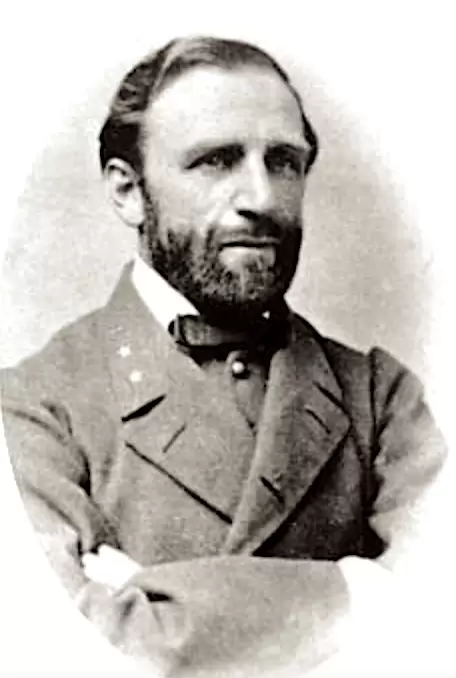
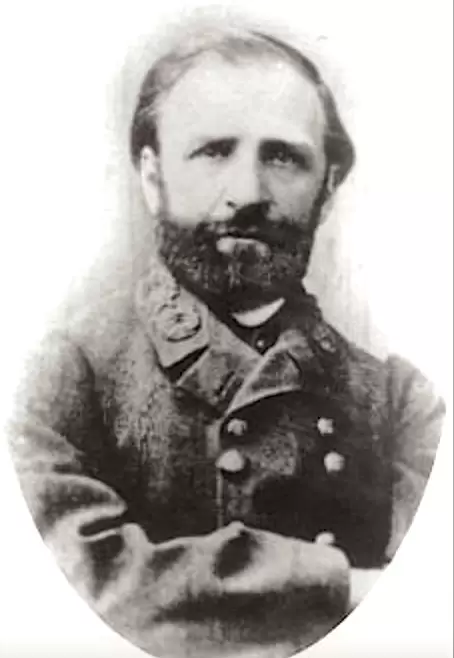
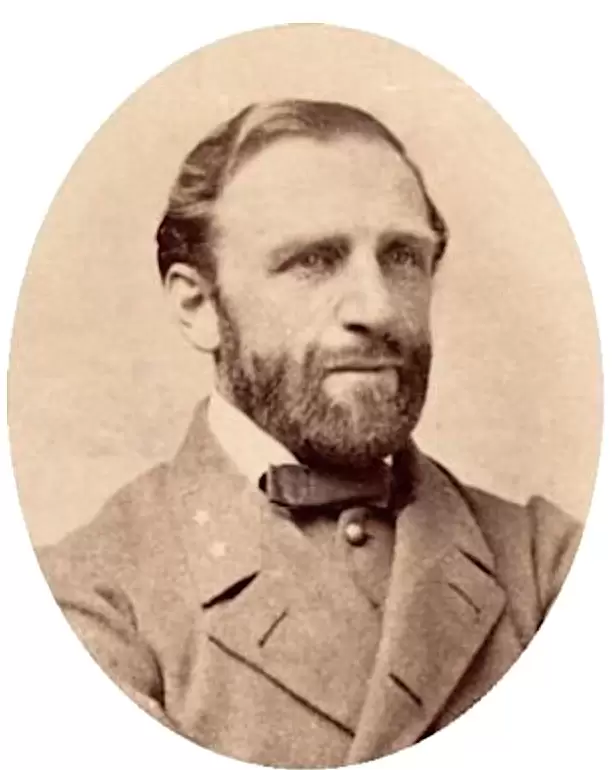
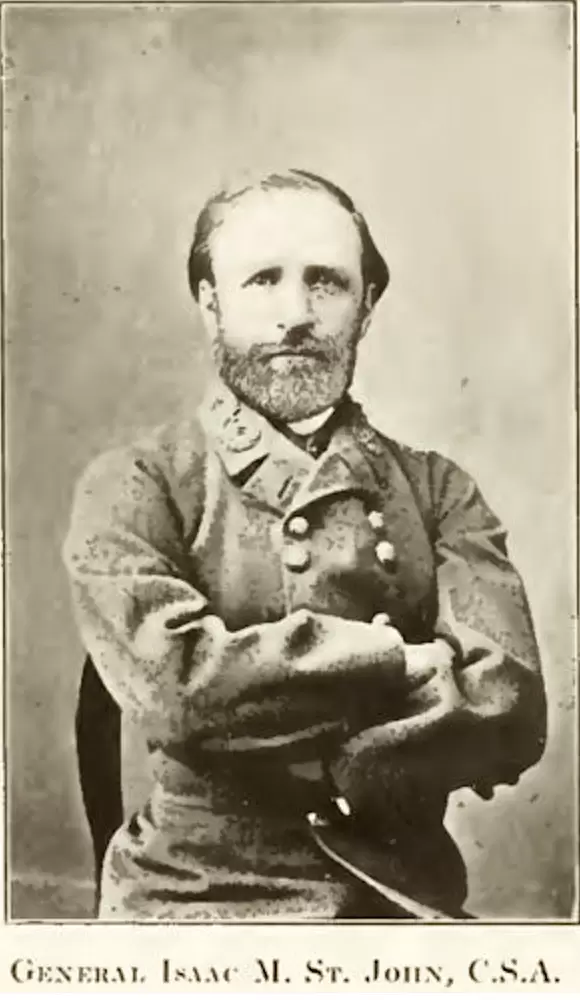
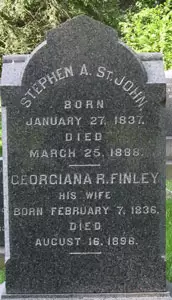
ST. JOHN, STEPHEN A. (1837-1888). Private, 84th New York (14th Brooklyn) Infantry, Company H; 5th New York Veteran Infantry, Company I. After enlisting at Brooklyn on September 16, 1862, St. John, who was born in Connecticut, mustered into the 14th Brooklyn the next day. He served with his unit until he was transferred into the 5th New York Veteran Infantry on June 2, 1864. On May 31, 1865, he mustered out at Alexandria, Virginia. In 1885, his application for invalid pension was approved, certificate 395,868. His last residence was at 412 West 58th Street in Manhattan. His widow received a pension after his death, certificate 248,710. Section 176, lot 18193.
SALE, JOHN W. (1831-1901). Corporal, 48th New York Infantry, Companies C and G; private, 28th Regiment, New York State Militia. A native of New York City, Sale first served as a private in the 28th Regiment from April 23, 1861 through August 5, 1861. On September 9, 1861, he re-enlisted at Brooklyn as a corporal and mustered into the 48th New York the next day. He re-enlisted on December 22, 1863, was transferred into Company G of the 48th on that day and, at some point, was reduced to the rank of private. He mustered out at Raleigh, North Carolina, on September 1, 1865.
The 1880 census reports that Sale was a tinsmith. According to the 1890 Veterans Schedule, which confirms his Civil War service, he was “ruptured in action” and was “still afflicted.” His application for an invalid pension was granted in 1891 under certificate 769,088. He last resided at 159 Prospect Avenue in Brooklyn. Nephritis was the cause of his death. Section 69, lot 2105.
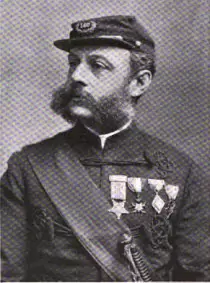
SALISBURY, RICHARD L. (1841-1915). Private, 7th Regiment, New York State Militia, Company B. Born in New York City and educated there at the Mount Washington Collegiate Institute, Salisbury’s great-grandfather served as a lieutenant in the Revolutionary War in the Sussex Militia of New Jersey. Salisbury joined the 7th Regiment on June 6, 1859, for a term of seven years. He served for 30 days in the 7th Regiment in 1861, returned to his company in 1862 for three months, and then for 30 days in 1863.
Active in many military organizations, Salisbury was a charter member of the Lafayette Post #140 of the G.A.R. (1880) where he held numerous leadership positions and was on the national staff in 1886. He also belonged to the Freemasons, Seventh Regiment Veteran Association, Society of the Army of the Potomac, the Sons of the Revolution in the State of New York, and wore the decoration of the Order of the Liberator authorized by the government of Venezuela. In 1907, his pension application was granted, certificate 1,134,287. His last address was 404 West 147th Street in Manhattan. His death was attributed to senility. Section 160, lot 11711, graves 9 and 10.
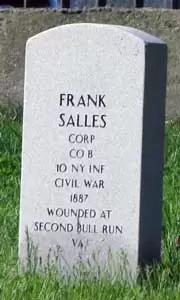
SALLES, FRANK (1827-1882). Corporal, 10th New York Infantry, Company B. Originally from Buffalo, New York, Salles enlisted at New York City as a private on April 26, 1861, and mustered in the next day. Promoted to corporal on November 1, 1861, he was wounded at Second Bull Run, Virginia, on August 30, 1862, and mustered out at New York City on May 7, 1863. His last residence was at 1129 1st Avenue, New York City. Salles succumbed to meningitis. Section 4, lot 21072, grave 5.
SALT, JAMES R. (1845-1900). Private, 13th Regiment, New York State National Guard, Company I; 37th New Jersey Infantry, Company E. After serving for 30 days in the 13th New York State National Guard in 1863, Salt enlisted as a private on June 6, 1864, and mustered into the 37th New Jersey on June 23. He remained with the regiment until he mustered out on October 1, 1864, at Trenton, New Jersey. His last residence was at 196 Grove Street in Brooklyn. His death was caused by diabetes. Section 191, lot 23409, grave 2.
SAMANOS, STEPHEN A. (or D.) (1838-1886). Musician, 7th Regiment, New York State National Guard, Companies C and E. At the time Samanos applied for a passport in 1860, he was 5′ 10″ tall with a long face, black hair, hazel eyes, pointed chin, dark complexion, Roman nose, and small mouth. During the Civil war, he enlisted as a musician at New York City on May 25, 1861, and served for three months with the 7th Regiment’s Company C. He returned to the 7th Regiment in 1862 and served as a private for three months with Company E. His death was caused by apoplexy. Section 179, lot 10839.
SAMPSON, ALFRED M. (1839-1866). Private, 84th New York (14th Brooklyn) Infantry. Born in Brooklyn, Sampson enlisted there as a private on September 11, 1862, and mustered into an unknown company of the 14th that day. There are no further details of his service. His last residence was 122 Columbia Street in Brooklyn where he died from consumption. Section 23, lot 2409.
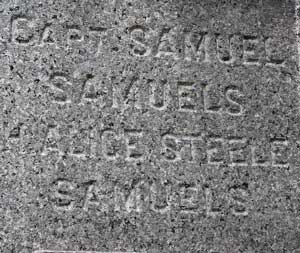
SAMUELS, SAMUEL (1823-1908). Mariner. Born in Philadelphia, Pennsylvania, he ran away from home to become a cabin boy at the age of 11. If it was adventure he was looking for, he soon found it: he was shipwrecked, shanghaied, chased by pirates, and fought cannibals. By 17 he was an officer and by 21 was in command of a ship bound for the Mediterranean. He declined the position of admiral in the Turkish Navy and rescued a Swedish woman from a harem in Constantinople. He survived bandits, cholera, and being washed overboard off the Cape of Good Hope. His greatest fame came as commander of the packet Dreadnought. He supervised its construction, which was completed in 1854, and she was soon nicknamed “The Wild Boat of the Atlantic.” He drove her back and forth across the Atlantic, always taking the shorter northern passage to save time despite dangers from ice and wind. In 1859, he set a packet speed record, crossing from New York to Liverpool, England, in 13 days and 8 hours. The reputation of the Dreadnought for safety and speed was such that passage aboard it was booked a year in advance.
During the Civil War, Samuels commanded the John Rice and the G. B. McClellan. In December 1866, he won the first transatlantic yacht race aboard James Gordon Bennett’s Henrietta. His memoir, From the Forecastle to the Cabin (1887), recounts his career. He was called the greatest of America’s packet commanders. After his sailing career was over, he organized the Rousseau Electric Signal Company and the United States Steam Heating & Power Company, was general superintendent of the Pacific Mail Steamship Company, and was president of the Marine Journal Company. Section 107, lot 11655.
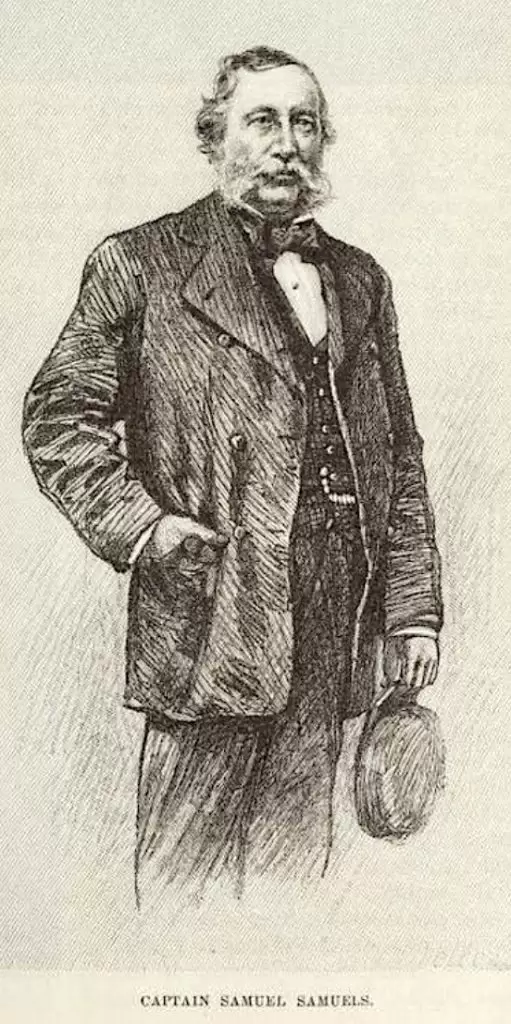
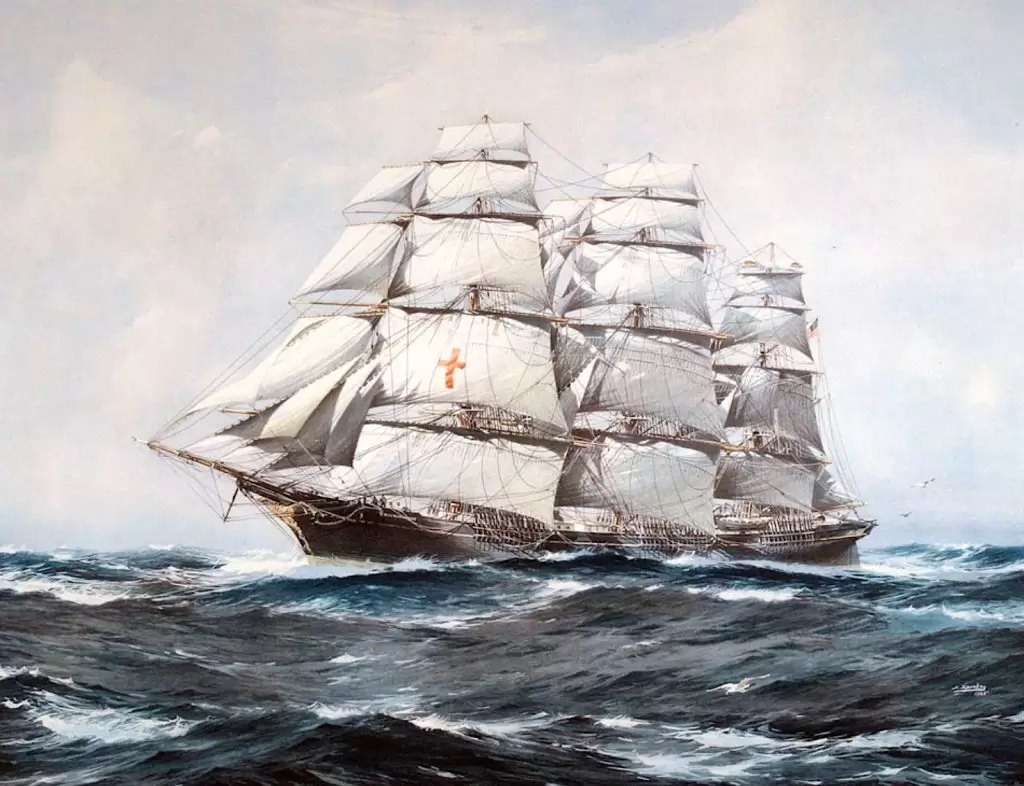
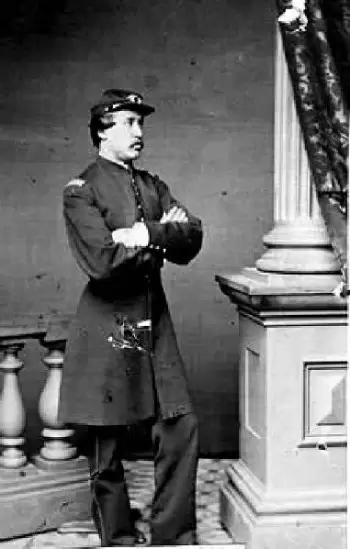
SAND, HENRY AUGUSTUS (1836-1862). Captain, 103rd New York Infantry, Companies D and A; private, 7th Regiment, New York State Militia, Company K. Born in New York City, Sand grew up in an affluent family and spent two years in Europe studying in Lausanne, Switzerland, when he was 18. His mother, Isabella, told a friend about his love of the United States, “…Society, flattery, love and indulgence had not choked the good seed in Henry; he burned with desire to serve his country; and his own temporal interests, his comforts, joys and affections were all laid aside at the call of duty…”
After serving in Company K of the 7th Regiment for 30 days in 1861, Sand re-enlisted as a captain at New York City on March 12, 1862, and was commissioned into Company D of the 103rd New York that same day. In mid-April, the 103rd was at Evans Mills, North Carolina. He is quoted as telling his family who urged him not to re-enlist until the need was greater, “I have nothing to offer myself and you yourself have taught me that in a republic every man must do his duty.” On April 18, 1862, he wrote to his brother Theodore from Evans Mills, North Carolina. (Original language and spelling.)
…Fanning has just returned from camp and brings full particulars, which he got from the Colonel’s lips, of the fight of the 103 men with the rebels. It was more than a skirmish and has brought our regiment and colonel into notice. It took place last Sunday on the road to Trenton some 10 miles from here and 15 or 20 west of Newburn at Fay’s plantation. By intercepted correspondence the Colonel formed us that he was to be attacked on Monday morning at 4 a.m. So he halted at Fay’s house to rest the men and prepare for the attack. About 9 o’clock in the evening the pickets were heard firing and before the men had hardly time to jump up the house was surrounded by 260 of the rebel cavalry. Our total force was but 140 of these 60 were posted at different points in the neighborhood leaving but 80 men to resist the 260 which was the correct number of the enemy according to accounts of the prisoners. The Colonel was up in a room washing his feet when the attack occurred without a moments notice the bullets came banging through the windows from the sides. He pulled on his boots without drying his feet and tore down stairs in his drawers with his saber in one hand and a revolver in the other. He must have looked gay! They say he acted splendidly and did not show the slightest concern for his personal safety. He cried out to cut down any man who moves an inch without orders, so they stood fast and blazoned away a steady fire which the rebels soon found too hot for them or for their horses perhaps for they couldn’t be brought up to our bayonets. The union was shining brightly and Egloffstein soon discovered the rebel commander and pointed him out to three of the men who fired simultaneously at him. Our shot passed through his clothes one side, the other shot on the other side through his coat and the third wounded him in the thigh and brought him from his horse. Our men made a charge led by the Colonel and got possession of the rebel commander after which the enemy began a retreat and were soon out of the reach of our fire. We not having enough men to pursue them. The rebel officer turned out to be Colonel Robinson of the 19th N.C. Cavalry who had come down with the 260 men to capture our force. He was a Captain in the U.S. mounted rifles-regulars-a graduate of West Point and acquaintance of Burnside, Reno and Parks….His wound though painful is not dangerous. From all accounts, both sides, we killed and wounded 50 of the rebels. Our info was one killed and five wounded-not a bad result for the first fight. We took about a dozen prisoners. The rebels carried away most of their killed and wounded as they were not much interfered with in their retreat. Two horses were found dead on the field…the estimate must have been right. If they had waited till daylight and seen how small our force was they would not have given up so soon….I hear today that we will soon leave for Beaufort to assist in the capture of Fort Macon. I shall enjoy that very much as I am anxious to witness a bombardment….
Sand described his feelings about his first fight on April 27, 1862, in this paragraph excerpted from a letter:
…The men were so fatigued by their march and want of sleep , they could not keep up with me. You can imagine my impatience to get to the scene of action and how I yelled to the men – “come on boys”- in German and English. I had felt quite tired and my feet hurt me considerably, but now I felt as light as a deer and could have leaped a six foot fence. On the piazza of the farm house were some forty or fifty rebels, loading and firing as fast as they could and as we approached the balls whistled by, but I was so much taken up with my men I did not think of the bullets nor did the blood of the wounded men and horses affect my nerves. On the contrary I felt my blood tingle with that excitement you sometimes experience when you witness a race or hear military music. I say this because a person’s sensations, when first brought under fire are so different I suppose you like to know exactly how I felt….
At some point during his service, he was transferred to Company A. He joined Burnside in North Carolina and Virginia and served for a time as provost marshal at Falmouth. In a letter to his mother written from New Berne, North Carolina, as he waited aboard ship, he wrote on July 2, 1862:
“…We were up at daybreak this morning and struck our tents, but did not leave our camping ground before 9 o’clock. The day is as fine as we can desire and on all sides we hear the bands of different regiments, as they march toward the place of embarkation and now and then, the distant cheers of the troops who are already on board some transport and under weigh. Our boys are in fine spirits and step along briskly for the idea of transportation by water, instead of a long march by land, is very refreshing. Before embarking our regiment was marched past the Col[onel]’s quarters, who was out in a buggy to see us. We gave him nine cheers – to which he responded in a spirited speech. He told us how much he lamented being obliged to remain behind – that the greatest pleasure he could ask would be to lead the regiment to battle etc. At the last moment changes were made and we are now in Col[onel] Hawkins’ Brigade and General Parke’s Division.”
In a letter dated August 30, 1862, he wrote from Falmouth, Virginia, “…Since yesterday we have been in expectation of an attack and as our force is not large enough to hold the place, we have been removing stores and making preparations to destroy what we cannot take with us.” Four days later, he described conditions in Aquia Creek, Virginia, “…On Sunday, we got orders to destroy Gov. property that had not been removed. We then fell back and joined the Brigade which was already on the march to Aquia Creek. We marched all night and arrived at the landing at daybreak, pretty well tired out. It rained on Sunday morning and put the roads in bad condition. We were often knee deep in mud and water and presented a rough appearance on our arrival. We are now encamped with what units we have left, about ½ a mile from the landing, on the summit of a hill. Today or tomorrow we will be shipped to Alexandria…” On September 17, 1862, he was wounded by a cannonball shot at the Battle of Antietam, Maryland, when the color bearer fell and he seized the flag planting it far ahead and urging the men to come forward. Sand wrote to his mother that day:
Dear Ma,
Here I lay on the field, shot through the thigh. My wound is painful but not mortal I believe-however I send you these lines to bid you all good bye in case I never see you again.-I hear our men cheering & hope the day is ours-if we only have a great victory, I am contented. Goodbye. My love & kiss to all.
Your loving son,
Henry
His mother, Isabella Sand, was most concerned about the pain her son was in and sought to get a suitable bed for him. She wrote to her husband from Sharpsburg, Maryland, on October 13, 1862:
…Here you can imagine we have many anxious weary moments. We have now a good physician, who attends Henry faithfully and does every thing in his power for him but he suffers a great deal. Particularly from a sore on the lower part of his back which is difficult to reach and to dry up, causes great pain. The Doctor says it must be cured, as combines with the other wound it would cause his death. His bed is most uncomfortable and the doctor says the only thing is to get a fracture bed and he can dry the wound from below. Never mind the under ribbon bed, I wrote for, as this is better. If Dr. Meyer had ordered it at first a suitable bed, Henry could have been save a great deal of suffering…
Isabella Sand wrote home on October 26, 1862, after the new bed was delivered. She described Henry’s deteriorating condition and the doctor’s prognosis and orders:
…He said most men would have died after the second week but that Henry has shown such power of endurance. That he has every hope of his entire recover, not however without a slight lame hep (sic). He says the important thing now is to try and keep up his appetite giving him as often as possible nourishment to counteract his drain on his system, proceeding from the wound. He orders him a cup of beef tea, three times a day, and eggs in different ways, in fact he lets him eat almost anything, that is easily digested. Unfortunately now Henry is tired of beef tea and says it will make him vomit, if I force him to take it. I have to find out something else. If we were only home, how many things I could get for him but here it is almost impossible. The Sanitary Commission is our main stand by and they are very kind and give us everything we ask for and more. You would find Henry very much altered and he grows thinner daily but the doctors are not alarmed and say it is always so after lying so long. They order him several times a day a little Sherry and sometimes when in extreme pain, brandy but they think now, he will not suffer as much as he has done. I trust in God, it may prove so, as he has had enough to bear and bears it so courageously too….
Henry Augustus Sand, clutching his mother’s hand, succumbed to his wounds on October 30, and was interred at Green-Wood a week later on November 7. A friend wrote this poem that was read at his grave:
Breathe not a whisper here,
The place where thou last stand is hallowed ground.
In silence gather near this upheaved ground
Around the soldier’s bier.
Here Liberty may weep,
And Freedom pause in her unchecked career,
To pay the sacred tribute of a tear
O’er the pale warrior’s sleep.
That arm, now cold in death,
But late on Glory’s field triumphant bore
Our country’s flag: that marble brow once wore
The victor’s fadeless wreath.
Rest soldier, sweetly rest.
Affection’s gentle band shall deck thy tomb
With flowers; and chaplets of unfading bloom
Be laid upon thy breast.
The colonel of his regiment wrote a letter to his family after his death that read in part, “…With the battle of Antietam will live his name, an ornament to the Army and to his country and a just source of pride to his family, to his friends and to his regiment for whom he has labored and sacrificed in this righteous cause, his life and his blood.” His tombstone notes, “He held aloft the Flag of our Country.” Section 42, lot 319.
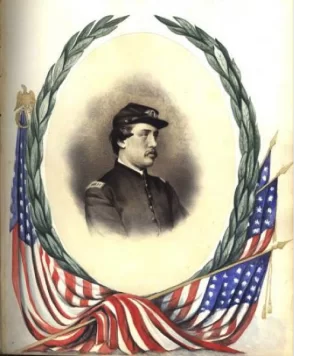
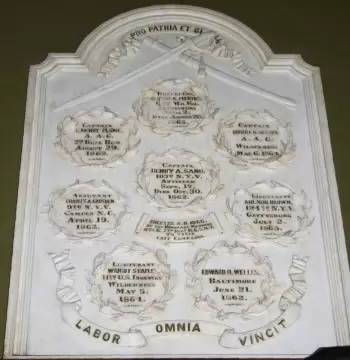
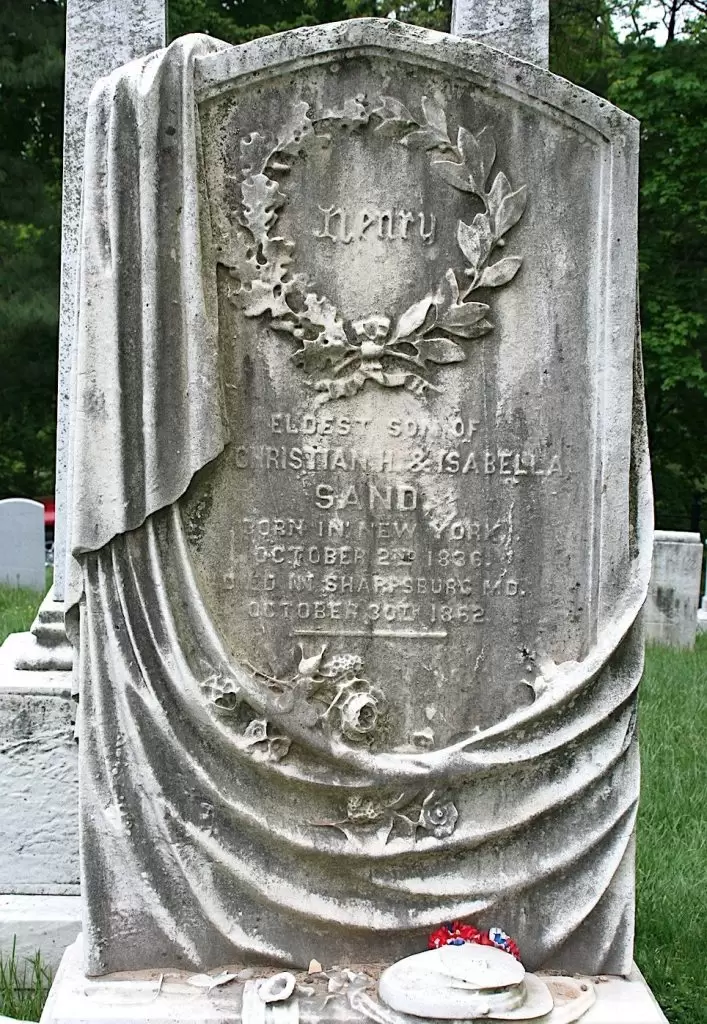
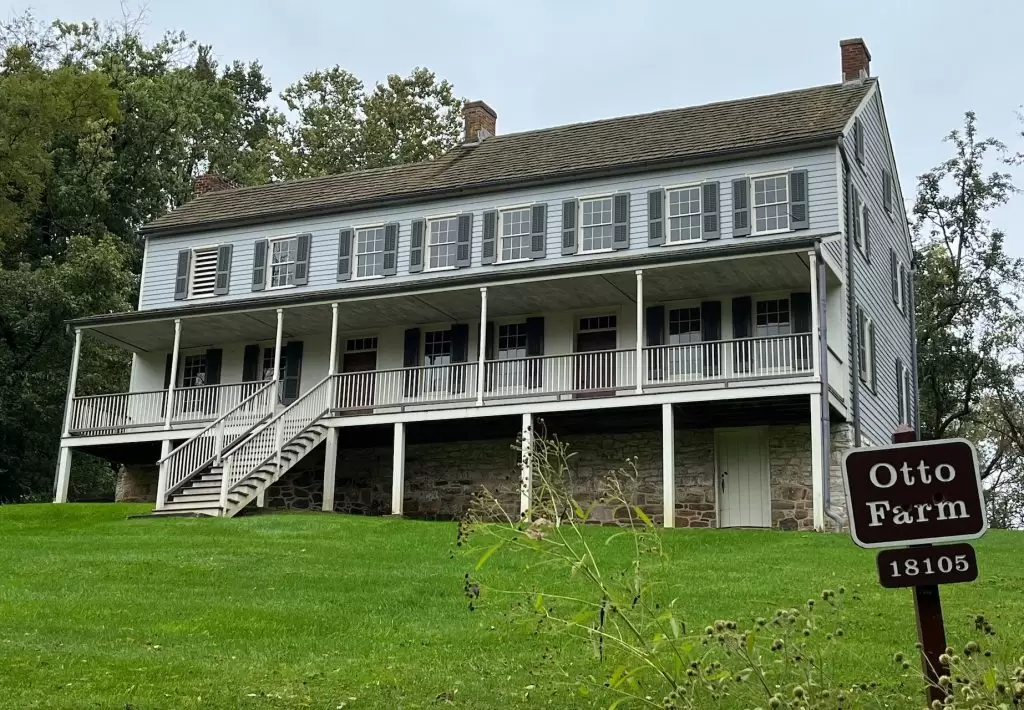
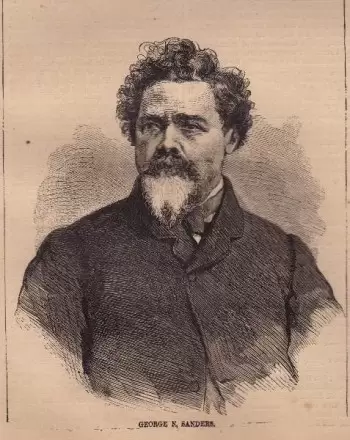
SANDERS, GEORGE NICHOLAS (1812-1873). Confederate agent. Born in Lexington, Kentucky, where he became a breeder of horses, he met and married Anna Reid of New York in 1836. Ms. Reid edited a political journal, Passion Flower, which was written by her father, Samuel Chester Reid, a United States Naval officer in the War of 1812. Samuel Reid was also a designer of the American flag that debuted in 1818 incorporating the thirteen stripes and adding an additional star for each new state. Like his father, Sanders was politically active, and in 1843, organized a meeting related to the annexation of Texas. That event attracted the attention of James K. Polk, and according to Cathryn J. Prince in Burn The Town and Sack The Banks! Confederates Attack Vermont (2006), catapulted Sanders to the national stage.
Sanders was committed to the ideals of the Young America movement, a group that favored republican revolutions to overthrow European monarchs. A supporter of President Franklin Pierce, he was appointed consul to London but became involved in anarchist causes and his nomination was rejected in February 1854 at which time he was recalled. Among his machinations, according to William A. Tidwell in Confederate Covert Action in the American Civil War, April ’65 (1995), Sanders wrote a letter advocating the killing of Louis Napoleon. At first, he returned to New York where he was a Naval agent, then went to Kentucky in 1859 to foster interest in states rights.
At the onset of the Civil War, Sanders was involved in schemes to increase the Confederate Navy but all failed. According to Tidwell, he was likely influenced by Karl Marx who was in London at the same time that Sanders was consul. In early 1862, he wrote, “It will, however, soon be in the power of the people of the Ohio Valley by bold revolutionary acts to tear themselves from the Lincoln iniquity. Organize! Organize for revolution.” (Tidwell, p. 124.) He then went to Montreal, Canada, in 1863, and according to an article in Wikipedia and Tidwell, was a part of clandestine and well-planned activities that supported the Confederacy through unorthodox means including meeting with John Wilkes Booth. In addition, he was caught up in the raid on the border town of St. Albans, Vermont, on October 19, 1864, when three of the town’s banks were robbed and the raiders fled to Canada. According to Prince, Sanders looked at St. Albans as the starting point for delivering terror to the North and forcing Union troops to be repositioned. He said, “There will be war to the knife and to the hilt. They will be made to think 20,000 men wait in Canada, across the border, eager and prepared. The towns will burn and be pillaged.” (p. 126) Sanders provided comfort to the prisoners before their trial, denied knowledge of the plan, and helped assemble the defense team. Ultimately, the raiders who remained in Canada were freed on April 10, 1865, and the monies were repaid to the banks.
Soon after the assassination of President Lincoln, Sanders became a suspect in the conspiracy and a reward of $25,000 was offered for his capture. On August 26, 1865, an article in The New York Times reiterated his alleged connection to Lincoln’s murder and noted that a supposed plot to abduct Sanders was in fact a group of thieves who desired his silver spoons or his Confederate gold. According to Tidwell, Sanders remained in Canada after Appomattox and worked hard to deflect blame from the Confederacy in the attack on Lincoln and was successful in preventing federal prosecutors from establishing their case (p. 148). Sanders left for Paris in November 1865 and returned to New York in 1872 where he lived at 321 East 17th Street in Manhattan. He died of heart disease. His son, Reid Sanders (see), was a major in the Confederacy. He is buried in an unmarked grave in the Reid family plot. Section 172, lot 13108.
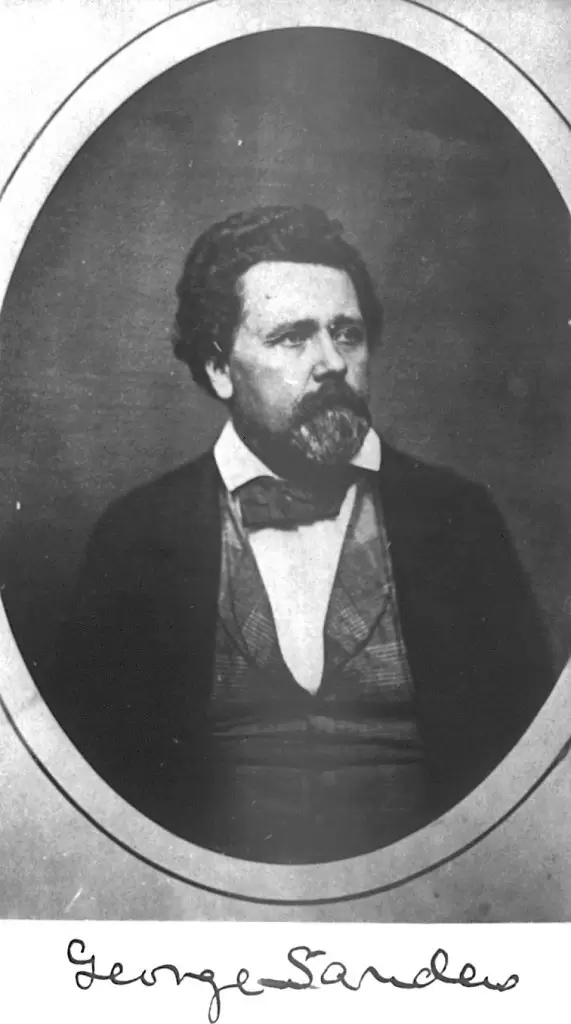
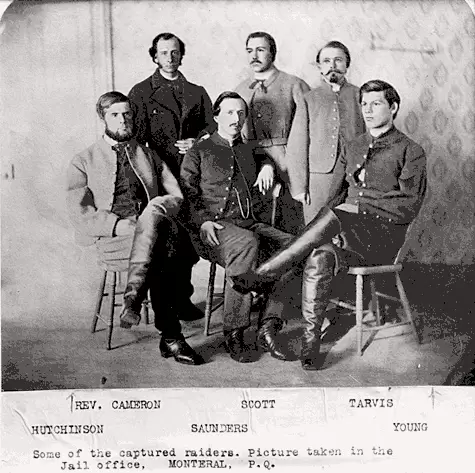
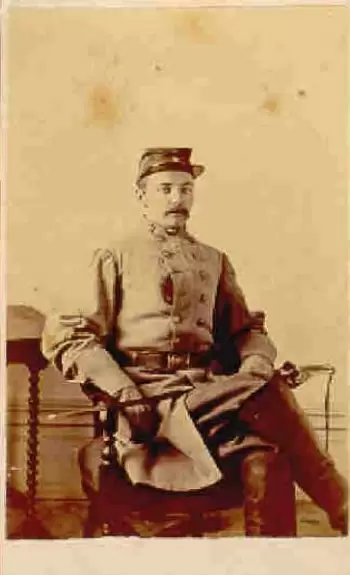
SANDERS, REID (1837-1864). Major, Confederate States of America. A native of Kentucky and resident of Virginia, Sanders was taken prisoner. As per an account in The New York Times from Baltimore on Wednesday, November 12, 1862:
The U.S. gunboat Hercules, Captain DUNGAN, arrived here this morning from a cruise along the borders of Virginia. On the morning of the 3d instant, just before daylight, Lieut. BAKER, with an armed boat’s crew, discovered a party on shore, signalizing to some rebel soldiers stationed up a small inlet. Finding they were discovered, they took to their boats and tried to escape. After a half hour’s chase a boat was captured, which was found to contain three men with signal lanterns, flags, arms, &c. One of the party proved to be Major REID SANDERS, a regular officer of the Confederate States army, and son of GEORGE N. SANDERS. The other two were English sailors. At the time of their capture they were expecting a vessel to convey Major SANDERS to Europe with rebel dispatches and were signalizing for that purpose. Two English sailors landed from a vessel from Halifax, N.S., about ten days previous, which brought over a prominent rebel with dispatches for the rebel Government.
As per another account, the CSS Atlanta, on which Sanders was serving, was captured by the USS Weehawken (see image below) in Warsaw Sound, Georgia, on June 17, 1863. He was then held at Fort Warren in Boston Harbor.
In August 1864, his mother, Anna J. Reid (who is interred at Green-Wood; her father was Samuel Chester Reid, War of 1812 hero who is credited with the idea of changing the number of stars, but not the 13 stripes, after the admission of new states to the Union), wrote to Jefferson Davis imploring him to exchange her son, but she was notified by C. S. A. Secretary of War James Seddon that an exchange was not possible. Davis subsequently saw to it that his mother received Reid’s pay. Reid Sanders died, still a prisoner, from dysentery on September 3, 1864, but it was not until months later that his mother learned of his death. His father was Confederate agent George Nicholas Sanders (see) who was active in both England and Canada, and was initially implicated in the conspiracy to assassinate President Abraham Lincoln, but was never prosecuted. Interment at Green-Wood was on April 10, 1865. Section 172, lot 13108.
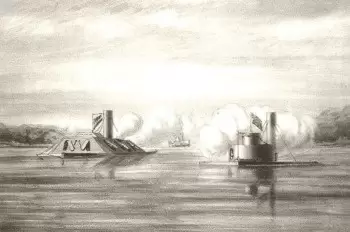
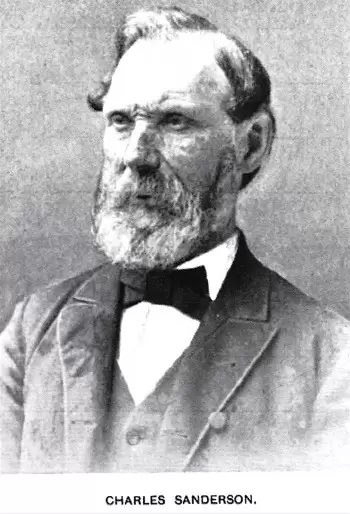
SANDERSON, CHARLES (1832-1901). Chief bugler, 79th New York Infantry. A native of Aberdeen, Scotland, he was brought up in Edinburgh, and immigrated to the United States in 1854. He declared his intent to become a citizen of the United States at the Court of Common Pleas at New York City on December 29, 1857; his petition to become a naturalized citizen was granted on October 16, 1860. At the time of his naturalization, he resided at 557 Hudson Street in Manhattan. As per Peter Ross in the Book of the Scotia Lodge, 1867-1895, a Masonic sketchbook, Sanderson was employed in the furniture business in his early years in New York City. A musician, he was part of Robertson’s Band, the band of the 79th Regiment, known familiarly as the Highlanders. During the Civil War, as per Ross, Sanderson accompanied the band as its chief bugler and was present at the Battle of First Bull Run, Virginia, in July 1861. He then returned home to New York City on furlough. However, his Civil War service is not confirmed by any other records of Civil War veterans.
According to the 1870 census, Sanderson was a liquor dealer living in New York City with his wife and two children, father-in-law, four brothers-in-law, and niece. A Master Mason, he was elected tiler in a close election in 1880. The tiler had the responsibility of guarding the door, preparing for meetings and preparing candidates for ceremonies. Ross notes that Sanderson delighted in “girnin,’” a Scottish term for grimacing over matters in general, but that was attributed to poor health. Sanderson was held in esteem by fellow Freemasons for his honesty and true heart. The 1880 census indicates that he was married with four children and was employed as a musician. The family was residing at 284 West 11th Street in Manhattan. In addition, he was a member of the Caledonian Club, an organization that promotes Scottish culture and heritage. As per the census of 1900, he was residing with his wife and four adult children at 284 West 11th Street, their home at least twenty years. Sanderson was the brother-in-law of Roderick Mackenzie (see). Sanderson’s family lot is next to the Mackenzie lot. Section 183, lot 19077, grave 3.
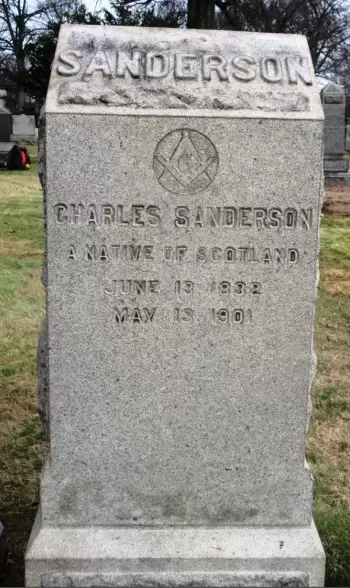
SANDERSON, JAMES MONROE (1817-1871). Lieutenant colonel and commissary of subsistence, 22nd Massachusetts Infantry. Sanderson was born in Maryland. Appointed to the United States Military Academy at West Point, New York, from Massachusetts, he received his commission in 1861 as a first lieutenant. He was assigned to the 22nd Massachusetts Infantry as first lieutenant and regimental quartermaster on September 4. Three days later, he was promoted to captain and commissary of subsistence. He was promoted to major on July 15, 1862, and made aide-de-camp. From January 1, 1863-June 6, 1864, he was lieutenant colonel and commissary of subsistence. After being dismissed on June 6, 1864, he was reinstated on May 27, 1865. On August 15, 1865, he was honorably discharged from service. His last residence was in London, England where he died of heart disease. Section 149, lot 20222.
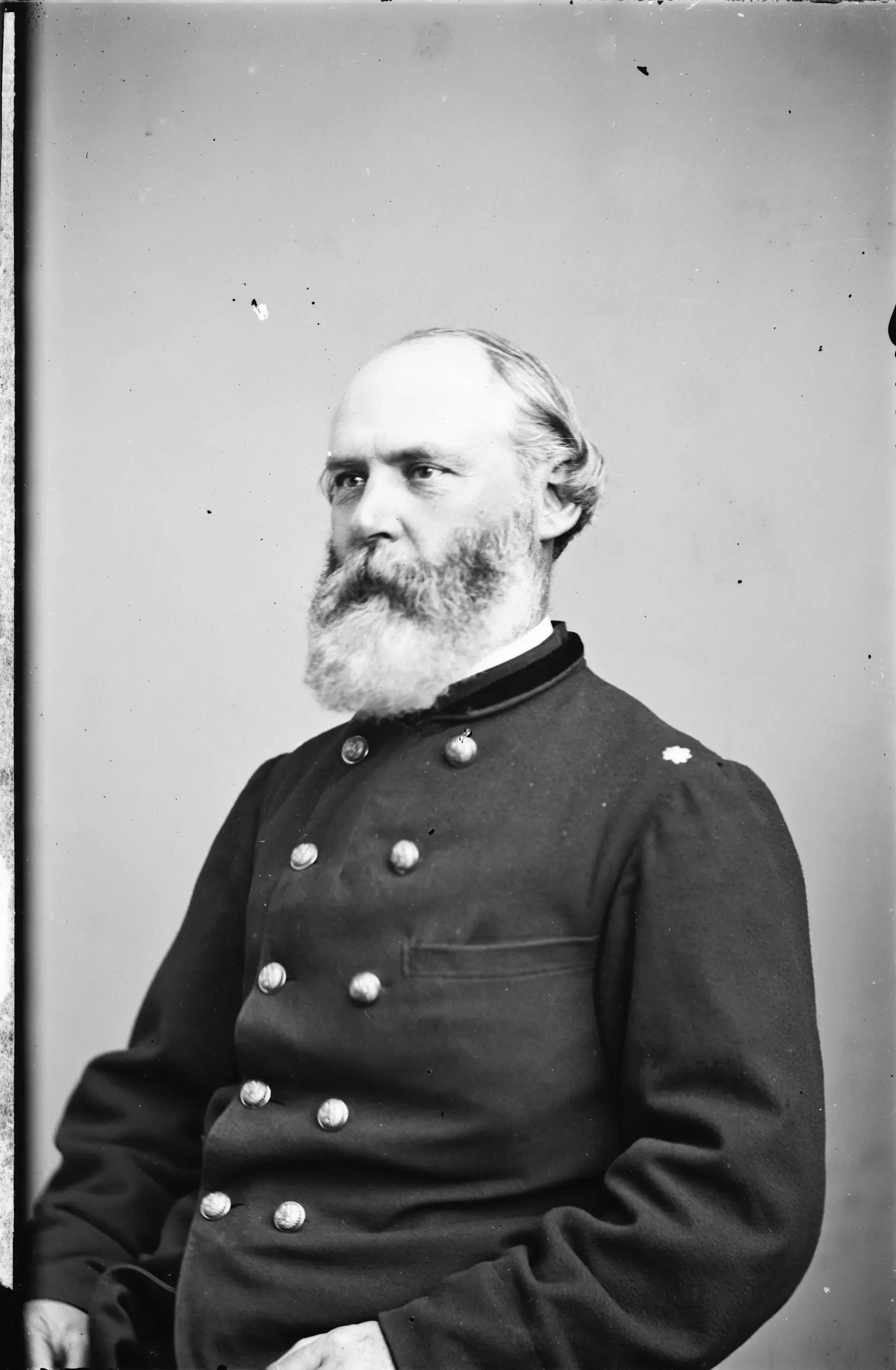
SANDFORD (or SANFORD), CHARLES WESLEY (1846-1914). Private, 8th New York Heavy Artillery, Company G; 4th New York Heavy Artillery, Battery F. A native of New York City, Sandford enlisted as a private at Baltimore, Maryland, on January 29, 1863, mustered into the 8th New York Heavy Artillery the next day, and was transferred into Battery F of the 4th New York Heavy Artillery on June 5, 1865. He mustered out on September 26, 1865, at Washington, D.C.
According to the 1875 New York State census, Sandford was living in Brooklyn, married with two young children and working as a shipping clerk. In 1891, Sandford’s application for an invalid pension was approved, certificate 838,165. The 1900 census reports that he was living in Brooklyn with his wife and three children. As per the census of 1910, he was living at 965 Greene Street in Brooklyn, had been married for 38 years, could read and write, and was employed as a bank clerk. Sandford’s last residence was 965 Greene Street in Brooklyn. His death was attributed to apoplexy. Shortly after his death in 1914, Rachel Sandford applied for and received a widow’s pension, certificate 780,992. Section 15/16, lot 17263, grave 1966.

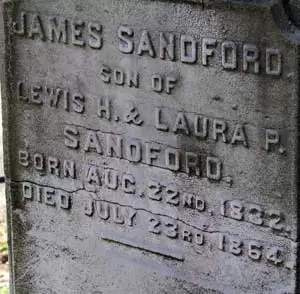
SANDFORD, JAMES (1832-1864). Captain, United States Volunteers Commissary Department. Born in New York State, Sandford enlisted on February 19, 1863, and was commissioned as a captain in the Commissary Department of the United States Volunteers. After his honorable discharge on January 23, 1864, he died in New Orleans on July 23, 1864. Section 92, lot 7394.
SANDS, JR., AUSTIN LEDYARD (1825-1877). Surgeon, Union Army. Originally from Philadelphia, Pennsylvania, he was a graduate of the University of the City of New York, 1844, and the College of Physicians & Surgeons, 1848. In 1861, Sands enlisted in the Union Army as a surgeon at Newport, Rhode Island, where he practiced medicine, and was discharged in 1863. A prominent figure in Newport, he was robbed and violently assaulted in 1876, left unconscious on the roadside, and according to his obituary in a Newport newspaper, was forced to retire from his profession as a result of the attack. (After a $3,000 reward was posted, a 21 year old, J. D. Mitchell, was arrested and after trial, sentenced to 20 years of hard labor.) Sands died of epilepsy in Cairo, Egypt, on December 19, 1877. He was buried in the 2nd Street Marble Cemetery in Manhattan before he was moved to the family vault at Green-Wood on August 22, 1878. Section 75, lot 10402.
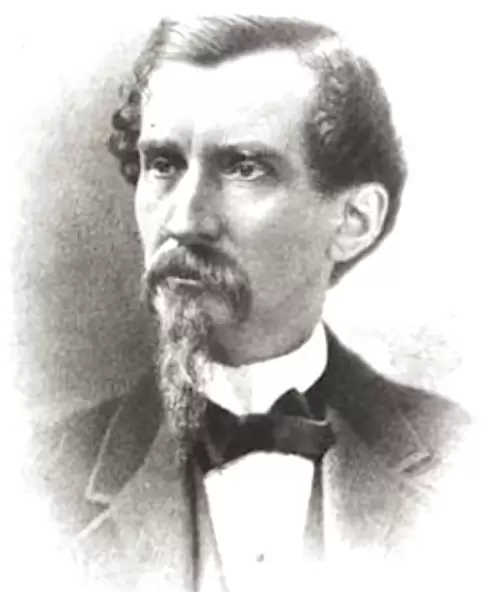
SANDS, JOHN (1842-1919). Unknown soldier history. Sands served during the Civil War and was a member of the G.A.R., Ulysses S. Grant Post #327, an association of veterans of that conflict. Details of his military career are not known. He last lived on Decatur Street in Brooklyn. Section 184, lot 18824.
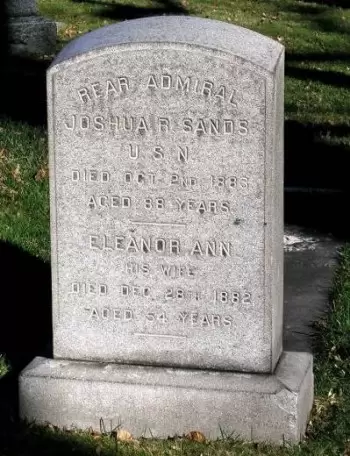
SANDS, JOSHUA R. (1795-1883). Rear admiral, United States Navy. Born in Brooklyn, Sands’ father was a personal friend of George Washington and a New York Congressman. When the War of 1812 broke out, he discarded his plan to begin Columbia College and instead entered the Navy as an acting midshipman on June 18, was subsequently commissioned a lieutenant in April 1, 1818, commanded the Vandalia in the Brazilian Squadron from 1828-1830, and rose to the rank of commodore on February 23, 1840. After he commanded a frigate to England in 1851 to bring exhibits to the World’s Fair, he returned with a diamond-encrusted gold snuff box presented to him by Queen Victoria which he gave to the Brooklyn Historical Society.
Sands became a captain on February 25, 1854. In 1857, while commanding the Susquehanna, he attempted to lay the first cable, an ultimately unsuccessful undertaking but one for which he was a presented a gold medal by Queen Victoria. After being stationed off the coast of Brazil, he served in the Navy as lighthouse inspector on Lakes Erie and Ontario and the St. Lawrence River from 1862, when he was again commissioned commodore, until 1866. He was promoted to rear admiral in 1866. After the Civil War, he was port-admiral at Norfolk, Virginia, from 1869 to 1872. His last residence was at 163 Landville Street in Baltimore, Maryland, but funeral services were at St. Ann’s Church at Clinton and Livingston Streets in Brooklyn. At the time of his death, from “old age,” he was the oldest admiral in the Navy. Section 170, lot 14646.
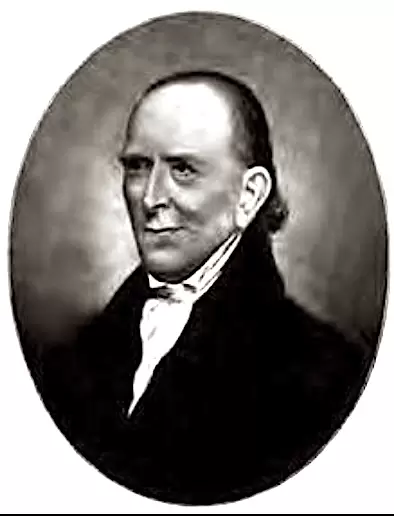
SANDS, WILLIAM PHOEBUS (1843-1912). Private, 23rd Regiment, New York State National Guard, Company H. Sands served with the 23rd Regiment for 30 days in 1863. He last lived on Claremont Avenue in Verona, New Jersey. He died of cancer of the rectum. Section 148, lot 21158, grave 4.
SANFORD, EDWARD SEWALL (1817-1882). Brigadier general by brevet; colonel, United States Volunteers. Born in Medway, Massachusetts, his father was a clergyman whose roots could be traced to an old New England family. Sanford entered the express business in 1842 as an agent in New York, then superintended operations in Washington and Philadelphia. By 1854, he was on the Board of Directors of the Adams Express Company and, by the onset of the Civil War, headed the American Telegraph Company. During the Civil War, he enlisted on February 26, 1862, and was commissioned into the United States Volunteers as colonel and additional aide-de-camp. He also served as a military supervisor of telegraphic messages, reflecting his expertise and leadership in his civilian work. During the Draft Riots in New York City from July 13-18, 1863, he sent a series of telegraphs to Secretary of War Edwin Stanton outlining the calamitous situations and need for additional forces to quell the situation. At the time, there were also riots in Boston and Troy, New York, which Sanford referred to in his communications. Some of his entreaties in the Official Report (Series 1, Volume XXVII/2) follow:
(July 13, 1863, 9:30 p.m.) SIR: …The situation is not improved since dark. The programme is diversified by small mobs chasing isolated negroes as hounds would chase a fox. I mention this to indicate to you that the spirit of mob is loose, and all parts of the city pervaded. The Tribune office has been attacked by a reconnoitering party, and partially sacked. A strong body of police repulsed the assailants, but another attack in force is threatened. The telegraph is especially sought for destruction. One office has been burned by the rioters, and several others compelled to close. The main office is shut, and the business transferred to Jersey City.
In brief, the city of New York is to-night at the mercy of a mob, whether organized or improvised, I am unable to say. As far as I can learn, the firemen and military companies sympathize too closely with the draft resistance movement to be relied upon for … extinguishment of fires or the restoration of order. It is to be hoped that to-morrow will open upon a brighter prospect than is promised to-night.
Stanton’s reply:
SIR: Your telegram of 9.30 just received. Please report to me immediately–1st. Whether any and what military force has been called out or employed by the city authorities or the drafting officers. 2d. What amount of injury has been done, so far as you know, to persons and to property. 3d. What measures, if any, have been taken by military or police authority to quell the riot.
Sanford’s telegraphs express his growing concern about the situation:
SIR: It was impossible to answer your questions fully. I gave you such information as I could get at headquarters. Several conflicts have taken place to-day, with more serious results than those of yesterday, which were principally confined on the side of the police to severe injuries. Three arsenals were attacked to-day by the rioters. At two points they were repulsed. At the third they were successful, and obtained possession of the arms, which were recaptured by the marines and regulars.
This morning nearly all the manufactories were visited by delegations from the rioters, who compelled the men to stop, work. This adds to the number and somewhat to the strength of the mob. The mayor has turned over his power and forces to Governor Seymour, who is about issuing a proclamation. Have sent to headquarters for statement of facts, as far as known, and will forward immediately on reception. An immense crowd has gathered around the Evening Post office since I commenced this message. As yet they are undemonstrative. General Wool’s message has arrived, but gives no further information. Will try my own resources. My opinion is that one good regiment of native-born troops, well commanded, arriving here by 12 o clock to-night, would save the assay office, sub-treasury, and other Government property.
(JULY 14)Hon. E. M. STANTON, Secretary of War.
SIR: Have seen General Wool. All the military which he can reach has been called for, but it now numbers only about 800 troops. These are aided by nearly 2,000 police. Governor Seymour has arrived, and General Wool reports him as co-operating heartily. He has called out several regiments, and General Wool has sent to New Jersey for two regiments; but, as far as I can see, the means of defense are entirely inadequate to control the present force of rioters.
The military had a collision with the mob in Thirty-fourth street an hour ago, and used ball-cartridge. Result not reported. The rioters are now (12 o’clock) in possession of Mayor Opdyke’s house, and destroying it.
The chances appear to me to be against the immediate restoration of order in the city of New York. Will keep you advised of situation.
July 14, 2:40 p.m. to Stanton
SIR: You may judge of the capacity at headquarters here when every effort cannot extract any more information than I have forwarded. Excuse me for saying that this mob is testing the Government nearly as strongly as the Southern rebellion. If you cannot enforce the draft here, it will not be enforced elsewhere. The example will prove contagious, and similar events transpire in every large city. If you send sufficient force here to demonstrate the power of the Government, its effect will reach every part of the country, and one settlement answer for the whole. Immediate action is necessary, or the Government and county will be disgraced.
Stanton replied that evening to Sanford:
SIR: The Government will be able to stand the test, even if there should be a riot and mob in every ward of every city. The retreat of Lee’s army, now in a rout and utterly broken, will leave an ample force at the disposal of the Government.
Sanford, worried that order could not be restored, continued to telegraph Stanton:
July 15 at 3 p.m. SIR: …Have just returned from headquarters. Saw General Wool and Governor Seymour. The latter informed me that he had heard of organizations at Newark and Jersey City to prevent the passage of troops, and requested me to inform the Seventh Regiment. I learn from Philadelphia that this regiment will not reach there till 4 o’clock, which will make it due here about to-morrow morning. There does not seem to be any one here who is attending to these matters. Some one should superintend the transportation. If troops are to come in any numbers, all the equipments of the roads should be put on the Amboy line, which can be easily guarded, and boats enough sent from here to Amboy. The troops can land from on board boats at any desired point, and under cover of gunboats, if necessary. The situation does not appear to me to improve. There are indications of riotous organizations at all points from which we hear. The settling place is New York, and, once determined here, all is fixed.
July 15 at 3 p.m. SIR: The following message just received from the manager of our Boston office. It came from New Rochelle by horse-power, our lines up to that point being destroyed. There was a considerable riot last night at Staten Island, and there are indications of outbreaks at Brooklyn and Williamsburg:
July 15, at 9:15 p.m. SIR: The situation of affairs here is quite as critical this morning as at any former time. As far as I can learn, there has not yet been much serious fighting, but the rioters are gathered in large crowds at various points, and for the first time making their appearance down town in the back streets. Whatever assistance is to come here, should have precedence over all other railroad arrangements.
Sanford telegraphed on July 16 that the situation had improved. One of several communications relayed the following:
SIR: The situation is evidently improved. Cars and omnibuses are running. The Hudson River Railroad has been relaid, and trains have come in and gone out without molestation. Laborers have resumed work at various points, and the lower part of the city presents its usual appearance.
The fighting last night was quite severe. At one time the mob had the best of it, and possession of our dead and wounded, including 2 officers of the Duryea Zouaves, killed, and Colonel [Edward] Jardine [see], severely wounded. General Brown sent all the force at his disposal. He retook the position, and brought off the dead and wounded. There were killed in this contest about 15 of our men and about 25 of the rioters. The mob were armed, organized, and fired at the word of command.General Brown has now, including the Seventh Regiment, about 1,400 men under his command. He thinks the force for his special purposes should be increased to 3,000. It is impossible to ascertain how many troops there are here, owing to the conflict of authority under which each officer will report those belonging to himself and all the others. Yesterday one officer received, at nearly the same time, five conflicting orders from as many commanders-in-chief. There is no danger of getting too many troops here of the right kind. The indications, to my mind, are that the rioters are resting and organizing. They have got arms to a considerable extent, and use them pretty well. The agrarian mania has taken a strong hold of a certain class, and the cry of contrast between rich and poor is loudly raised. Every city and town that we hear from is effervescing. Philadelphia seems the most quiet, but, if once started, will be the most dangerous.
I have taken care that all press dispatches which went out this morning conveyed the right impression. The strong hand tightly grasped here will be felt all over the Union. When you have given us a leader, and he has 10,000 men at his command, the country will be safe.
Sanford wrote on July 17:
SIR: Police Commissioner [Thomas C.] Acton reports that in a fight last night near Gramercy Park, the soldiers got the worst of it, and were driven back, leaving one of their number killed. Captain Putnam, of the regulars, started with two companies, and thoroughly routed the rioters, killing from 15 to 25, taking 16 prisoners, and bringing off the body of the sergeant, which was left at the first fight.
Police Commissioner Acton desires to make a special request for the promotion of Captain Putnam, Company F, Twelfth U.S. Infantry, this being the second time that he has encountered and overcome the rioters after they had gotten the better of our troops under other officers.
No disturbance has occurred this morning in any part of the city.
Stanton acknowledged the gallantry of the New York City police and in a final communication on July 18, Sanford wrote:
SIR: The plunder rioting is suppressed for the present, but there are strong indications of a formidable and widespread organization to resist the taking away of conscripts under the draft. This organization assumes a party aspect, and extends to the military of the city who are subject to draft. The party supposed to be most interested in sustaining the Government and draft, and the property-holders, show no intention to prepare for the emergency or to fight when it comes.
I give you this information, obtained by personal observation, to enable you to appreciate the position, and trust you will not consider it officious.
On March 13, 1865, Sanford was brevetted to brigadier general of volunteers for meritorious service. He resigned from the Army in April 1867. Returning to his business, he became a director of Western Union when his firm was absorbed by that company and also served as a director of The International Ocean Telegraph Company. In addition, he held mining interests in Nova Scotia, Canada. A resident of Brooklyn, he died of apoplexy in Delaware County, Pennsylvania. Section 66, lot 419.
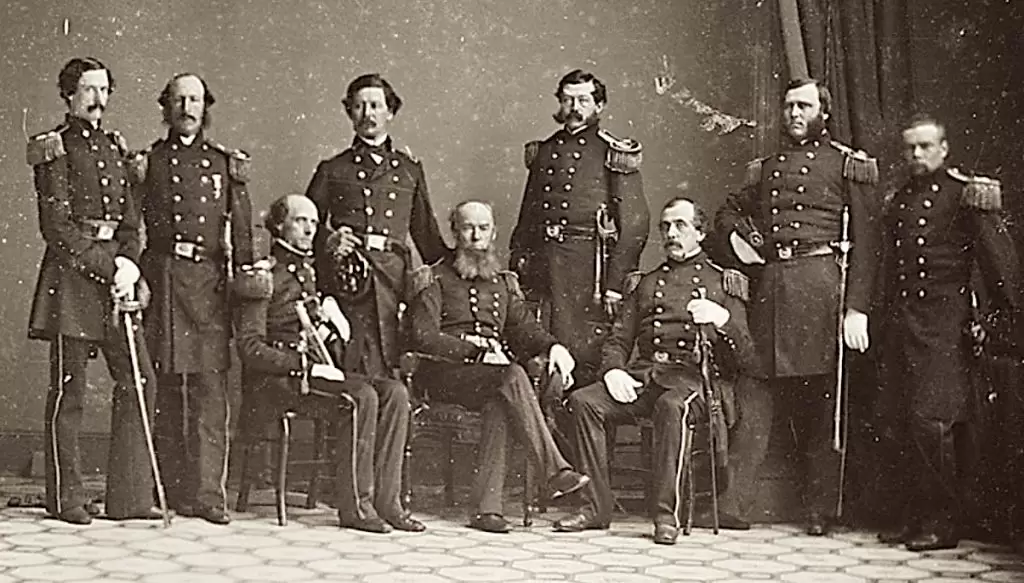
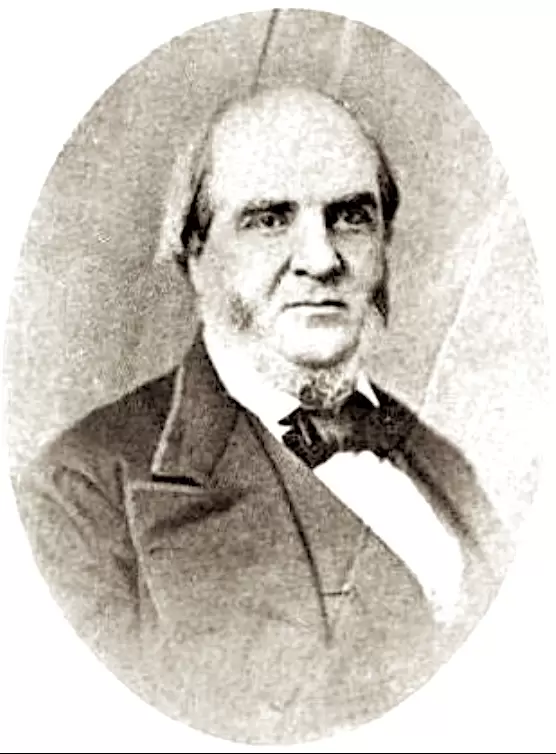
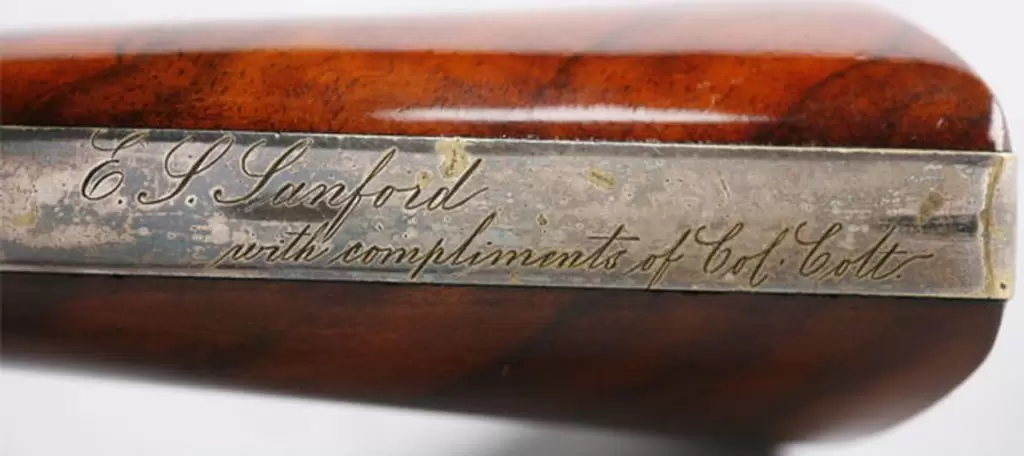
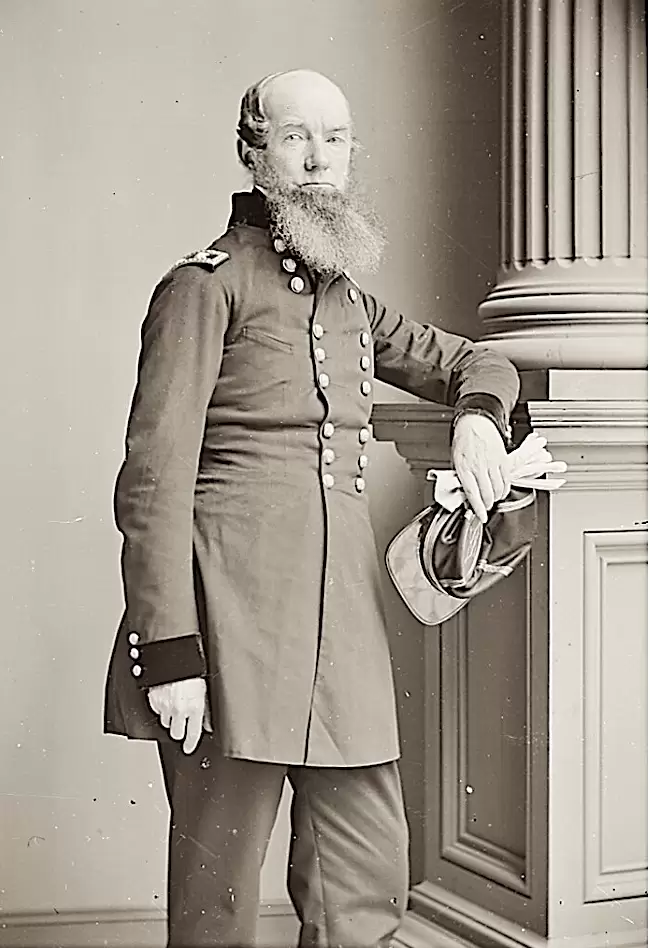
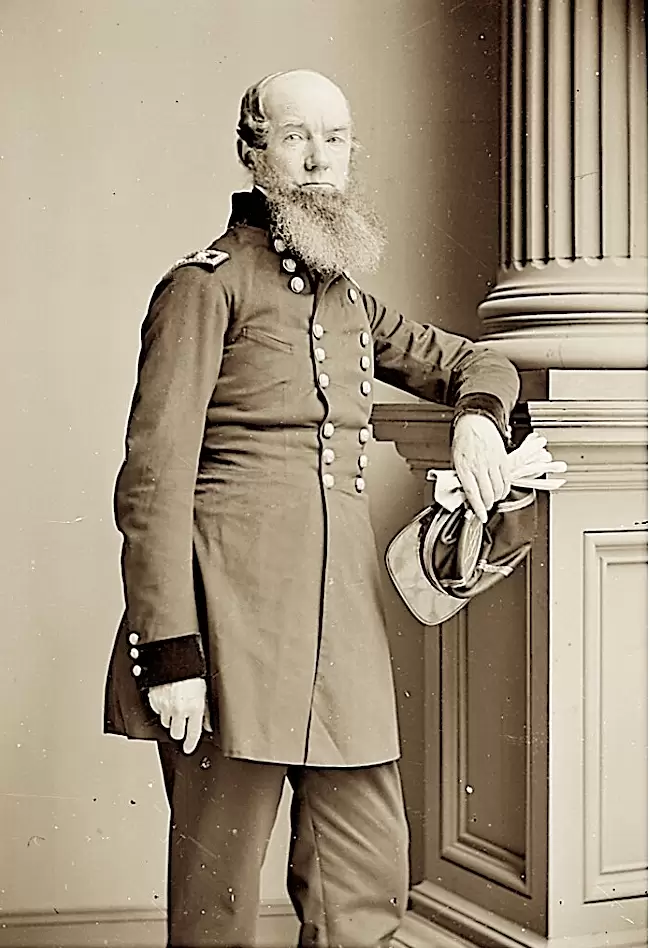
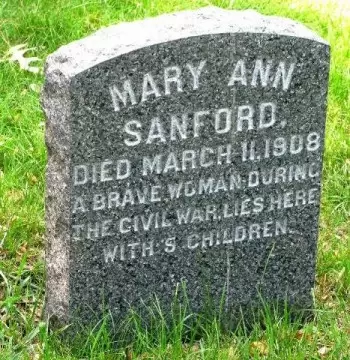
SANFORD, MARY ANN (1832-1908). Civil War laundress and nurse. A native of Ireland, Sanford was born Mary Ann McCauley and married her second husband, John B. Sanford, in 1859. According to her obituary in The New York Times, Mary Sanford was honored for her loyalty to the Union after she followed her husband to the front during the Civil War and was with him during all the battles in which the 5th New York Volunteer Infantry, Duryée’s Zouaves, participated, including Virginia engagements at Cedar Mountain, Thoroughfare Gap, Second Bull Run, and Chantilly. She nursed wounded soldiers at Antietam, Maryland, although she had accompanied the men of the 5th as a laundress. There are no soldier records of a John B. Sanford having served in the 5th New York.
She married for a third time in 1879 but by 1880 she was living as Mary Sanford with her two sons. Sanford’s health declined after she slipped on an icy sidewalk in 1905 and broke her hip. She last lived at 443 West 53rd Street in Manhattan but after she failed to recover from her accident she was admitted to State Hospital on Ward’s Island where she spent the last two years of her life; her death was attributed to senility.
Many soldiers and women who were members of patriotic groups attended Sanford’s funeral which was arranged by men from the Grand Army of the Republic (G.A.R.). Her funeral was held at St. Stephen’s Episcopal Church on 69th Street in Manhattan through the efforts of a friend, Mrs. Henry Andrews, whose father-in-law was the governor of Massachusetts during the Civil War. Mrs. Andrews laid the colors on Sanford’s gravesite during the service at Green-Wood. Her obituary notes that there were no surviving members of the Duryée Zouaves left to follow her body to her grave. She is interred in a grave with four other individuals, all of whom had a last name of McCarty; her first husband James McCarty, died in 1857. Her tombstone bears the inscription, “A brave woman during the Civil War lies here with 5 children.” However, the information on her tombstone is incorrect: she only had four children as per the census of 1900 and it is likely that she is buried with only three of them. Section 127, lot 8899, grave 219.
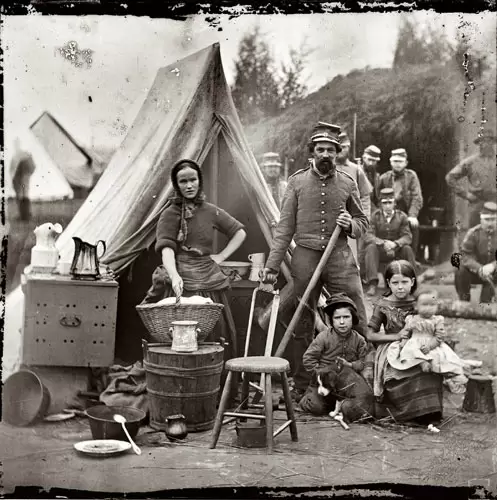
SANFORD, WILLIAM WILSON (1834-1882). Colonel, 48th Illinois Infantry. Sanford, a resident of St. Louis, Missouri, enlisted and was commissioned as major in the 48th Illinois on August 18, 1861. Colonel William Wallace, the commanding officer of the Second Brigade, wrote of his gratitude to Sanford in his field report of February 17, 1862, describing the events from February 11-16 as troops marched from Fort Henry to Fort Donelson, Tennessee. To appreciate the astounding victory, “…it must be borne in mind that they marched from Fort Henry without transportation or tents or rations except what they carried; that they were exposed for three days and nights without tents and almost without fires-being so near the enemy’s lines as to render fires imprudent; that the weather was extremely severe, two nights they were thus exposed being accompanied with driving snow-storms and severe cold; that during the whole three days that they were under fire, and were compelled to bivouac in line of battle with their arms in their hands; added to this, most of them had never seen a battle, and but few had ever heard a hostile shot.”
Sanford was promoted to lieutenant colonel on February 16, 1862, was wounded on April 6, 1862, at Shiloh, Tennessee, and rose to colonel on November 21 of that year. On July 19, 1863, Brigadier General William Sooy Smith, United States Army, wrote from Jackson, Mississippi, and commended Sanford for his daring noting that the gallant officers, “…dashed forward under a heavy fire of artillery and small arms, and captured rebel prisoners under their very guns.” He resigned on January 18, 1864. He last lived in St. Louis, Missouri where he died of heart disease. Section 119, lot 699.
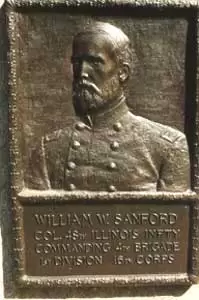
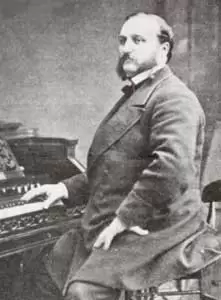
SANKEY, IRA DAVID (1840-1908). Sergeant, 22nd Pennsylvania Infantry, Company B; private, 12th Pennsylvania Infantry, Company H. Born in Edinburg, Pennsylvania, Sankey’s family taught him music and sacred songs at an early age. He became choir leader and superintendent of the Methodist Sunday School in Newcastle, Pennsylvania. When the Civil War began, he enlisted on April 25, 1861, mustered into the 12th Pennsylvania Infantry as a private, and mustered out after three months on August 5, 1861, at Harrisburg, Pennsylvania. He re-enlisted as a sergeant on September 16, 1862, served in the 22nd Pennsylvania, and mustered out on September 29, 1862, at Harrisburg. During his time in the military, he assisted the chaplain and led fellow soldiers in religious singing.
After spending some time with the Internal Revenue Service, Sankey met Dwight L. Moody, a renowned evangelist, at the 1870 Y.M.C.A. Convention in Indianapolis, Indiana, and for many years they conducted extraordinary evangelical meetings throughout the United States and Europe. Collections of the hymns such as “The Ninety and Nine,” “Hold the Fort,” “When the Mists have Rolled Away,” “Pull for the Shore Sailors,” and “Sweet Bye and Bye” were popular worldwide; profits from their sale went primarily to the Northfield School which Moody established. In 1906, Sankey’s biography, My Life and the Story of the Gospel Hymns, was published. He spent the last years of his life, blind from glaucoma, at his home at 148 South Oxford Street in Brooklyn. His death was attributed to nephritis. His hymns were sung in Sunday schools for many years after his death. In 1980, the Gospel Music Association added his name to the Gospel Music Hall of Fame. Section 125, lot 30550.
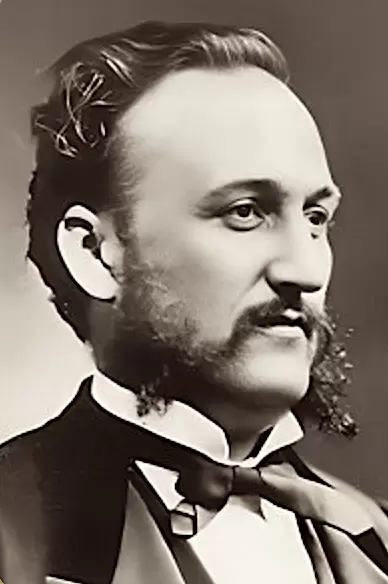
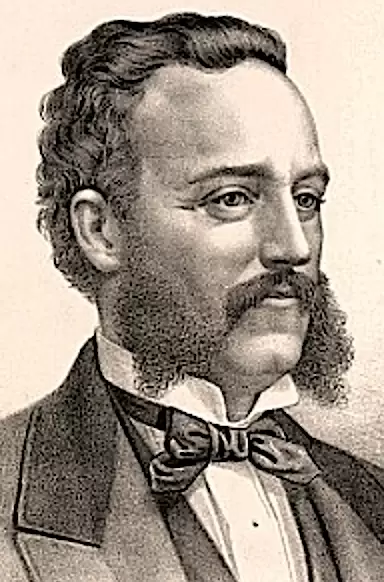
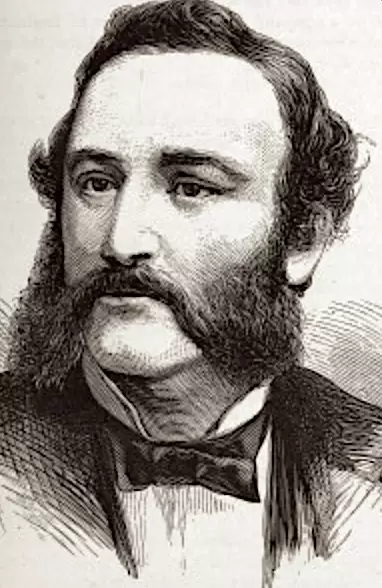

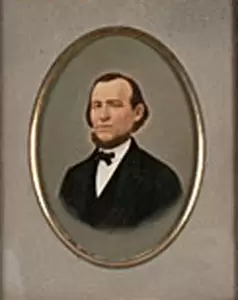
SANTOIRE, RONUALD SAMUEL (or R. SAMUEL, SAMULE) (1841-1923). Surgeon, United States Volunteers Medical Department; acting assistant surgeon, 25th Army Corps, United States Army; 38th United States Colored Troops (USCT). Born in Canada, Santoire’s ancestry can be traced to 17th century French nobility. During the Civil War, he enlisted as a medical cadet in June 1864 at Mount Pleasant Hospital in Washington, D.C., and was appointed acting assistant surgeon, United States Army, assigned to the 25th Army Corps, Army of the James. Subsequently, he was commissioned into the Field and Staff of the 38th United States Colored Troops (USCT) as an acting assistant surgeon. His first contract was from November 26, 1864-October 21, 1865, the second from February 25, 1867-July 10, 1868. He also served as a surgeon in the Medical Department of the United States Volunteers. During October and November of 1865, he suffered from exposure at White’s Ranch in Brownsville, Texas, resulting in rheumatism. In 1866 and 1867, he treated soldiers who had cholera and yellow fever ultimately contracting yellow fever leading to his leaving the Army due to disability on July 1, 1868.
In 1869, Santoire graduated from the College of Physicians and Surgeons, Victoria University of Canada, and practiced medicine in Brooklyn beginning in June of that year. His application for an invalid pension was granted in 1894, certificate 912,261. An article in the Brooklyn Daily Eagle on November 14, 1897, about the death of his 20 year-old son, Edgar Norman who was a student at Yale Law School, confirmed Santoire’s Civil War service and stated that he belonged to the Ulysses S. Grant Post #327 of the G.A.R.; his G.A.R. membership is also noted Dr. Santoire’s obituary in the same newspaper.
A human interest story in the New York Herald on June 28, 1893, reports that Santoire and his wife were rescued by a stage coach driver when his own horse and buggy sunk in marshland in Flatlands, Brooklyn. On a narrow road, Santoire moved his carriage to allow another buggy to pass when his horse quickly floundered necessitating the rescue of the couple and their horse; the coach driver was admonished by his boss for not tending to his business. As per his obituary in the New York Evening Telegram, he was a member of the Kings County Medical Association and the Brooklyn Pathological Society. His name is displayed as Samuel Santoire on the African American Civil War Memorial in Washington, D.C., plaque C-53. He last lived at 61 Westminster Road in Brooklyn. Section 203, lot 32800, grave 3.
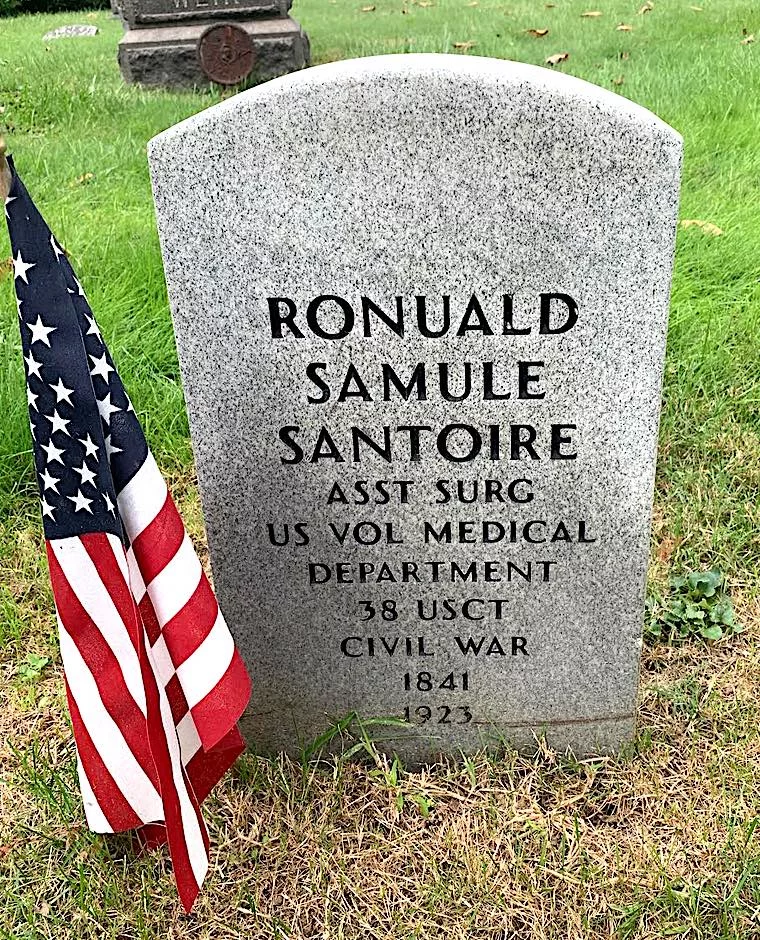
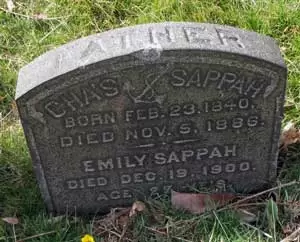
SAPPAH, CHARLES (1840-1886). Steward and civilian cook, United States Revenue Cutter Service. A native of the East Indies, Sappah first served in the U.S. Revenue Cutter Service as a steward on the Stevens, a steamer, also known as the Naugatuck. He enlisted on March 12, 1862, and was discharged on August 31 of that year. At the time of his service on the Stevens, the Revenue Cutter Service was not officially cooperating with the United States Navy; a Presidential order was issued during the Civil War authorizing cooperation but that occurred after Sappah’s discharge.
Subsequently, Sappah returned to the Revenue Service as a civilian cook as of January 17, 1864, at which time he was assigned to the Planet, a steamer. On March 10, 1864, he took ill and an honorable discharge was requested, citing rheumatism. Sappah was discharged nine days later.
According to the census of 1880, he was a sailor. Caroline Sappah, his widow, applied for a pension from the Navy, application 9024, but it was rejected. A document, dated May 5, 1904, from the War Department, requesting information about his service during the Civil War, states he was a civilian cook, paid $35 per month, from January 17 through March 18, 1864. The official rejection for the pension indicated that the USRC Stevens was not in cooperation with the Navy at the time of Sappah’s service; the President’s order for cooperation was issued later. Because Sappah’s service on the Planet was as a civilian, his widow was not entitled to a pension. The cause of his death was attributed to “thoracic.” Section 3, lot 21025.
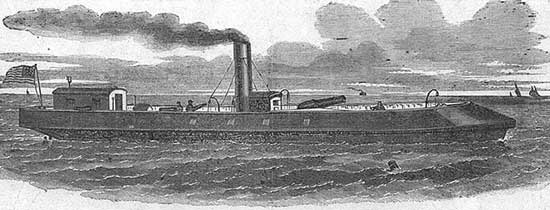
SATTERLEE, LIVINGSTON (1840-1902). Lieutenant colonel, 12th Regiment, New York State National Guard. A native of New York City, Satterlee became involved in the military when he raised a unit called the “Brown University Guards” when he was a student at Brown University in Providence, Rhode Island. He then joined the 7th New York in 1859. On January 5, 1860, he was elected a member of Company A of the 12th Regiment and became its assistant paymaster on January 25 and its paymaster in April 1861. On June 3, 1862, he was commissioned lieutenant colonel, then served with the Field and Staff of the 12th Regiment’s National Guard when it was activated the next month on June 29, and mustered out on October 8 at New York City. When the regiment was reactivated the next year for 30 days, he was commissioned in on July 6, 1863, and mustered out on July 20 at New York City. He was promoted to brigadier general of the 12th on September 1, 1865.
The New York City Directory for 1877 lists Satterlee as an agent at 171 Broadway. According to his obituary in The New York Times, he was president of Zeta Psi fraternity in the United States and Canada, an international fraternal organization that began in 1847 to promote leadership and life-long friendship, and was a 33rd degree Freemason. As per his obituary in the New York Herald, he was a member of the Old Guard Association of the 12th Regiments; comrades of that organization were invited to attend his funeral. He last lived at 2 West 103rd Street in New York City. He succumbed to phthisis (tuberculosis.) Section 50, lot 9133.
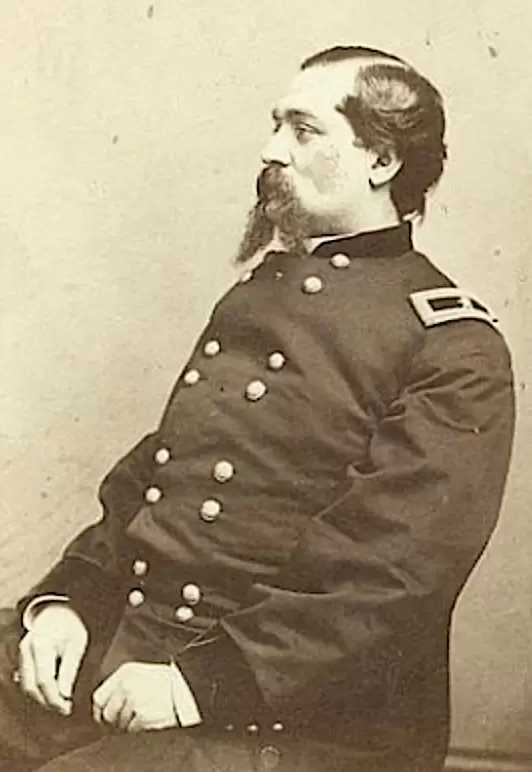
SAUER, ADAM (1813-1870). Private, New York Enfants Perdus, Company F. Of German birth, Sauer enlisted at age 43 as a private at New York City on February 10, 1862, mustered into the Enfants Perdus that day, and deserted on April 16, 1862, at New York City. His last residence was in Hudson City, New Jersey. His death was caused by phthisis. Section 126, lot 16373, grave 28.
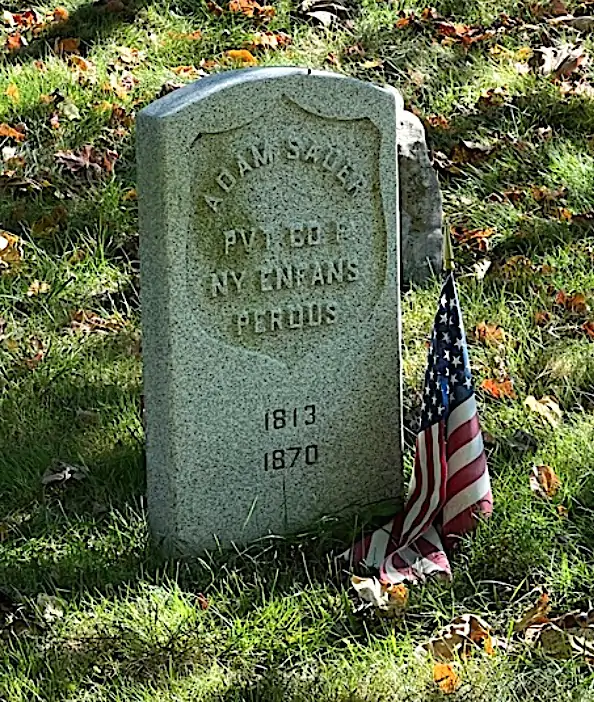
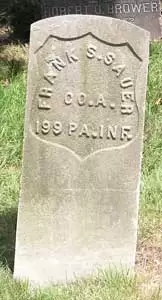
SAUER, FRANK (1845-1899). Private, 199th Pennsylvania Infantry, Company A. He enlisted and mustered into the 199th Pennsylvania on August 17, 1864. On June 28, 1865, he mustered out at Richmond, Virginia. His last residence was 460 14th Street in Brooklyn. Sauer died of nephritis. Section 135, lot 30010, grave 535.
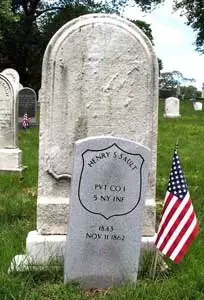
SAULT, HENRY S. (1843-1862). Private, 5th New York Infantry, Company I. Born in England and a cabinet-maker by trade, Sault resided in New York City when he enlisted there on April 25, 1861. On May 9, he mustered into the 5th New York. He was wounded in the left hip and pelvis and captured at the Battle of Second Bull Run, Virginia, on August 30, 1862, paroled two days later, admitted to Ryland General Hospital on September 2, and died from his injuries at Grace Church Hospital, D.C., on November 11, 1862. A government-issued gravestone was ordered for him early in the 20th century. Section 115, lot 13536 (Soldiers’ Lot), grave 48.
SAUNDERS, GEORGE F. (1839-1900). Private, 7th Regiment, New York State National Guard, Company A. Saunders was born in New York. During the Civil War, he enlisted as a private on June 3, 1861, mustered into Company A of the 7th Regiment and mustered out with his company after 30 days. On June 19, 1862, he mustered into Company A of the 7th Regiment for another 30-day activation. Subsequently, he returned to the 7th Regiment for its 30-day activation in 1863.
At the time Saunders mustered into the Farragut Post #75 of the G.A.R. on February 14, 1887, he lived in New York City and was in the real estate business. As per his obituary, which confirms his Civil War service, Saunders had worked for the customs service of the United States for twenty-five years and, at the time of his death, was a district inspector. In addition, he was a Freemason. He last lived with his brother-in-law at 380 Bergen Street in Brooklyn. His death was caused by nephritis. Section 73, lot 2342.
SAUNDERS, JR., FREDERICK (1835-1925). Private, 14th New York Cavalry, Company H. Saunders enlisted as a private at New York City on February 24, 1863, mustered into the 14th Cavalry on March 28, and deserted on April 7 from the recruiting service. His last residence was on Sterling Place in Brooklyn. He died of apoplexy. Section 187, lot 19996, grave 2.
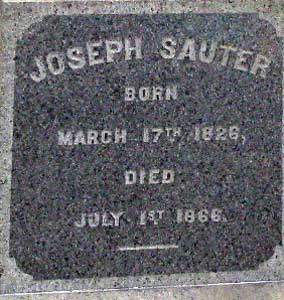
SAUTER, JOSEPH (1826-1866). Private, 68th New York Infantry, Company F. Of German birth, he enlisted as a private at New York City on August 1, 1861, and mustered into the 68th New York on August 10. On or about September 15, 1863, Sauter was listed as missing and rejoined the regiment on or about December 15 of that year. He was discharged from military service on August 22, 1864. His last residence was 263 Sixth Avenue, Manhattan. Section 36, lot 16819.
SAVAGE, EDWARD (1821-1896). Lieutenant colonel, 3rd North Carolina, Infantry, Company D, Confederate States of America. A native of Wilmington, North Carolina, Savage married Maria Teresa Fernandez in 1848; she was the eldest daughter of the Marquis de La Esperanza of Puerto Rico. The 1850 census reports that he lived in Wilmington, North Carolina (New Hanover County), and was a merchant. His obituary in the Wilmington Messenger notes that he was the first foreman of Howard Relief Steam Fire Engine Company #1 and was a member of the New York City commission house, Anderson & Savage, at the onset of the Civil War.
During the Civil War, Savage, a resident of Wilmington, New Hanover County, North Carolina, enlisted as a captain on an unknown date and was commissioned into Company C of the 3rd North Carolina Infantry, a company that he raised, on May 16, 1861. On July 20, 1861, the 3rd North Carolina was officially mustered into Confederate service for three years or the duration of the war. In February 1862, Savage was with his regiment at Camp Price in Aquia Creek, Virginia. At that time, as captain of Company D, he requisitioned 645 pounds of straw for his company. He swore, upon his honor, on March 22, 1862, that during his regiment’s movements from Camp Price to Goldsboro, North Carolina, his regiment had lost 12 axes, 4 hatchets, 2 pickaxes, 2 pickaxe handles, and 11 tents. On April 26, 1862, he rose to major of the regiment and was transferred to the Field and Staff.
Savage was severely wounded in the hand on June 26, 1862, at Ellerson’s Mill (also known as the Battle of Mechanicsville), Virginia, “in front of Richmond,” as per his muster roll, during the Peninsula Campaign. Savage then rose to lieutenant colonel of the 3rd on July 1. According to his muster roll, he was home in Wilmington, North Carolina, from July 14 through October 31, 1862, after his wounding at Mechanicsville. On August 25, 1862, from Wilmington, North Carolina, he submitted his resignation, citing that “physical inability to properly discharge the duties of my office compel me to tender my resignation of the same.” He was paid a total of $170 per month for his service as lieutenant colonel of the 3rd North Carolina for July, August and September 1862. On October 9, 1862, a Confederate surgeon found him unfit for military service as a result of his wound. He was paid $396.66 (at $70 per month) for his service from October 1 through December 10, 1862, and was reimbursed $32.20 for forage (grass or hay) for his horse at $8 per month; he signed that the payment was “accurate and just.” His resignation was officially accepted on December 10, 1862. His discharge paper, signed by Confederate General Robert E. Lee, is below.
In addition to his military role in the Civil War, Savage was associated with the depositories that handled currency and implementation of monetary policies for the Confederate States of America. As per Dr. Enrico Aidala in “Depositories at the Port of Wilmington, North Carolina” in Paper Money, the journal of the Society of Paper Money Collectors (September/October 2019, Volume LV111, pp. 343-348), Wilmington became one of the most valuable blockade-running ports after the fall of New Orleans, Louisiana, and Norfolk, Virginia, in the spring of 1862; weapons, food and clothing came into Wilmington on blockade runners, making it the main Confederate port on the Atlantic Ocean. However, yellow fever decimated Wilmington in the summer and fall of 1862; one of its victims on October 7 was James T; Miller, the collector of the Port of Wilmington and the chief custom official of the depository. Three days after Miller’s death, George Davis, senator from North Carolina (CSA), wrote to the CSA’s Secretary of the Treasury, Christopher Gustavus Memminger, recommending Savage to fill the post as port director and depositary. Savage received the appointment; his position charged him with handling currency and implementing monetary policy of the CSA.
His obituaries in the Wilmington Messenger and Wilmington Evening Star, which confirm his military service in the Confederate States of America, validate that he was a collector at the port of Wilmington, North Carolina, after his resignation. In that capacity, he first hired his brother, Henry Russel Savage, who had served as captain of Company G of the 18th North Carolina Infantry, CSA, to work for him at the depository on December 30, 1862. That appointment was considered nepotism by Memminger, the Confederate Secretary of the Treasury, and a clerk was hired to perform those duties instead of Savage’s brother. After about five or six months as a treasury agent, Savage gave up that job and left Wilmington, North Carolina, on about April 13, 1863, for Europe on government business as an agent for the Confederate War Department. As per Aidala’s article, his brother Henry succeeded him as collector and depositary from April 1, 1863 until early 1865. Henry Savage abandoned his office in Wilmington on January 17, 1865, after the fall of Fort Fisher and was in Raleigh until the end of the Civil War. While monetary notes have Edward Savage’s stamp, only notes with Henry Savages’s signature have been found.
Savage relocated to New York City after the Civil War, selling his Wilmington house to his brother in 1868. As per the 1880 census, he lived with his wife and son at 118 West 123rd Street in New York City and worked as a bookkeeper. As per his passport application of March 1886, he was 5′ 6″ tall with brown eyes, gray hair, high forehead, prominent nose, bearded chin, fair complexion, medium mouth and oval face. He last lived at 244 West 173rd Street in Manhattan. His death was attributed to heart disease. Section 58, 19465, grave 9.
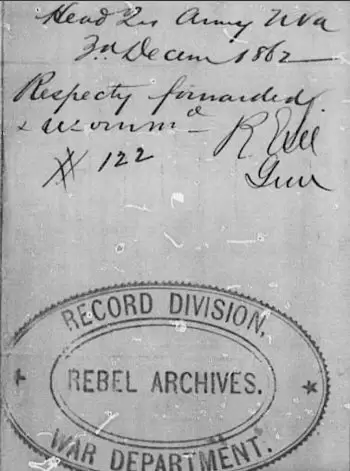
SAWYER, FREDERICK A. (1841-1908). Lieutenant colonel by brevet; major, 100th New York Infantry; captain, 47th New York Infantry, Companies K, A, and B. Sawyer enlisted at New York City as a second lieutenant on May 13, 1861, and was commissioned into Company K of the 47th New York on December 16, 1861. On June 18, 1862, his commanding officer, Brigadier General Horatio G. Wright, United States Army, acknowledged him, the acting brigade commissary, in his field report from James Island, South Carolina, for “prompt and satisfactory discharge of duties” at the engagement at Secessionville, South Carolina. After he was promoted to first lieutenant effective upon his transfer to Company A on April 1, 1863, he rose to captain and transferred to Company B on December 7, 1864.
In a letter to headquarters from the field in Virginia, on April 11, 1865, Brigadier General R. S. Foster, describing the action of the past 15 days noted that, “Captain F. A. Sawyer, assistant commissary of musters, of my staff, has displayed unusual energy and ability with conspicuous gallantry, and well deserves to be brevetted…” On July 7, 1865, he was commissioned into the 100th New York Infantry as a major, and mustered out at Richmond, Virginia, on August 28, 1865. He was brevetted major “for gallant and meritorious service” to date from March 13, 1865. On September 18, 1865, he was brevetted lieutenant colonel “for gallant and meritorious services during the campaign terminating with the surrender of the insurgent army under General R. E. Lee.” A resident of Garden City, New York, he died of angina pectoris in London, England, on November 27, 1908, and was interred at Green-Wood on February 3, 1909. Section 3, lot 2682.
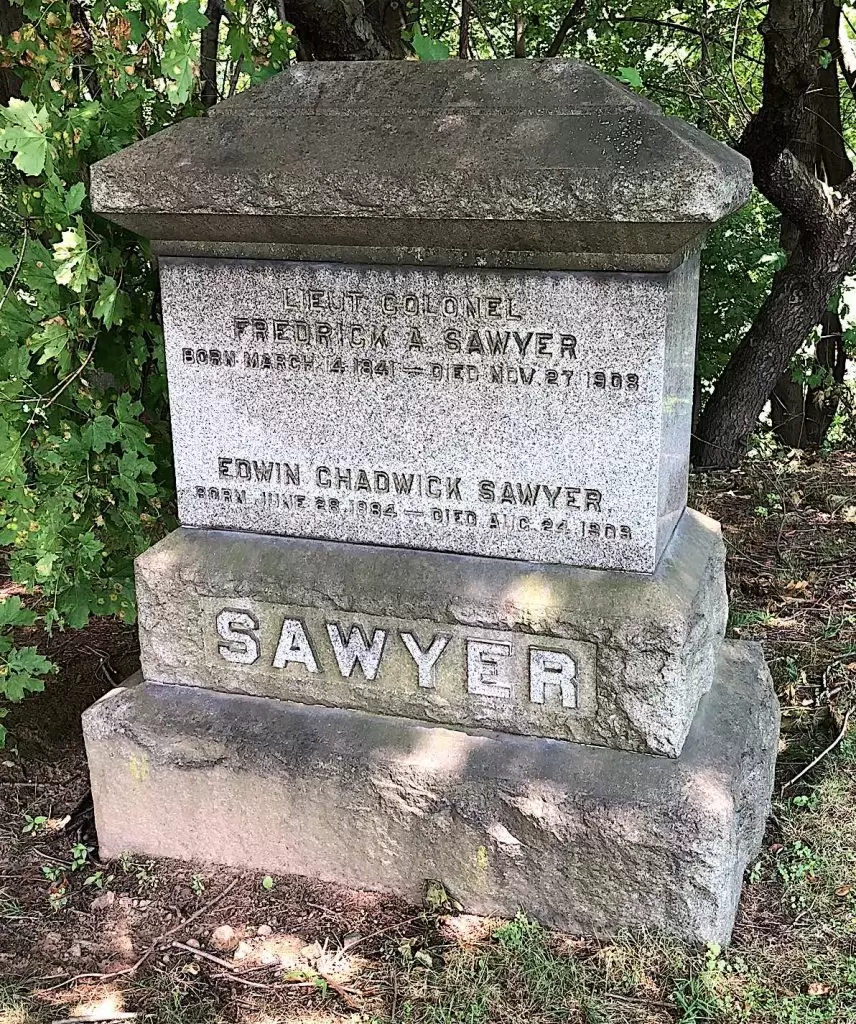
SAXTON (or PAXTON), JAMES W. (1806-1862). Private, 103rd Pennsylvania Infantry, Company F. Although he was listed as James Paxton on Veteran Burial Information and in the New York State Military Museum, that is a misspelling; his name was James Saxton on all of his Civil War records. Apparently, an error in reading the first letter of his last name—morphing a script S into a P—occurred either at Green-Wood or at Long Island College Hospital (where he had died).
The 1850 census reports that Saxton was born in Pennsylvania, lived in Clarion County with his wife and children and worked as a laborer. The Saxtons still lived in Clarion County at the time of the 1860 census; James Saxton was laborer whose real estate was worth $150 and whose personal estate was $200. During the Civil War, Saxton enlisted as a private at Rimersburg, Pennsylvania, on December 7, 1861, and mustered immediately into Company F of the 103rd Pennsylvania Infantry at Camp Orr. As per an article in The New York Times on July 9, 1862, sick and wounded soldiers were on board the Knickerbocker after arriving at Old Point from James River on July 6; the men were bound for New York and Pennsylvania. On July 14, The Times reported that Saxton, who was suffering from typhoid fever, was transported along with others who were ill or wounded, to Long Island College Hospital in Brooklyn.
Two days later, the Evening Post reported that many of the men at that hospital were convalescing in sheds erected on the grounds. Their only wants, as per the report, were for articles not furnished by the government including stimulants, undergarments suitable for sick persons, and volunteers to care for the men at night. A subsequent article in the New York Daily Tribune on July 22, 1862, noted that 123 wounded and sick men were being cared for at the hospital, the majority, like Saxton, suffering from typhoid fever; at that time seven men had died—all from disease. There were twelve wards set aside for the men, who were well-fed and given the best medical and surgical care. Women volunteers and male assistants tended the men during the day, relieved by male volunteers at night. The daily menu was also noted to give readers an idea of the men’s diet: “For breakfast: Bread and butter, tea, toast, milk, porridge and eggs. Dinner: Potatoes, bread, meat, soup and vegetables. Supper: Bread and butter, rice, tea, milk and fruit.” Unfortunately, Saxton did not survive; he died at Long Island College Hospital on July 26, 1862. Saxton’s muster roll and The History of Pennsylvania Volunteers 1861-5 by Samuel Bates note incorrectly that he died in Philadelphia. Mary Saxton applied for and received a widow’s pension on November 21, 1862, certificate 26,748. In light of the misspelling of his name in Green-Wood’s records, a VA stone in the name of John Paxton was installed at his grave; a new and corrected headstone with his given name, James Saxton, has been ordered in 2018 for his gravesite. Section 115, lot 13536 (Soldiers’ Lot), grave 36.
SCHAEFER, CHARLES (1831-1876). Second lieutenant, 4th New York Infantry, Company D. Schaefer, who was born in Germany, enlisted on April 22, 1861, at New York City, as a second lieutenant. On May 2, he was commissioned into the 4th New York and served with his regiment until he resigned on April 12, 1862. He died from asphyxiation in Weehawken, New Jersey. Section 15, lot 17263, grave 874.
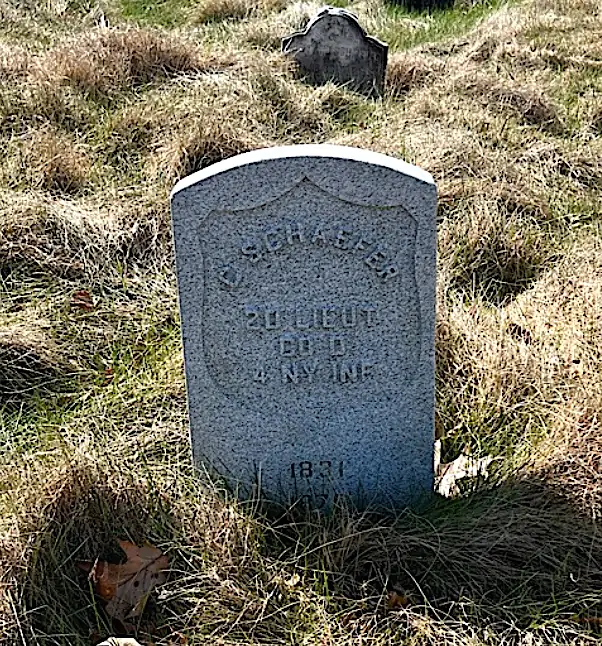
SCHAEFER, FREDERICK (1844-1906). Private, 93rd New York Infantry, Company D; 58th New York Infantry, Company D. Born in New York City, Schaeffer enlisted there as a private on September 4, 1861, and mustered into Company D of the 93rd New York, also known as Morgan’s Rifles, on September 27 of that year. On November 23, 1861, he transferred into the 58th New York and deserted on October 19, 1862. He last resided in Sharon, Massachusetts where he died of apoplexy. Section N, lot 18096, grave 15.
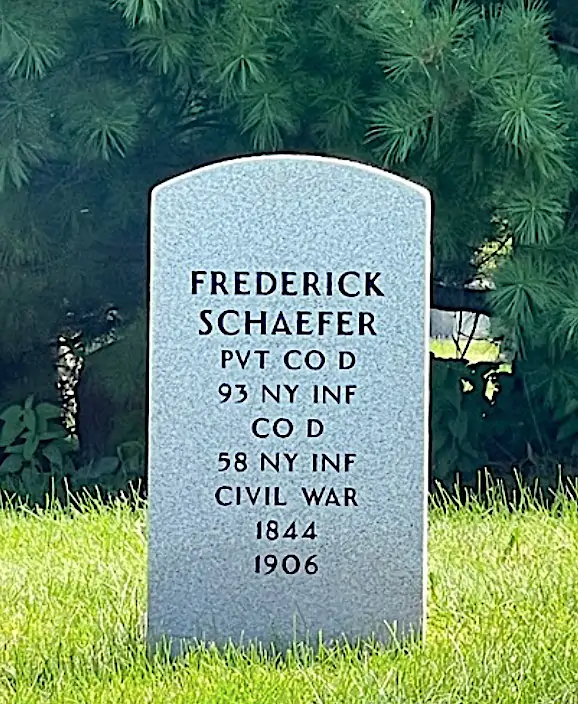
SCHAEFER, PETER (1820-1876). Private, 2nd New York Heavy Artillery, Company L; 34th Independent Battery, New York Light Artillery. Schaefer, a native of Germany, enlisted at Flushing as a private on August 28, 1861, at the age of 42. He mustered into Company L of the 2nd New York Heavy Artillery, and transferred into the 34th Light Artillery on October 1, from which he was discharged for disability on March 5, 1862. Section 102, lot 9791.
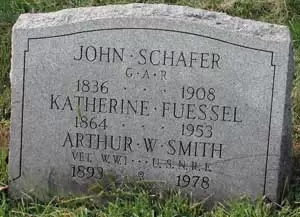
SCHAFER, JOHN (1836-1908). Unknown soldier history. Schafer was born in Germany. According to an inscription on his gravestone, he was a member of the Grand Army of the Republic, an organization of Civil War veterans. He last resided in Brooklyn, on Lake Street near Avenue U. Schafer’s death was caused by pneumonia. Section 127, lot 16311, grave 180.
SCHAN, JOHN (1844-1872). Private, 15th New York Heavy Artillery, Company C. Originally from Germany, Schan enlisted as a private at Fort Lyon, Virginia, on January 27, 1864, the same day that he mustered into the 15th Heavy Artillery, and mustered out on August 22, 1865, at Washington, D.C. His last residence was 57 First Avenue in Manhattan. The cause of his death was due to phthisis (tuberculosis). Section 117, lot 10975, grave 500.
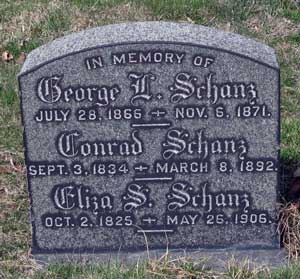
SCHANZ, CONRAD (1834-1892). Sergeant, 1st New Jersey Cavalry, Company M. Originally from Germany, Schanz enlisted as a private on August 27, 1863, and mustered into his company the same day. He was promoted to corporal on September 1, 1863, and then to sergeant on July 1, 1865, before he mustered out on July 24, 1865. He last lived at 804 Bergen Street in Brooklyn. Section B, lot 8575, grave 824.
SCHANTZ, JOHN C. (1819-1890). Private, 156th New York Infantry, Company E. Of German birth, Schantz enlisted as a private at Kingston, New York, on March 30, 1864, the same date that he mustered into the 156th New York. He mustered out on October 23, 1865, at Augusta, Georgia. He last lived at 4 Douglass Street in Brooklyn. His death was attributed to senile debility. Section 15, lot 17263, grave 893.
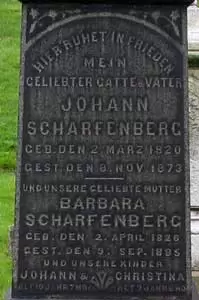
SCHARFENBERG, JOHN (or JOHANN) (1820-1873). Private, 68th New York Infantry, Companies E and H. Of German origin, he enlisted as a private at New York City on August 8, 1861, and mustered into the 68th New York two days later. He re-enlisted on January 1, 1864, was transferred to Company H at some point, and mustered out on November 30, 1865, at Fort Pulaski, Georgia. In 1869, his application for an invalid pension was granted, certificate 27,050. His last address was 359 Warren Street in Brooklyn. Although his widow, Barbara Scharfenberg, who is interred with him, applied for a pension shortly after his death in 1873, application 216,128, there is no certificate number. His remains were moved to their present location on November 8, 1878. Section 63, lot 22673.
SCHAUBHUT, JACOB (1831-1908). Private, 58th New York Infantry, Company D. Born in New York City, Schaubhut enlisted there as a private on October 1, 1861, and two days later mustered into Company D of Morgan’s Rifles which later became the 58th Infantry. On November 23, he transferred into Company D of the 58th. He was wounded at the Battle of Second Bull Run, Virginia, on August 30, 1862, and was discharged on January 21, 1863, at Fairfax, Virginia.
In 1891, he applied for and received an invalid pension, certificate 928,871. He last lived at 93 East 4th Street in Manhattan. Shortly after his death from nephritis in 1908, his widow, Minna Schaubhut, received a pension under certificate 666,898. Section 115, lot 4196, grave 726.
SCHEIDT, CHARLES (1826-1878). Corporal, 8th New York Infantry, Company F. Originally from Germany, Scheidt enlisted as a private on April 23, 1861, at New York City, and immediately mustered into the 8th New York. During his service he was promoted to corporal. He mustered out exactly two years after his enlistment on April 23, 1863, at Brooks’ Station, Virginia. Scheidt’s last residence was 114 Avenue D in New York City. He succumbed to tuberculosis. Section B, lot 8575, grave 182.
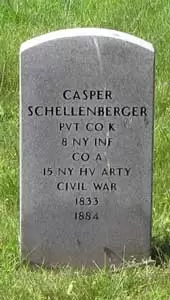
SCHELLENBERGER, CASPER (1833-1884). Private, 8th New York Infantry, Company K; 15th New York Heavy Artillery, Company A. Schellenberger, who was originally from Germany, enlisted twice during the Civil War. His first service began on April 23, 1861, with Company K of the 8th New York when he enlisted at New York City as a private and mustered into the 8th New York that same day. He served for two years, mustering out on April 23, 1863, at Brooks’ Station, Virginia.
On January 5, 1864, Schellenberger re-enlisted as a private at New York City and mustered into the 15th Heavy Artillery. He was wounded on May 19, 1864, at Spotsylvania Court House in Virginia, was taken prisoner on March 31, 1865, at Five Forks, Virginia, paroled sometime later, and mustered out on June 7, 1865, at Annapolis, Maryland. He died at the Home for Consumptives in Brooklyn. Fredericka Schellenberger, who is interred with him, applied for and was granted a widow’s pension, certificate 314,312. In 1897, an application was made for a minor’s pension, application 666,903, but there is no certificate number. Section 13, lot 19694, grave 308.
SCHELLMANN (or SCHELLMAN), JOHAN (or JOHN) (1830-1893). Private, 52nd New York Infantry, Company H. Of German birth, Schellmann enlisted at New York City as a private, mustered into the 52nd on November 1, and was discharged for disability on August 7, 1862, at Philadelphia, Pennsylvania. He last lived at 762 11th Avenue in Manhattan. Schellmann’s death was caused by tuberculosis. Section 204, lot 28531, grave 2.
SCHENCK. PETER MESEROLE (1823-1887). Private, 5th New York Cavalry, Company D. Enlisting as a private on September 24, 1861, at Springfield, New York, Schenck, who was born on Long Island, mustered that day into Company D of the 5th New York Cavalry. No further information is available. He last lived in Irvington, Essex County, New Jersey. His death was caused by bronchitis. Section 15, lot 7919.
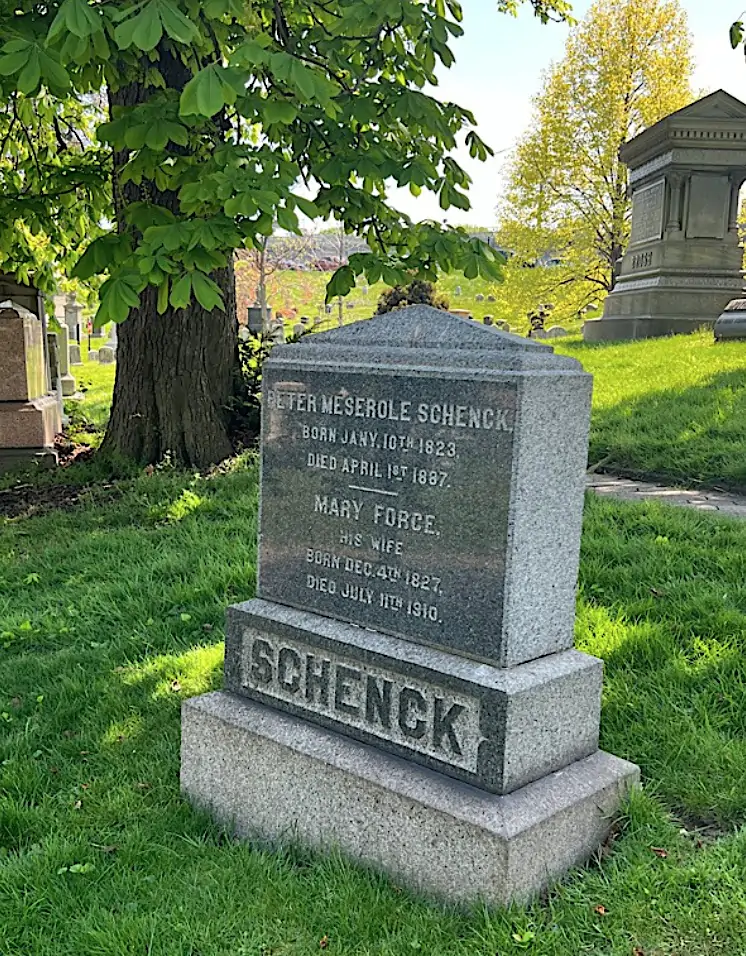
SCHEPER (or SCHIESSER), JOHN H. (1833-1888). Rank unknown, 17th Regiment, New York State National Guard, Company A. Scheper, who was born in Germany, served for 30 days with the 17th New York National Guard in 1863. Further details, including his rank, are not available. He last lived at 461 Third Avenue in Brooklyn. Section 4, lot 21316, grave 138.
SCHEPPER, ADAM (1812-1875). Major, 28th Regiment, New York State Militia, Company F. Born in Germany, he enlisted at Brooklyn as a captain at age 48 on April 23, 1861, was commissioned into Company F of the 28th Regiment’s State Militia on May 11, and mustered out after three months at Brooklyn on August 5. On June 16, 1863, he returned to the 28th Regiment, was promoted to major that day, and was commissioned into the Field and Staff. He mustered out after 30 days on July 22, 1863, at Brooklyn. The 28th Regiment, a Brooklyn-based regiment, was called up to serve in Washington, D.C., in 1861 and in Pennsylvania in 1863 when it was part of the 23rd National Guard. Schepper last lived at 74 Portland Avenue in Brooklyn. His death was attributed to paraplegia, an impairment of the sensory function of the lower extremities. Section 59, lot 1405, grave 50.
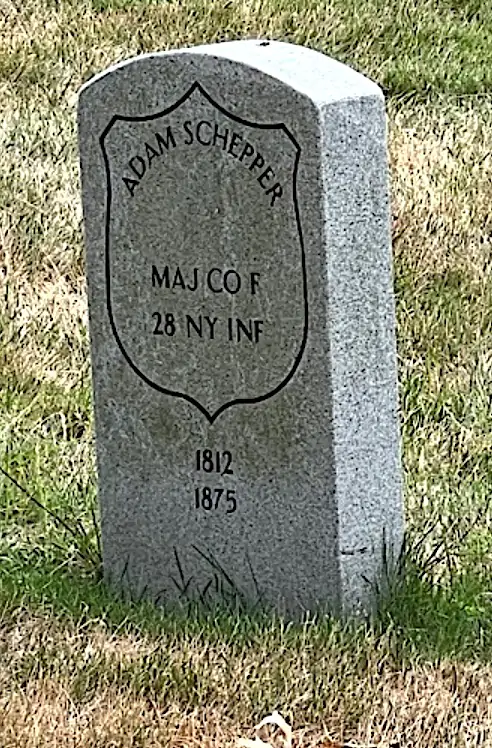
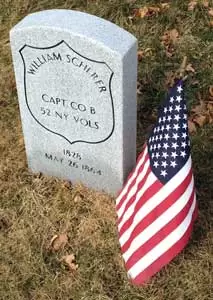
SCHERER (or SCHERRER), WILLIAM (1829-1864). Captain, 52nd New York Infantry, Company B. Born in Germany and a resident of 567 Broome Street in Manhattan, Scherer enlisted as a second lieutenant on August 9, 1861, at New York City, and on November 1, 1861, was commissioned into the 52nd New York. He received promotions to first lieutenant on February 7, 1862, and to captain on August 23 of that year.
Scherer commanded the 52nd Infantry at Gettysburg, Pennsylvania, and described that battle in a field report from Morrisville, Virginia, on August 2, 1863. In his writings, he pointed out that the regiment arrived in a cornfield where the skirmish had been raging for hours, and began firing at the enemy who was 100 yards away. In this exposed position, the enemy fled in all directions and gunfire halted at the edge of the woods. “During this engagement, which lasted over an hour, the regiment lost as follows: Killed, 1 officer and 1 enlisted man; wounded, 3 officers and 21 enlisted men, and missing, 8 enlisted men. Three enlisted men died since in a hospital near Gettysburg.” He was wounded in action at Spotsylvania, Virginia, on May 12, 1864, and he died from his wounds on May 26, 1864, at Armory Square Hospital in Washington, D.C. A government-issued stone was ordered for him early in the 20th century. Section 115, lot 13536 (Soldiers’ Lot), grave 6.
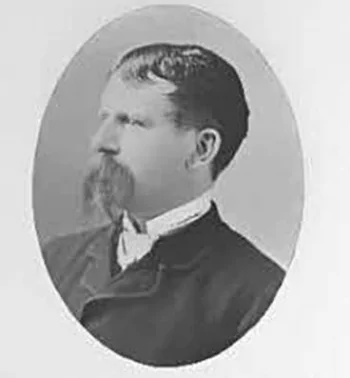
SCHERMERHORN, FREDERICK AUGUSTUS (1844-1919). Captain by brevet; first lieutenant, 185th New York Infantry, Company C. Born in Manhattan to a distinguished family and educated in the private schools, he entered Columbia College in 1861 but left early in hopes of securing an appointment to the United States Military Academy at West Point. Although his mother received a letter of introduction to President Abraham Lincoln from Secretary of State William Seward, and a note from the President, “I wish to remember this young man for 1863 & to appoint him, unless there shall be over-bearing reasons to the contrary. Jan. 22, 1862,” and a follow-up note to Representative Henry Stebbins in 1864, Schermerhorn never received an appointment to West Point.
He first enlisted as a second lieutenant on December 27, 1864, but never mustered into the 185th New York. However, on January 25, 1865, Schermerhorn enlisted as a first lieutenant from Camp in the Field, New York, and was commissioned that day into the 185th New York. After serving with the Army of the Potomac, he was detailed as aide-de-camp to Brevet Major General Charles Griffin who commanded the First Division of the Fifth Army Corps. Schermerhorn mustered out on May 30, 1865, at Washington, D.C., at which time he was brevetted to captain for “gallant conduct at the Battle of Five Forks, Virginia, April 1, 1865.”
Schermerhorn then entered the Columbia College School of Mines in October 1865 from which he graduated in 1868 with a degree as an Engineer of Mines. He also served for seven years with Company K of the 7th Regiment of the New York State National Guard rising through the ranks from private to first lieutenant. Active in the field of education, he became a trustee of Columbia College in 1877 and served in that position until 1908. He also dedicated himself to the New York Trade School of which he was a director, treasurer, and trustee. In addition, Schermerhorn was a recording secretary for the New York Institute for the Blind and was its manager for 40 years until his resignation in 1910. Schermerhorn was listed in the 1912 edition of “Who’s Who in the World” as a capitalist. That sketch, which included his military record and many of the clubs of which he was a member, stated that he was a director of New York Life Insurance and Trust Company and a trustee of the Consolidated Gas Company.
An article about Schermerhorn’s death in The New York Times on March 21, 1919, which confirms his Civil War service, noted that he was stricken with apoplexy while speaking at a dinner honoring the governors of the Union Club. That article, which referred to him as a capitalist, philanthropist and educator, included the many organizations to which he was affiliated including the American Geological Society, the St. Nicholas Society, the Loyal Legion, the Metropolitan Museum of Art, and the Museum of Natural History. He also belonged to the following clubs: Metropolitan, Union, City, Century, Knickerbocker, Tuxedo, Westchester Country, Coaching, New York Yacht, Seawanhaka-Corinthian Yacht, Rockaway Hunt, Mendelssohn Glee and Riding. He last lived at 101 University Place in Manhattan and maintained an office at 25 Liberty Street. Section 80, lot 1705.
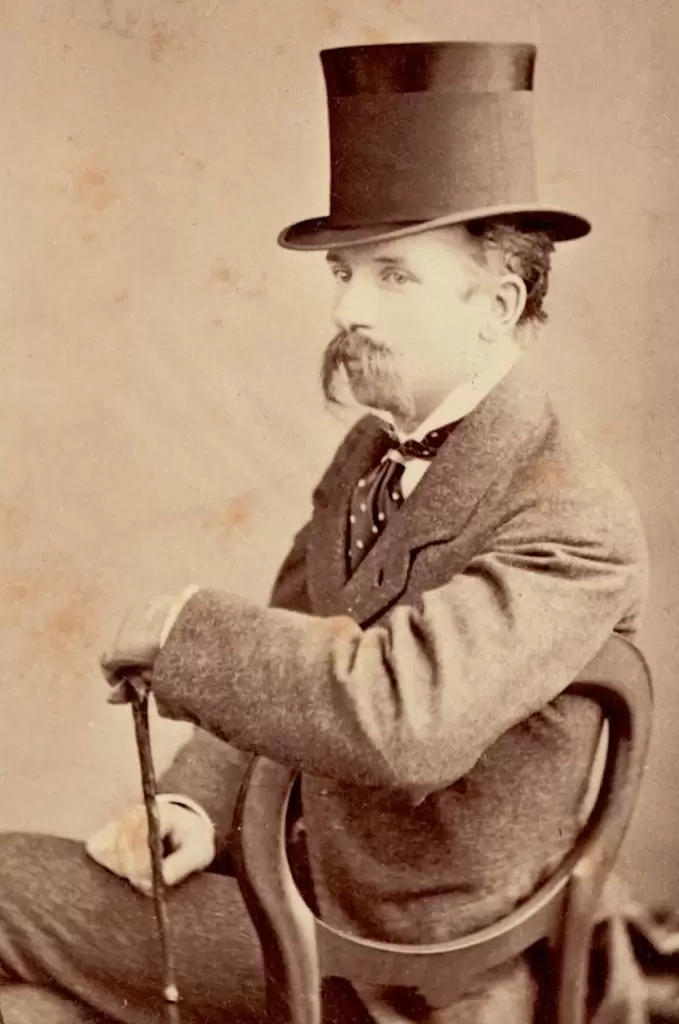
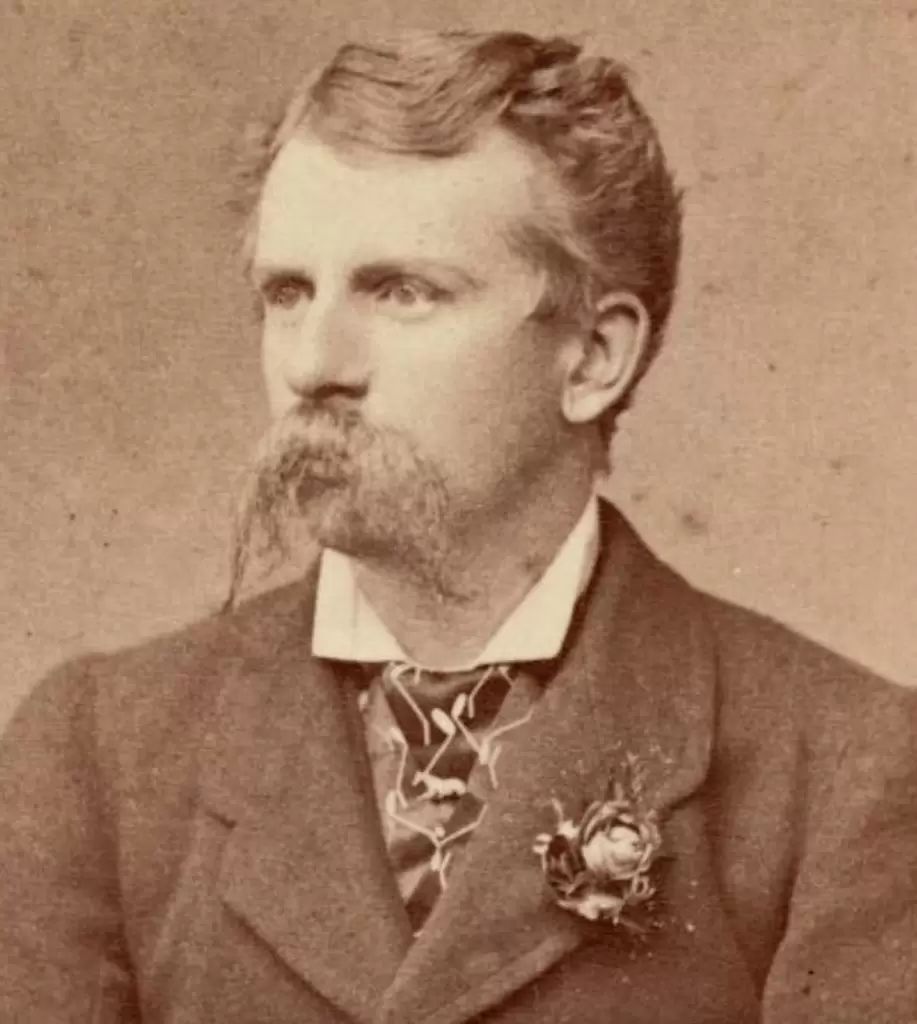
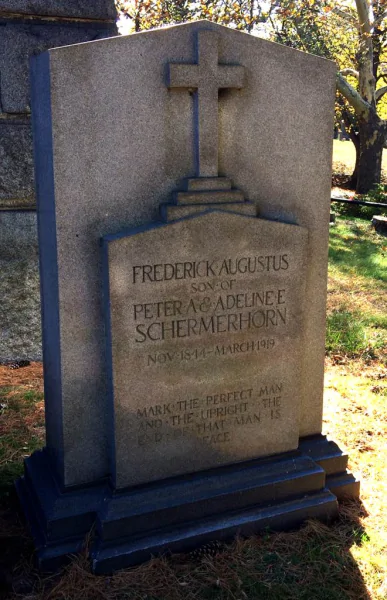
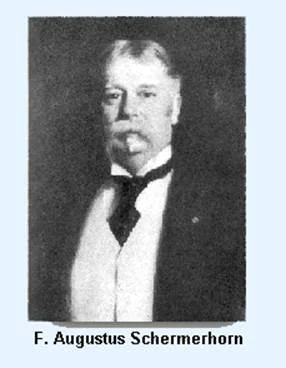
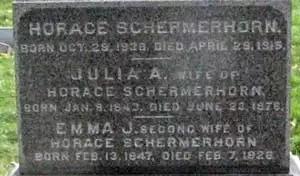
SCHERMERHORN, HORACE (1838-1915). Private, 83rd New York Infantry, Company D. Originally from Hudson, New York, he was a boatman according to the 1860 census with a personal estate valued at $100. Schermerhorn enlisted as a private at New York City on May 27, 1861, and mustered into the 83rd New York the same day. On September 17, 1862, he was wounded in action at the Battle of Antietam, Maryland. He was discharged from military service on June 23, 1864, at New York City.
According to the 1870 census, Schermerhorn was living in Hudson, New York. In 1904, he applied for and was granted an invalid pension, certificate 1,088,744. As per the 1910 census, he was living with relatives in Jersey City, was able to read and write, and was living on his “own income.” His last residence was 38 Union Street in Jersey City, New Jersey. Shortly after his death, caused by cerebral apoplexy, his wife’s application for a widow’s pension was approved under certificate 801,462. Section 153, lot 22360, grave 2.
SCHICK (or SCHIK), FREDERICK (1843-1922). Corporal, 173rd New York Infantry, Company K. Originally from Baden, Germany, Schick enlisted at Brooklyn as a private on November 13, 1862, and mustered into the 173rd New York on that date. On April 9, 1864, at Pleasant Hill, Louisiana, he was taken prisoner of war. He was promoted to corporal on May 27, 1864, paroled on May 27, 1865, and was discharged from military service on July 8, 1865, at New York City. In 1891, he applied for and received an invalid pension, certificate 796,383. He was a member of the Mansfield Post #35 of the G.A.R. Schick’s obituary in the Brooklyn Standard Union confirmed his Civil War service. His last residence was 167 34th Street, Brooklyn. His death was caused by heart disease. Section 128, lot 31262, grave 265.
SCHIFFER, CASPER (1827-1877). Corporal, 132nd New York Infantry, Company A. Originally interred at Green-Wood, his remains were removed in 1878. A native of Germany, Schiffer enlisted as a corporal at Brooklyn on September 18, 1862, and mustered into the 132nd New York on October 4. He deserted on January 1, 1863, at Norfolk, Virginia. His last residence was 406 West 48th Street in Manhattan.
SCHILLING, CARL G. A. (1819-1871). Private, 39th New York Infantry, Company K; Veterans Reserve Corps. A native of Germany, Schilling enlisted as a private at Tarrytown, New York, on December 31, 1863, and mustered into Company K of the 39th New York that day. On February 19, 1864, he transferred into an unknown company of the Veteran Reserve Corps. His last residence was 49 Norfolk Street in Manhattan. Schilling died from emphysema. Section 17, lot 17245, grave 1091.
SCHILLING, JOHN A. (1841-1910). First sergeant, 37th Regiment, New York State National Guard, Company D. After enlisting as a first sergeant at New York City on May 29, 1862, he mustered into the 37th Regiment, and mustered out after three months on September 2 at New York City. As per his obituary in the Brooklyn Standard Union, Schilling retained his interest in military affairs through his membership in the Winchester Post #197 of the G.A.R., War Veterans’ Association, Army and Navy Union, and the 71st Veterans’ Association (which consolidated with the 37th Regiment in 1870). In addition, he belonged to the Royal Arcanum and the First District Republican Club. Members of those associations were invited to his funeral. Schilling last lived at 3 Montague Terrace in Brooklyn. He succumbed to heart disease. Section 24, lot 3439.
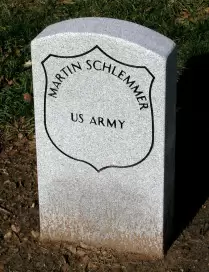
SCHLEMMER, MARTIN (1842-1869). Private, 8th New York Infantry, Company I. Originally from Germany, Schlemmer enlisted on April 23, 1861, at New York City, and mustered that day into Company I of the 8th New York. He was listed as hospitalized with a gunshot wound to the leg and “abandoned to the enemy” as a prisoner of war at Harrisonburg, Virginia, on June 11, 1862. He was paroled on September 13, 1862, at Aiken’s Landing, Virginia, and sent to Washington, D.C. Schlemmer mustered out with his company on April 23, 1863, at Brooks’ Station, Virginia.
As per his death certificate, Schlemmer was a joiner, a craftsman who joins pieces of wood in order to construct furniture, houses and/or ships. His last residence was at 121 Clinton Street, Manhattan. A government-issued stone was installed circa 2007 to mark his grave. Section 115, lot 13536 (Soldiers’ Lot), grave 111.
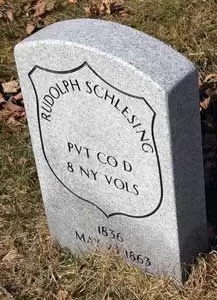
SCHLESING, RUDOLPH (1836-1863). Private, 8th New York Infantry, Company D. Enlisting at New York City as a private on April 23, 1861, Schleswig, a German native, mustered into the 8th New York on that day, and mustered out on April 23, 1863, at Brooks’ Station, Virginia. He died the next month in New York City on May 18. A government-issued stone was ordered for him early in the 20th century. Section 115, lot 13536 (Soldiers’ Lot), grave 66.
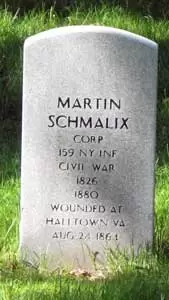
SCHMALIX (or SMALIX), MARTIN (1826-1880). Corporal, 159th New York Infantry, Company B. A native of Germany, he enlisted as a private at Brooklyn on September 10, 1862, and mustered into the 159th New York on November 1 of that year. He rose to corporal on May 14, 1864, was wounded at Halltown, Virginia, on August 24, 1864, and mustered out on October 12, 1865, at Augusta, Georgia. Among the other engagements of the 159th were Irish Bend and Port Hudson in Louisiana, and Cedar Creek in Virginia.
After the Civil War, Schmalix was a saloonkeeper. In 1876, his application for an invalid pension was granted, certificate 149,965. He last lived at 110 Boerum Place in Brooklyn. His death was attributed to oedema pulmonum, a respiratory failure. Elizabeth Schmalix, who is interred with him, applied for and received a widow’s pension, certificate 287,075. Section 2, lot 5499, grave 177.
SCHMIDT, ADOLPH (1835-1906). Private, 158th New York Infantry, Company K; 100th New York Infantry, Company D. Of German birth, he enlisted as a private at Brooklyn on November 18, 1863, and mustered into the 158th Infantry that day. On June 30, 1865, he was transferred into the 100th New York. He last resided on 3rd Avenue in Brooklyn. His death was attributed to senility. Cosina Mountford applied for and received a widow’s pension, certificate 828,945. Section 115, lot 4196, grave 536.
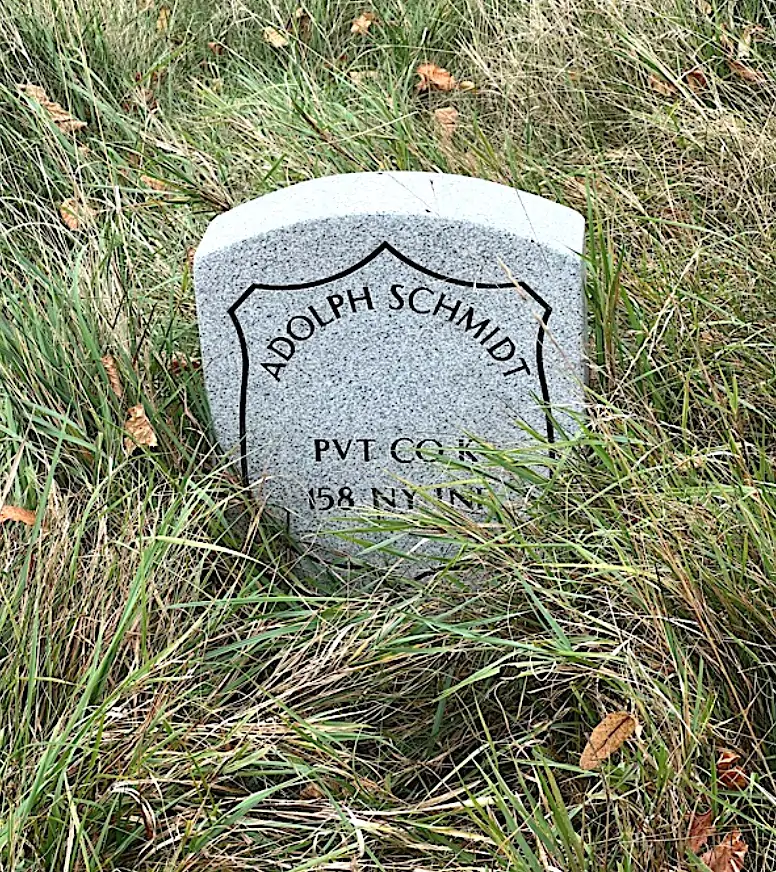
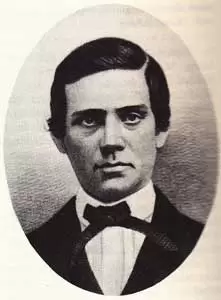
SCHMIDT, EDWARD M. (1838-1909). First lieutenant, 4th New York Cavalry, Company E; second lieutenant, 25th New York Cavalry, Company A; corporal, 37th Regiment, New York State National Guard, Company A. A native of New York, he enlisted as a first lieutenant (date unknown) and was commissioned into the 4th New York Cavalry, resigning on January 10, 1862. He re-enlisted as a corporal at New York City on May 29, 1862, mustered into the 37th Regiment, and mustered out after three months on September 2 at New York City. On February 20, 1864, he re-enlisted at Saratoga Springs, New York, as a second lieutenant, was commissioned into the 25th New York Cavalry that same day, and was dismissed by order of the War Department on June 16, 1864. He last resided on Park Place in Brooklyn. Section 123 lot 247.
SCHMIDT, MORITZ ANTON (1841-1886). Private, 21st Pennsylvania Infantry, Company H. Of German birth, Schmidt served in his company for three months in 1861. Further details are not available. He last lived at 47 35th Street in Brooklyn. His death was caused by albuminuria, a kidney-related disease. Section 3, lot 21025, grave 190.
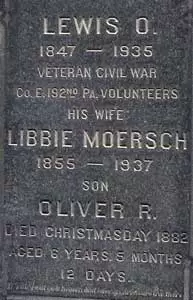
SCHNACKENBERG, LEWIS O. (1847-1935). Private, 192nd Pennsylvania Infantry, Company E. According to his obituary in The New York Times, Schnackenberg, who was originally from Tamaqua, Pennsylvania, entered the 192nd as a drummer boy at the age of 14. He re-enlisted as a private on February 16, 1865, mustered the same day into the 192nd Pennsylvania, and mustered out on August 24, 1865.
Employed in the produce commission business, he belonged to the Devon-Cushing Post of the G.A.R., where he was a commander and among the last three surviving members of that post. He last lived at 96 Bay 32nd Street in Brooklyn. He succumbed to intestinal cancer. Section 145, lot 24111, grave 2.
SCHNEIDER, CASPAR (1827-1870). Private, 2nd New York Infantry, Company K. Of German origin, Schneider enlisted as a private at Troy, New York, on April 30, 1861, and mustered into the 2nd New York on May 14. He was discharged for disability at Camp Butler, Virginia, on January 4, 1862. His last residence was in New Brighton, Staten Island. He died of Bright’s disease. Section 163, lot 14682.
SCHNEIDER, EDWARD M. (1846-1864). Private, 57th Massachusetts Infantry, Company K. Born in Bronza, Turkey, where his father was a missionary, he came to the United States for his education in 1862 and considered it his duty to fight for the Union cause. A resident of Boston, Massachusetts, and a student at Andover, he enlisted there on March 8, 1864, and mustered into the 57th Massachusetts on April 6. He was 5′ 6″ with grey eyes, black hair and a dark complexion. On May 6, he was listed as absent when he was detailed as a guard for a baggage train during the Battle of the Wilderness. Shortly after that assignment, he was wounded slightly in the foot at North Anna River, Virginia, on May 24, treated at a field hospital and returned to duty. Subsequently, he was shot five times at Petersburg, Virginia, on June 17. He succumbed to his wounds on June 19, 1864, at Petersburg, where his brother, William, recorded his last words, “Stand by the Dear Flag, and cling to the Cross of Christ.” According to his soldier record, he also served in Virginia at the Battles of Spottsylvania, and Cold Harbor. Originally buried on the battlefield at Petersburg, he was moved to Green-Wood in February 1866. Section 123, lot 247.
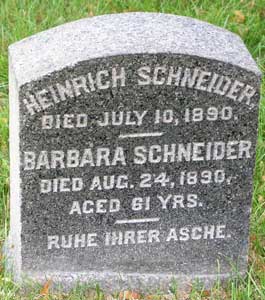
SCHNEIDER, HEINRICH (1822-1890). Sergeant, 46th New York Infantry, Company G. Originally from Germany, Schneider enlisted at New York City as a private on September 3, 1861, and mustered immediately into the 46th New York. He was promoted to corporal on May 15, 1862, reduced in rank to private on September 15, and then promoted to sergeant on November 15 of that same year. He re-enlisted on January 4, 1864, and was discharged for disability on June 11, 1865. His application for an invalid pension was granted, certificate 197,973. He last lived on Duane Street in Manhattan where he died from apoplexy. The application of his wife, Mary Schneider, for a widow’s pension was approved, certificate 601,812. Section 206, lot 21347, grave 2117.
SCHNEIDER, HERMAN (or HERMANN) (1839-1914). Corporal 1st New York Cavalry, Company I; private, United States Rifles, Company B; 58th New York Infantry, Company H. Born in Germany, Schneider enlisted as a private at New York City on September 27, 1861, and mustered into the United States Rifles the same day. On November 23, 1861, he transferred into the 58th New York Infantry, Company H. He re-enlisted as a private at Brooklyn on August 15, 1864, mustered into the 1st New York Cavalry, was promoted to corporal on May 1, 1865, and mustered out of service on June 27, 1865, at Alexandria, Virginia. His last residence was 331A Stuyvesant Avenue in Brooklyn. His death was caused by arteriosclerosis. Section 15, lot 17263, grave 1964.
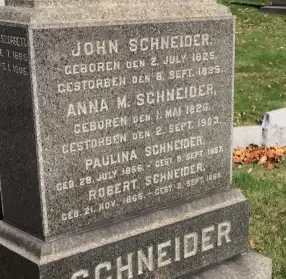
SCHNEIDER, JOHN (1825-1889). Private, 5th Regiment, New York State National Guard, Company G. Of German origin, Schneider served as a private with the 5th Regiment when it was activated for 30 days in 1863—from June 18 to July 22. He last lived at 995 Tenth Avenue in Manhattan. His death was attributed to nephritis. Anna Schneider, who is interred with him, applied for a widow’s pension in 1890, application 448,250, but there is no evidence that it was certified. Section D, lot 18308.
SCHNEIDER (or SNEIDER), REINHARD (or REINHARDT, REINHART, RHINEHART) (1840-1904). First lieutenant, 78th New York Infantry, Companies C, D, and I; 2nd New York Heavy Artillery, Company A; private, 79th New York Infantry. According to his descendant, who researched the family’s genealogy, Schneider was born in Hesse Darmstadt, Germany, and immigrated to the United States on the Bremen in 1854. In 1855, the family settled in the Clifton section of Staten Island, where Schneider was listed as a clerk on the census. On February 27, 1861, Schneider became a naturalized citizen.
During the Civil War, Schneider enlisted as s private in the 2nd New York on May 13, 1861, but his regiment failed to muster and was disbanded. He then re-enlisted in the 79th New York, also known as the Scotch Highlanders, and as per his affidavit for an invalid pension, fought at the Battle of Blackburn Ford on July 18, 1861, and at First Bull Run, Virginia, on July 21, where he was wounded. He stated that he received a furlough and did not return to the regiment; other records incorrectly listed him as a deserter. He re-enlisted as a private on March 19, 1862, and mustered into Company C of the 78th New York. At that time, he was 5′ 10″ tall with blue eyes, dark hair and a dark complexion. He was promoted to first sergeant and transferred to Company D three months later on June 1. He was commissioned second lieutenant on February 17, 1863, with rank from October 27, 1862, and was promoted to first lieutenant of Company I as of September 21, 1863, with rank from July 29, 1863.
Schneider reported in his application for an invalid pension that he suffered internal hemorrhages during his time in Bridgeport, Alabama, that left him with heart palpitations. According to his testimony, he was on picket duty during heavy snow on March 10, 1864, suffered exposure, and was hospitalized for about six weeks. He mustered out on July 12, 1864, at Chattanooga, Tennessee. He subsequently served as a first lieutenant in the 2nd New York Heavy Artillery as of October 14, 1864. As per his application for an invalid pension in 1892, he declared that on December 9, 1864, at Petersburg, Virginia, he was ordered to chase the enemy across Hatcher’s Run. He had to cross water that was five feet deep and very cold. His clothing froze next to his body and he could not be warmed by the campfire. This resulted in a heavy cold which ultimately led to kidney disease, an inguinal hernia and rheumatism in the left shoulder. Schneider was treated at City Point Hospital in Virginia in 1865. He mustered out at Washington, D.C., on September 29, 1865.
The New York City Directory for 1877 indicates that Schneider was a policeman. He applied for an invalid pension in 1888 and 1892, application 951,463. His application reported that he also suffered from fractured ribs, a gunshot wound to the right ankle and general disability. Schneider’s name appears in the New York Town Clerk’s Register of Men Who Served in the Civil War. On June 28, 1902, he successfully petitioned Congress to correct his military record and was issued an honorable discharge from the 79th New York. His death was caused by phthisis. Section 136, lot 28070.
SCHNEIDER, WILHELM (1824-1873). Private, 7th Regiment, New York State National Guard, Company D; 15th New York Heavy Artillery, Company G. Of German birth, Schneider enlisted at New York City as a private and served with the 7th Regiment for three months in 1862. On June 27, 1863, he re-enlisted at New York City as a private, mustered into the 15th Heavy Artillery, and mustered out on August 22, 1865, at Washington, D.C. He last lived at 19 Forsyth Street in Manhattan. His death was attributed to paralysis. Section 163, lot 16944.
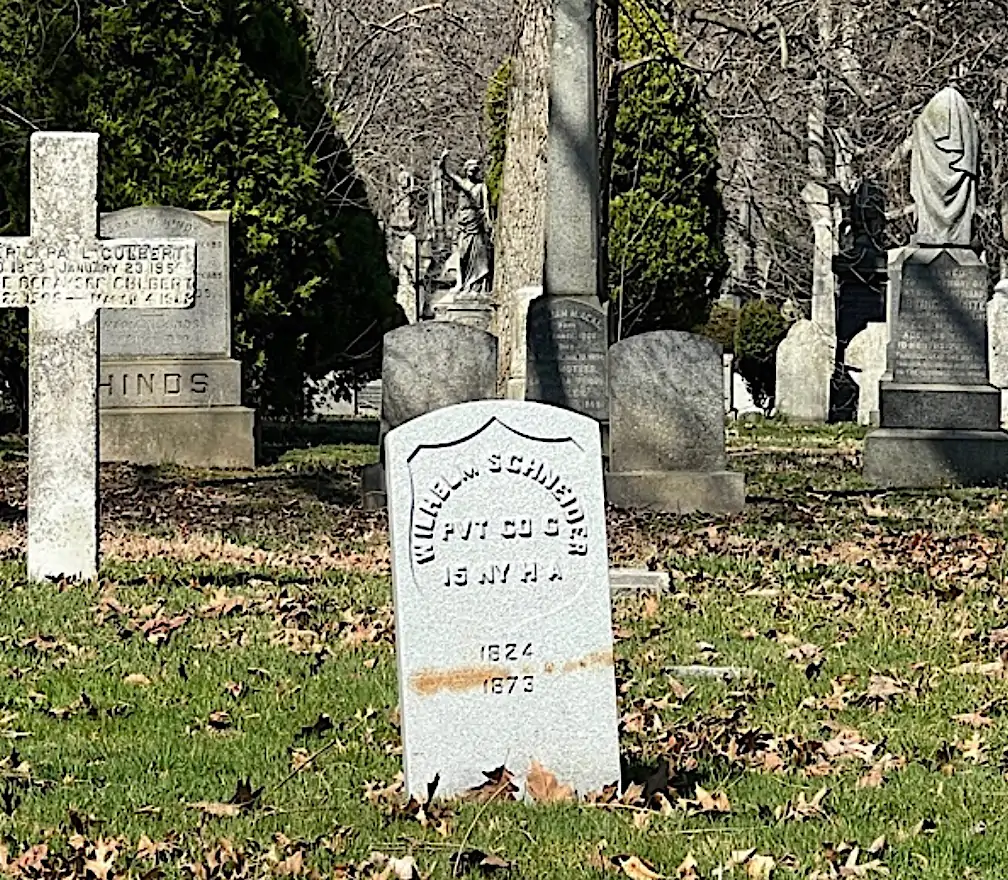
SCHNEPF, HENRY (1837-1885). Private, 84th New York (14th Brooklyn) Infantry, Company H; 5th New York Veteran Infantry, Company I. Schnepf enlisted at Brooklyn and mustered into the 14th Brooklyn on August 30, 1862, suffered wounds at Gettysburg, Pennsylvania, on July 1, 1863, and was transferred into the 5th Veterans on June 2, 1864. He mustered out on May 31, 1865, at Alexandria, Virginia.
In the 1877 Brooklyn Business Directory, Schnepf is listed as a clerk. In subsequent Brooklyn directories, he is identified as a bookkeeper and in the express shipping business. He last lived at 573½ Kosciusko Street, Brooklyn. Lelia Schnepf applied for and received a widow’s pension, certificate 301164. Section 169, lot 14680.
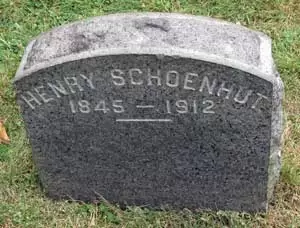
SCHOENHUT, HENRY (1845-1912). Private, 2nd Regiment, United States Veteran Volunteer Infantry, Company G. Originally from Lenderscheid, Germany, Schoenhut’s obituary in the Brooklyn Daily Eagle noted that he served in the 15th United States Cavalry during the Civil War. Subsequently, he served as a private in the 2nd Regiment, U.S. Veterans. No further details are known.
Schoenhut’s obituary in The New York Times, which also confirmed his service in the Civil War, indicates that he had retired from the hotel business. He also had been in the delicatessen business. In addition, he had been president of the Kings County Liquor Dealers’ Association, the Knights of Honor (a fraternal organization), and the Burgerschutz Verein Association, an organization that promoted German culture. He last lived at 7819 17th Avenue in Brooklyn. Section 87, lot 1715, grave 447.
SCHOFIELD, ANDREW (1827-1885). Private, 125th New York Infantry, Company F. A New York State native, Schofield enlisted at Troy, New York, as a private, on August 13, 1862, and mustered into the 125th New York two weeks later. He was taken prisoner of war on September 15, 1862, at Harper’s Ferry, Virginia, and paroled there the next day. He deserted on October 4, 1862, at Chicago, Illinois. His last residence was 251 West 29th Street in Manhattan. Section 5, lot 3412, grave 61.
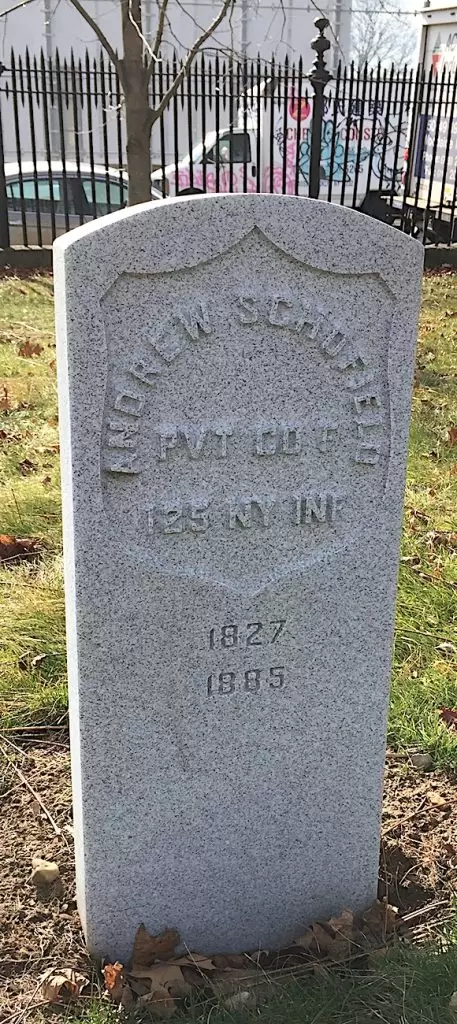
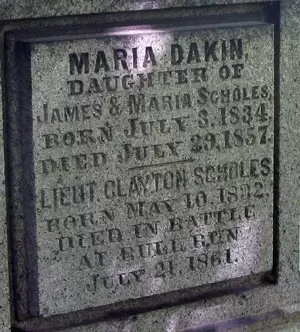
SCHOLES, CLAYTON (1832-1861). First lieutenant, 84th New York (14th Brooklyn) Infantry, Companies C and I. He enlisted at Brooklyn as a private on April 18, 1861, and mustered into the 14th on May 23. On July 1, 1861, he was promoted to first lieutenant effective upon his transfer to Company I, but he was not commissioned in that rank.
Scholes was killed at the Battle of First Bull Run, Virginia, on July 21, 1861. His valor there was noted in the field report of his commanding officer Colonel Andrew Porter, 16th Infantry, United States Army, who wrote from Arlington, Virginia, on July 25, 1861, “Scholes and other officers of the Fourteenth …were distinguished by their display of spirit and efficiency throughout the action.” Lieutenant Colonel Edward Fowler (see) also wrote of Scholes’s valor. Fowler noted that Scholes chose to wear the uniform of a private and to go into battle with his comrades in Company C rather than stay with Company I which was assigned to guard the camp. Fowler said that Scholes had told him, “If there was to be a fight he was determined to take part in it.” His brother, Frederick (see), went to Bull Run in April 1862 in a vain attempt to find his remains. His name, date of death, and an inscription that he died in battle at Bull Run are carved into the family’s granite marker at Green-Wood. Section 102, lot 1879.
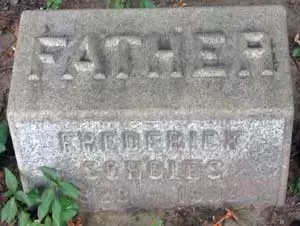
SCHOLES, FREDERICK (1823-1905). Second lieutenant, 47th Regiment, New York State National Guard, Company A. Scholes was born in Manchester, England, according to his obituary in the Brooklyn Standard Union (although another document says Ireland), and came to the United States at the age of six. He settled in the Eastern District of Brooklyn and had a sulphur factory on Kent Avenue as per the Brooklyn Directory of 1858. A Republican, he was elected alderman of the Nineteenth Ward in 1859 and served for two terms.
On April 7, 1862, Scholes was called to testify by the Joint Committee on the Conduct of the War and questioned by Moses Odell (see). In recounting his visit to Bull Run, Virginia, and his unsuccessful effort to locate the body of his brother, Clayton (see), he described how the bodies of the dead were buried without regard to decency: stripped of their belongings, many naked and thrown into graves. Frederick Scholes enlisted at Brooklyn as a quartermaster on May 27, 1862, was commissioned into the Field and Staff of the 47th New York that day, and mustered out after three months of service on September 1 at Brooklyn. When his unit was reactivated the next year, he was promoted to second lieutenant on June 17, 1863, commissioned into Company A, and mustered out after 30 days on July 23 at Brooklyn.
Scholes is listed as a brimstone manufacturer in the Brooklyn Directories of 1862, 1863, 1864, and 1868. His obituary, which notes that he recruited regiments and served at Fort McHenry during the Civil War, reports that he was instrumental in securing improvements for his community. Among these improvements were the widening of streets and the paving of Bedford Avenue with concrete (a first in the United States), the construction of a market at Wallabout Creek, and the campaign against the marketing of impure milk. In addition, he was a member of the Volunteer Fire Department in Brooklyn. Scholes managed his factory throughout his life and had one of the largest orchid beds in the city on property he owned on Keap and Hooper Streets. His obituary states that he gave the land to the United Congregational Church on Lee Avenue and worshiped there. He last resided at 590 Bedford Avenue in Brooklyn, part of the land of the old Scholes farm that his family once owned, but died of uraemia at his farm in Essex, Connecticut, where he had a summer home. Section 166, lot 31151, graves 10 and 11.
SCHOONMAKER, ELLIS (1829-1881). Private, 87th New York Infantry, Company G; 40th New York Infantry, Companies G, F, and A; 20th Veteran Reserve Corps. After enlisting as a private on September 6, 1862, he mustered into the 87th New York, and was immediately transferred into Company G of the 40th New York. He was wounded and captured on the first day of the Battle of Gettysburg, Pennsylvania, on July 1, 1863, and subsequently paroled. During his service, he was transferred intra-regimentally to Company F on April 30, 1864, and to Company A on July 7. On November 16, 1864, he mustered out at Petersburg, Virginia. He also served in the 20th Veteran Reserve Corps. As per the 1877 New York City Directory, he worked in “stone.” In 1880, he applied for an invalid pension, application 351,396, but apparently it was not granted. His last residence was at 448 West 28th Street in Manhattan. Schoonmaker’s death was caused by pneumonia. Section 2, lot 5499.
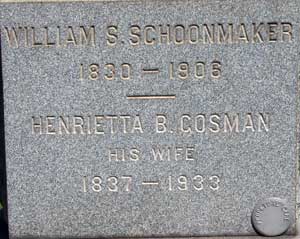
SCHOONMAKER, WILLIAM SKIDMORE (1830-1906). Captain, 8th Regiment, Veteran Reserve Corps; first lieutenant, 51st New York Infantry, Companies G and C. Born in Flatbush, Schoonmaker was 5’8½” tall with a dark complexion. He enlisted at Brooklyn as a sergeant on August 16, 1861, and mustered into Company G of the 51st New York on September 12. During 1862, he rose through the ranks being promoted to first sergeant on April 15, to sergeant major on July 21, and to second lieutenant on November 1. On November 1, 1862, he was also transferred to Company C and promoted to first lieutenant.
On December 13, 1862, Schoonmaker was wounded in the head by a gunshot while in command of the color guard on Marye’s Heights in the Battle of Fredericksburg, Virginia. His commanding officer, Robert B. Potter, commended him in his field report from Fredericksburg, noting that he was injured and deserved mention for his excellent conduct. Schoonmaker was transferred to the 8th Regiment of the Veteran Reserve Corps as a first lieutenant on November 24, 1863, was promoted to captain on April 21, 1865, and resigned on June 2, 1866. His application for an invalid pension was granted in 1880, certificate 224,625. In 1891, an application was granted for a minor’s pension under certificate 358,723. His last residence was 558 Ocean Avenue in Brooklyn. His death was caused by pneumonia. Section 156, lot 20280.
SCHOSSIG, FREDERICK (1825-1883). Private, 1st New Jersey Light Artillery, Battery E. A German native, Schossig became a naturalized citizen on May 12, 1862. During the Civil War, he enlisted as a private on March 27, 1865, mustered that day as a substitute in the 1st New Jersey Light Artillery, and mustered out on July 11, 1865, at Trenton, New Jersey. By 1866, he moved to Brooklyn where he is listed in the Brooklyn Directory as living at 53 Union Street. As per his death certificate, he was married and had been employed as a stone cutter. He last lived at 259 Devoe Street in Brooklyn and his death was attributed to “fatty heart.” Section 115, lot 11193, grave 255.
SCHOTT, LOUIS (1842-1906). Private, 71st Regiment, New York State National Guard, Company H. A native of New York City, Schott enlisted there on May 28, 1862, and served with the 71st for three months in the defense of Washington, D.C., before mustering out on September 2. Schott belonged to the G.A.R. after the War. He succumbed to pneumonia. Section 197, lot 32434.
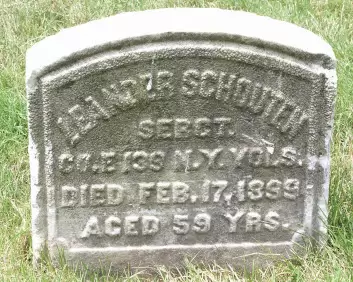
SCHOUTEN, LEANDER (1829-1889). Private, 139th New York Infantry, Company E. He enlisted at Brooklyn on August 26, 1862, mustered in on September 9, and mustered out on June 19, 1865, at Richmond, Virginia. He last lived at 336 East 83rd Street in Manhattan. He died from cirrhosis of the liver. Section 6, lot 20118, grave 659.
SCHRAIDT, PHILIP (1840-1889). Corporal, 8th New York Infantry, Company K. A native of Germany, Schraidt enlisted at New York City as a private in 1861, and was promoted to corporal in the 8th New York prior to his discharge. Further details are unknown. His last residence was 532 5th Avenue, New York City. In 1900, Theresa M. Schraidt, who is interred with him, applied for and was granted a widow’s pension, certificate 495,259. Section 189, lot 16399.
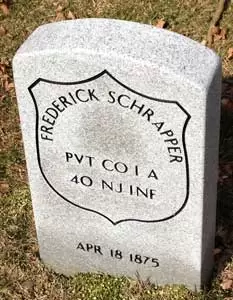
SCHRAPPER (or SCHROPPER), FREDERICK (1842-1875). Private, 40th New Jersey Infantry, Companies I and A. Born in Switzerland, he enlisted as a private on March 10, 1865, and mustered into the 40th New Jersey Infantry, Company I, the same day. He was subsequently transferred to Company A, and mustered out on July 13, 1865, at Hall’s Hill, Virginia. His last residence was on West 37th Street in Manhattan. He died of phthisis (tuberculosis.) A marble Veterans Administration stone was ordered for him early in the 20th century. Section 115, lot 13536 (Soldiers’ Lot), grave 116.
SCHREINER, EDWARD (1843-1915). Private, 71st Regiment, New York State Militia, Company A. Schreiner, who was born in New York City, had two tours of duty with the 71st Militia. He enlisted on April 10, 1861, served three months, and was discharged on July 30. He then returned to the same company as a private and served with the 71st for three months in 1862. In civilian life, he was a produce merchant. In 1907, his application for an invalid pension was granted, certificate 1,132,442. His last address was 340 Jefferson Avenue in Brooklyn. Shortly after his death from pneumonia in 1915, his widow, Mary Schreiner, who is interred with him, received a pension, certificate 802,286. Section 27, lot 4773.
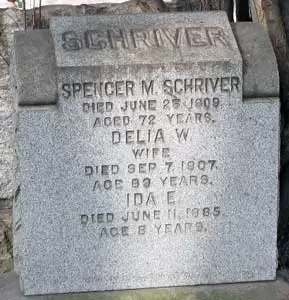
SCHRIVER, SPENCER M. (1837-1909). Private, 8th Regiment, New York State Militia, Company H. After Schriver enlisted as a private in 1861 at New York City, he mustered into Company H of the 8th Regiment, and mustered out at the expiration of his three month enlistment. In 1880, he was employed as a painter. He applied for and was granted a pension in 1903, certificate 1,077,354. His last residence was 764 Putnam Avenue in Brooklyn but in the months before his death, he resided at the Soldiers’ Home in Bath, New York. Section 199, lot 25092, grave 2.
SCHROEDER, JOHN (1834-1869). Private, 119th New York Infantry, Company I. Schroeder, who was born in New York, enlisted at New York City as a private on August 19, 1862, mustered into the 119th on September 5, the same day that he deserted from his unit at New York City. He last lived at 362 West 43rd Street in Manhattan. He died of heart disease. Section 122, lot 17806, grave 314.
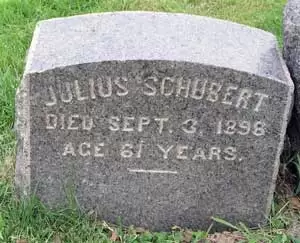
SCHUBERT, JULIUS (1837-1898). Private, 1st New York Mounted Rifles, Company G; rank unknown, United States Navy. Of German birth, he enlisted and mustered into the 1st New York Rifles on September 4, 1862, at Southfield, New York, and transferred into the Navy on April 17, 1864. Details about his service in the Navy are unknown. His last residence was 60 Montague Street in Brooklyn. Schubert died of endocarditis. Section 135, lot 30010, grave 688.
SCHULTZ, HARMAN C. (1838-1905). First lieutenant, 48th New York Infantry, Companies I, C, A, and G. Born in Brooklyn, his father, Jacob Schultz, was alderman of the Fifth Ward. Harman Schultz was a clerk in the lumber business when he enlisted at Brooklyn as a private on August 5, 1861. Mustering into Company I of the 48th New York, known familiarly as Perry’s Saints, the next day, he rose through the ranks and was promoted to sergeant upon his transfer to Company C, then to second lieutenant on August 12, 1863, when he transferred to Company A. He was promoted to first lieutenant on April 19, 1864, effective upon his transfer the next day to Company G.
Schultz fought in many battles of the Civil War including these in South Carolina: Port Royal, Hilton Head, Bluffton, and Morris Island where he was slightly wounded during the assault there at Fort Wagner. He was also at the siege of Fort Pulaski, Georgia, and at the Battle of Olustee, Florida. In Virginia, he fought at numerous battles including: Fort Darling, Drury’s Bluff, Bermuda Hundred, Cold Harbor, the siege of Petersburg, Mine Explosion, Deep Bottom, Strawberry Plains, Newmarket Heights, and Charles City Road where he was wounded. The records to the commissioner of pensions noted that he was “in arrest” in September 1864. He mustered out on November 10, 1864, in Virginia.
Employed for forty years by the auction house, Cole & Murphy, Schultz was also a member of the 48th Regiment Veteran Association and the G.A.R.’s Ulysses S. Grant Post #327. As per his obituary in the Brooklyn Daily Eagle, which noted his Civil War service, he had been president of the 48th Veteran Volunteers at one time and was a member of the Royal Arcanum. It is likely that he was the brother of Martin Schultz (see) who served with the 139th New York. In 1904, his application for an invalid pension was granted, certificate 1,089,418. His last residence was 265 Schermerhorn Street in Brooklyn. His death was attributed to senility. Section 102, lot 3242, grave 13.
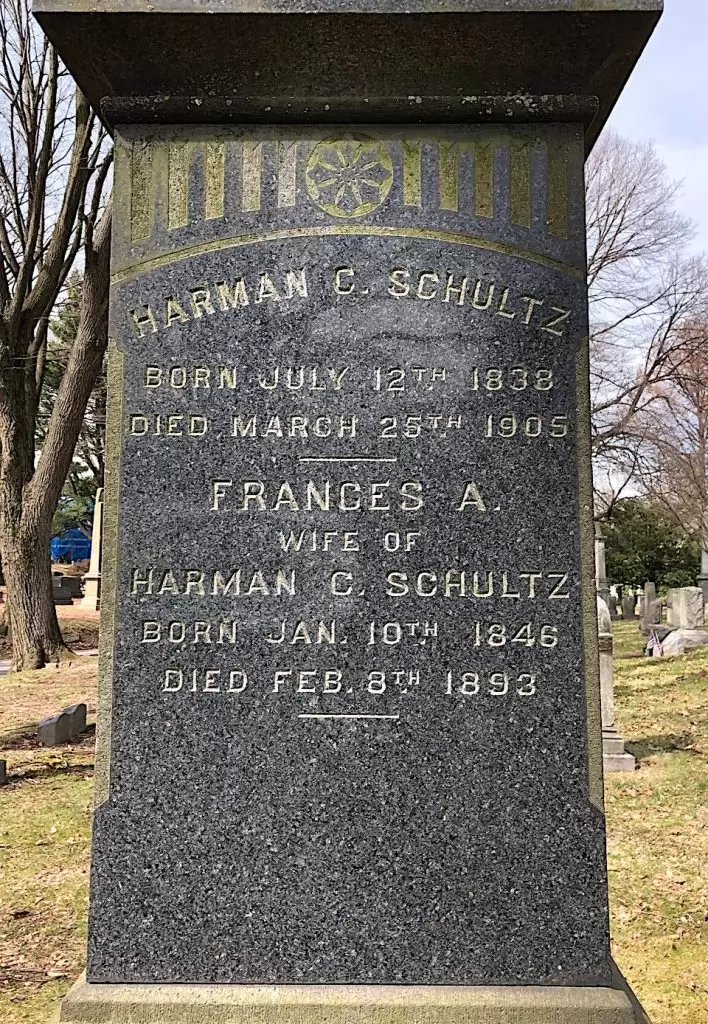
SCHULZ, JACOB (1825-1891). Private, 119th New York Infantry, Company B. Originally from Hesse Darmstadt, Germany, Schulz enlisted at New York City as a private on July 3, 1862, and mustered into the 119th New York on September 4. As per his muster roll, he was a laborer who had dark brown eyes, black hair and a dark complexion. His muster roll notes that he was detached as a teamster on September 3, 1862, and was present with his company in April 1863. He was listed as absent and sick at Dennison Hospital in Ohio on May 13, 1864, and was absent and sick when his company mustered out on June 7, 1865, at Bladenburg, Maryland. He last lived at 323 St. Marks Avenue in Brooklyn. Section 191, lot 24749.
SCHULTZ, MARTIN V. B. (1841-1890). Private, 139th New York Infantry, Company K. After he enlisted as a private at Brooklyn on August 26, 1862, he mustered into the 139th on September 9, and was discharged for disability on April 25, 1863. Most likely, he was the brother of Harman C. Schultz (see). He last lived at 265 Schermerhorn Street in Brooklyn. He died from hepatitis. Section 102, lot 3242.
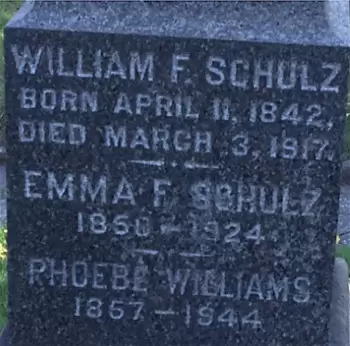
SCHULZ, WILLIAM FREDERICK (1842-1917). Corporal, 99th New York Infantry, Companies I and C. A native of New York, Schulz enlisted as a private and mustered into Company I of the 99th New York on unknown dates. At some point, he was promoted to corporal. As per his pension index record, Schulz was transferred into Company C on June 14, 1864, and was discharged on October 29, 1864.
In 1889, Schulz applied for and received an invalid pension under certificate 896,209. The Veterans Schedule of 1890 confirms his Civil War service and states that he was living in Long Island City, New York. Schultz last lived at 664 Eighth Avenue in Long Island City. He died from arteriosclerosis. Schulz left real estate valued at $18,000 in his will-the equivalent of $364,000 in 2016. Section E, lot 20424, grave 3.
SCHUMACHER, CHARLES A. (1823-1900). First lieutenant, 41st New York Infantry, Company D. Of German origin, Schumacher enlisted as a first lieutenant on June 6, 1861, at New York City, and was immediately commissioned into Company D of the 41st New York. On September 26, 1862, he was discharged from service due to disability. His last residence was on 8th Avenue in Manhattan. Section 156, lot 18747.
SCHURIG, CHARLES (1826-1883). Major and captain by brevet; first lieutenant, 84th New York (14th Brooklyn) Infantry, Company H. A native of Germany, Schurig enlisted as a sergeant on April 18, 1861, at Brooklyn, and mustered into the 14th Brooklyn on May 23, 1861. During his service, he was promoted to first sergeant on March 1, 1862, and then to first lieutenant on October 24, 1862. After being taken as a prisoner of war, he was paroled on December 6, 1862. He suffered a severe wound to the right arm necessitating amputation at Piney Branch Church, Virginia, on May 9, 1864, and mustered out on June 6, 1864, at New York City. He was brevetted captain and major on March 13, 1865, for “gallant and meritorious service at the Battles of Groveton, Virginia, August 29, 1862, and the Wilderness, Virginia, May 10, 1864.” His last residence was 251 Clarmont Avenue, Brooklyn. Section 154, lot 24379.
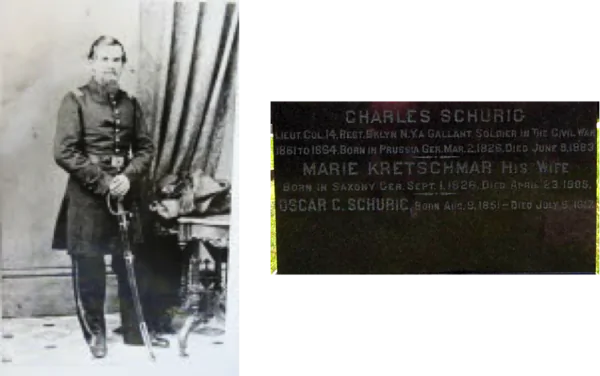
SCHUSTER, CARL A. (1834-1891). Corporal, 52nd New York Infantry, Company D. Of German birth, Schuster enlisted as a private at New York City on September 7, 1861, and mustered into the 52nd on November 1. He rose to corporal on January 1, 1862, was wounded on December 13, 1862, at Fredericksburg, Virginia, and deserted eight days later at Falmouth, Virginia. His last address was 156 East 62nd Street in Manhattan. His death was attributed to “tabes dorsalis,” loss of movement caused by degeneration of the spinal cord. Section L, lot 19811.
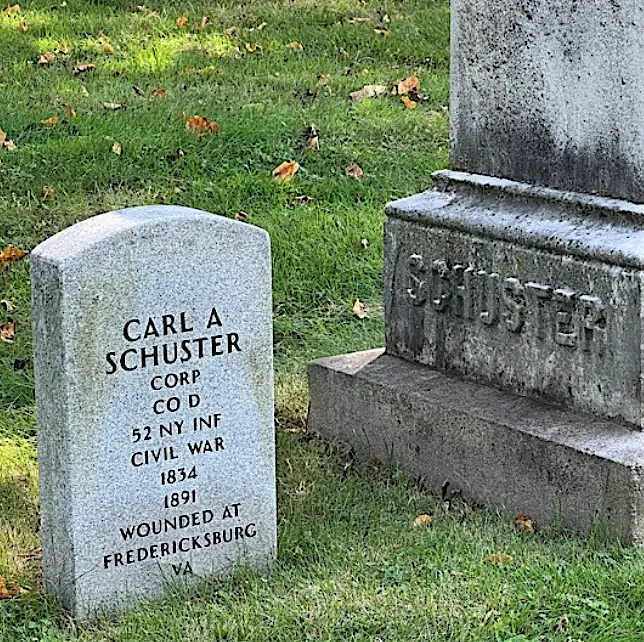
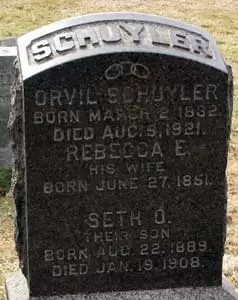
SCHUYLER, ORVIL (or OREVIL, ORVILLE) (1832-1921). Command sergeant, 20th New York Cavalry, Company E; private, 60th New York Infantry, Company C. A native of New York State, Schuyler enlisted on September 26, 1861, at Ogdensburgh, New York, as a private, and served with the 60th New York. On August 12, 1863, he re-enlisted as a private at Wilna, New York, and mustered into Company E of the 20th New York Cavalry. He was promoted to sergeant of his company at some point and then on October 3, 1864, rose to command sergeant. He was discharged from service on July 31, 1865, at Fort Monroe, Virginia.
In 1892, Schuyler’s application for an invalid pension was granted, certificate 644,233. His last residence was at 653 Monroe Street in Brooklyn. In 1921, Rebecca Schuyler applied for and received a widow’s pension, certificate 929,293. Section 59, lot 1428, grave 61.
SCHWARZ, FREDERICK AUGUST OTTO (1836-1911). Rank unknown, 83rd Pennsylvania Infantry. A native of Herford in Westphalia, Germany, Schwarz immigrated to the United States with his three brothers in 1856. During the Civil War, he served with the 83rd Pennsylvania Infantry. Further details are unknown.
Schwarz worked for a German stationery importer in Baltimore, Maryland, and displayed toys along with the stationery in store windows. As the toy business became a money-maker, Schwarz opened his own toy shop, Toy Bazaar, in 1862 and then moved his shop, Schwarz Toy Bazaar, to Manhattan in 1870. At the time he moved to Manhattan, he had instituted the practice of exhibiting toys that would be available for the Christmas season; his holiday catalog began in 1876. Schwarz’s store was first at 765 Broadway, then relocated at Union Square in 1880; in 1889, the store became known as F.A.O. Schwarz Toy Bazaar. By 1896, he proclaimed his establishment as the “Original Santa Claus Headquarters.” In 1897, when the store moved to 39-41 West 23rd Street, he was the largest toy dealer in New York City and “Toy Bazaar” was dropped from the store’s name.
He and his wife, Caroline Clausen Schwarz had six children; the last family members involved in the store sold their shares in 1963. His iconic store, which moved to Fifth Avenue in 1931, was known for its high-end toys and life-sized plush animals; the store drew tourists from around the world until it closed in 2015 when its parent company, Toys R Us, gave up the lease. A reincarnation of the store reopened in 2017. Section 111, lot 19751.
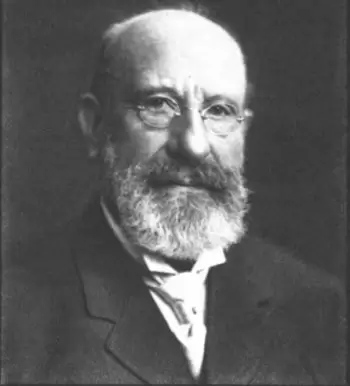
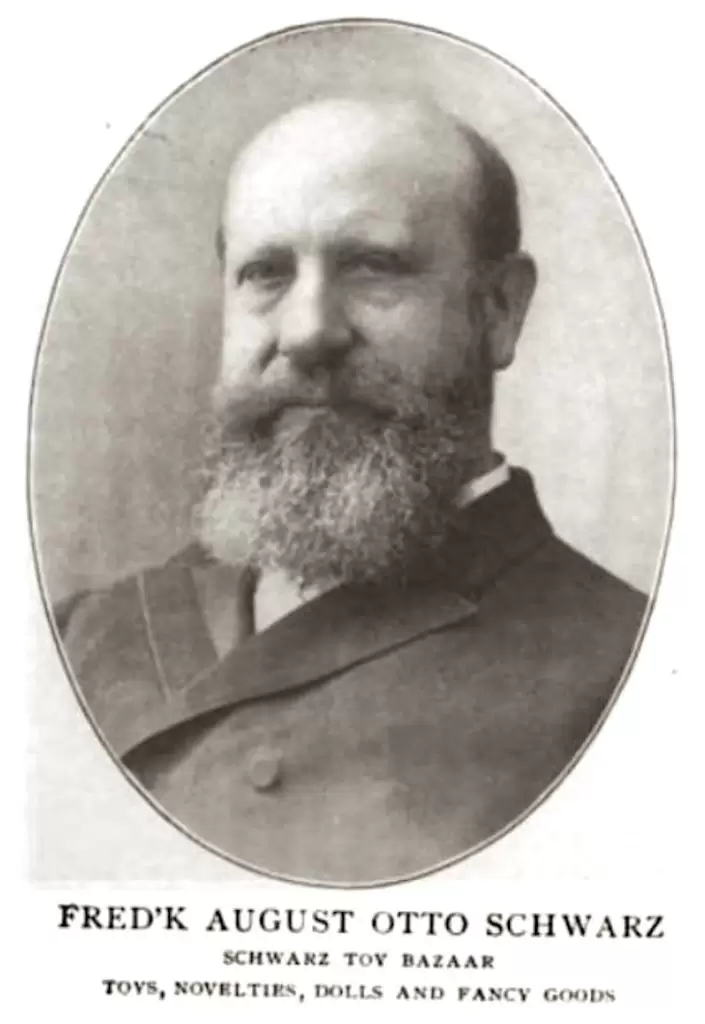
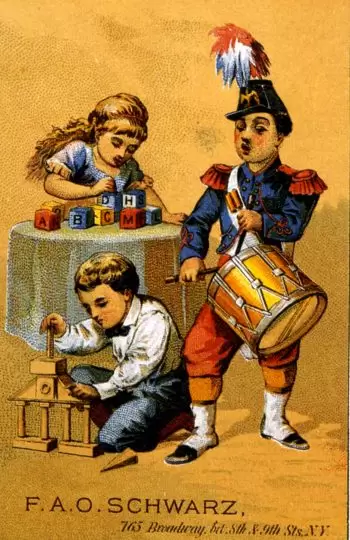
SCHWARZENBACH (or SCHWARZINBACK), JULIUS (1841-1881). Private, 2nd Independent Battery, New York Light Artillery; 1st New York Light Artillery, Battery I. Originally from Switzerland, he enlisted at New York City as a private on December 27, 1862, and mustered that day into the 2nd Independent Battery, New York Light Artillery. On June 6, 1863, he transferred into Battery I of the 1st New York Light Artillery from which he was discharged on an unknown date. According to the Brooklyn Directory of 1868 and the 1880 census, he was a druggist. His last residence was 754 Third Avenue in Brooklyn. His death was attributed to “morbus val cardis.” Section 175, lot 18248.
SCHWARZWAELDER (or SCHWARZWALDER), CHRISTIAN (1813-1888). Colonel, 5th Regiment, New York State Militia. Born in Baden, Germany, Schwarzwaelder came to the United States as a youth and opened a furniture store on East Broadway in 1840. He became colonel of the 5th New York State Militia at the outbreak of the Civil War. Later, he began a career as a banker, established the Germania Bank, and was its president until his death in 1888. He was the father-in-law of Francis Spies (see). He last lived at 664 Water Street in New York City. He died of prostate disease. Section 117, lot 213.
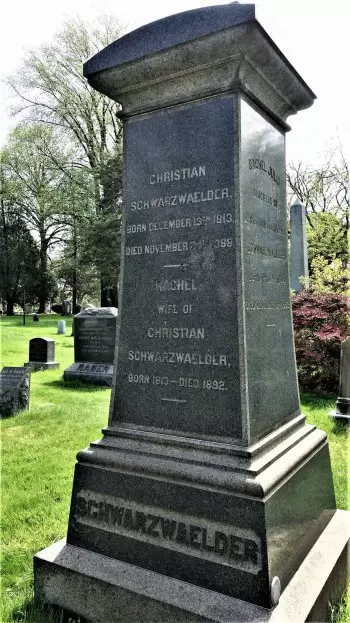
SCHWEINFURTH, PHILLIP (or PHILIPP) J. (1830-1893). Private, 55th Regiment, New York State National Guard, Company D. Schweinfurth, a German native, enlisted in 1863 and served with the 55th Regiment during its 30-day activation. According to his pension records, he also served with the 2nd United States Infantry but the details of that service are not known. He last resided at 240 East 53rd Street in Manhattan. He succumbed to heart disease. Katherine Schweinfurth applied for and received a widow’s pension in 1895, certificate 419,658. Section 116, lot 9271, grave 1.
SCHWIND, ? (?-?). Colonel, 84th New York (14th Brooklyn) Infantry. A register of Kings County, Schwind was colonel of the 14th Brooklyn. He lost an arm at the Battle of Spotsylvania, Virginia, in May 1864. Although records about his soldier history are not available, his service and battle injury were noted in a May 28, 1890, article in the Brooklyn Daily Eagle about remembering Civil War veterans on Decoration Day as told by Joseph Woodward (see), a G.A.R. member. Section ?, lot ?.
SCHWITTER, GEORGE JOSEPH (1835-1926). Band, 17th New York Infantry. Originally from Switzerland, Schwitter served in the band of the 17th New York. The details of his service are unknown. He applied for and received an invalid pension in 1904, certificate 1,089,441. A member of the Rankin Post #10 of the Grand Army of the Republic, he last lived at 1963 East 9th Street in Brooklyn. He died from arteriosis, a congenital heart defect. Section 136, lot 28307, grave 13.
SCOFIELD (or SCHOFIELD), ALVAH (or ALBERT) (1844-1923). Private, 62nd New York Infantry, Company A. According to his muster roll, Scofield, a native of New York, was a clerk at the time he entered service. He was 5′ 5½” tall with blue eyes, light hair and a light complexion. He enlisted as a private at New York City on August 26, 1862, mustered into the 62nd New York two days later, and was discharged for disability at Washington, D.C., on May 9, 1863. His Army pension record indicates subsequent service in the United States Navy aboard the Gettysburg, Grand Gulf, and the North Carolina with a reference to Navy certificates 6,618, 1,207,953, and 951,093. His name appears on the 1890 Veterans Census, at which time he was living in Jersey City, New Jersey. His last residence was on Cedar Hill Avenue in Wortendyke, New Jersey. In 1923 Schofield died of mitral regurgitation. Section 181, lot 15862.
SCOFIELD (or SCHOFIELD), DAVID (1843-1863). Private, 6th New York Artillery, Company C. Scofield was a native of West Farms, in Westchester County, New York. As per the 1850 census, Scofield lived there with his parents and siblings and attended school at that time. The 1860 census notes that he still lived in West Farms with his parents and siblings and, like his father, was a carpenter.
During the Civil War, Scofield enlisted as a private at West Farms on August 18, 1862, and first mustered into the 135th Infantry on September 2; the 135th was officially reorganized into the 6th New York Artillery on October 6 of that year. His Company C was comprised mainly of recruits from West Farms. As per his muster roll, he died from typhoid fever at Post Hospital at Harpers Ferry, Virginia (now West Virginia), April 23, 1863; the New York State Register of Deaths of Enlisted Men indicates a date of April 24, 1863. Scofield was originally buried at West Farms, along with his parents. In 1900, James Scofield, David’s brother, had all three removed and re-interred at Green-Wood. Section 1, lot 8097, grave 4.
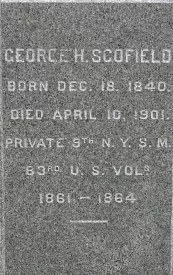
SCOFIELD, GEORGE H. (1840-1901). Private, 83rd New York Infantry, Company A. Born in New York City, Scofield enlisted there and mustered into the 83rd New York on May 27, 1861. He was wounded at Fredericksburg, Virginia, on December 13, 1862, and mustered out on June 24, 1864, at New York City. He last lived at 409 West School Lane in Philadelphia. His death was a result of blood poisoning. Section 107, lot 2303, grave 2 and 3.
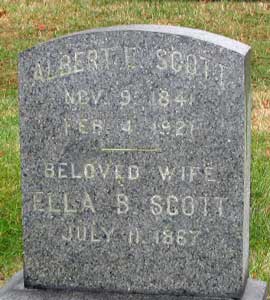
SCOTT, ALBERT E. (1841-1921). First lieutenant, 2nd New York Heavy Artillery, Battery B; sergeant, 1st Maine Heavy Artillery, Company B; private, 8th Regiment, New York State Militia, Company E. Originally from London, England, Scott enlisted as a private at New York City in 1861, mustered into the 8th Regiment, and mustered out with his company after three months. On September 1, 1862, he re-enlisted at Albany, New York, and mustered into the 2nd New York Heavy Artillery where he was commissioned as a first lieutenant the same day. He mustered out on June 8, 1863.
Subsequently, as a resident of Providence, Rhode Island, Scott re-enlisted as a sergeant on October 17, 1864, and immediately mustered into the 1st Maine Heavy Artillery. He was promoted to corporal and sergeant in 1865 before mustering out on September 11, 1866. His soldier record indicates that he had an alias of Arthur Betts, but that name is not on his pension record. In 1904, his application for a pension was granted, certificate 1,083,526. His last residence was 308 West 137th Street, Manhattan. Shortly after his death from pneumonia in 1921, his widow applied for and received a pension, certificate 913,373. Section 119, lot 11785, grave 1.
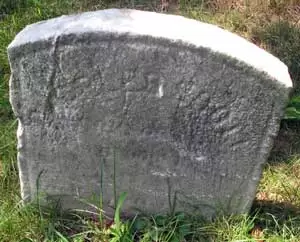
SCOTT, CHARLES (1836-1891). Corporal, 90th New York Infantry, Company B. Originally from Ireland, Scott enlisted at New York City on August 30, 1861, and mustered into the 90th New York on October 11. He was promoted to corporal on February 1, 1863, reduced to ranks on November 12, 1863 then promoted to corporal on January 1, 1864. Scott was wounded in action at Winchester, Virginia, on September 19, 1864, and was hospitalized as per his muster roll. His muster roll notes that he was temporarily transferred to the 165th New York on August 4, 1864, and returned to his regiment on November 26. He mustered out with his company on December 10, 1864, at New York City.
Scott applied for and received an invalid pension on December 22, 1864, under certificate 238,354. The Veterans Schedule for 1890 confirms his Civil War service. He last lived at 151 Classon Avenue in Brooklyn. Shortly after his death from valvular heart disease in 1891, Margaret Scott applied for and received a widow’s pension, certificate 320,502. Section 86, lot 18066, grave 14.
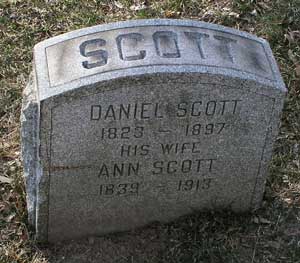
SCOTT, DANIEL (1823–1897). Private, 158th New York Infantry, Company C. Born in Ireland, he enlisted on August 29, 1862, at Jamaica, New York, mustering into the 158th two days later. He deserted on September 18, 1862, at East New York. His last address was on Rockwell Place in Brooklyn. His death was caused by nephritis. Section 86, lot 18066, grave 45.
SCOTT, GARRET (or GARRY) F. (1841-1899). Private, 10th New York Infantry, Companies F and B. Scott enlisted as a private at New York City, his birthplace, on October 7, 1861, and mustered into Company F of the 10th New York on that day. On April 26, 1863, he was transferred within the regiment to Company B, and mustered out on October 11, 1864. He also served in Company E of the 25th New York Infantry. Scott appears to have applied for his military pension in 1897, but it apparently was not certified. He last resided at 100 West 40th Street in New York City. Scott died of meningitis. Section 196, lot 27837, grave 3.
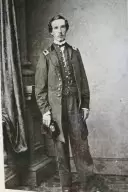
SCOTT, GEORGE WASHINGTON (1841-1922). Brigadier general by brevet; colonel, 61st New York Infantry, Company D; private, 13th Regiment, New York State Militia, Company B. Scott, who was born in New Rochelle, New York, served in the 13th New York State Militia for three months in 1861. He re-enlisted as a second lieutenant at New York City on September 30 of that year, and was commissioned into Company D of the 61st New York that day. He rose through the ranks becoming a first lieutenant on December 5, 1861, and a captain on December 4, 1861.
His commanding officer, Brigadier General Oliver O. Howard, United States Army, wrote about the Battle of Fair Oaks, Virginia, from the USS Nelly Baker, which was stationed at York River on June 3, 1862, and saluted the bravery and cheerfulness of his staff. “Lieutenant Scott, acting aide-de-camp, was always vigilant and brave in the performance of his duties. His horse was also killed under him during the action…” On January 31, 1863, he was promoted to major and was transferred to the Field and Staff on February 18. In 1864, he was promoted to lieutenant colonel on May 12, and to colonel on November 16. He commanded the 61st at the engagement at Deep Bottom, Virginia, July 26-29, 1864; the Battle of Strawberry Plains, Virginia, August 14-18, 1864; the Battle of Reams Station, Virginia, August 25, 1864; and during the Appomattox Campaign, March 28-April 4, 1865.
On March 27, 1865, Scott wrote to headquarters as the commanding officer of the First Brigade describing the engagement of the Richmond Campaign two days earlier. The 61st was given the responsibility of charging the enemy’s picket line, and lost three men, with 15 wounded and ten missing on the first assault. On the second assault, he wrote, “…I assembled the two regiments and advanced my entire brigade line of battle to the front, through an impassable thicket, woods, morass, swamps, and finding the enemy holding a strong intrenched (sic) picket-line, their front covered by deep slashing and morass.” In the end, his troops “stood firm under the attack of the enemy” and advanced fearlessly. In addition to serving as aide-to-camp to Brigadier General Oliver O. Howard, he served in the same capacity to Brigadier General John C. Caldwell and as an acting inspector general on the staff of Major General Winfield S. Hancock. On March 13, 1865, he was brevetted brigadier general of United States Volunteers for “meritorious services.” He mustered out with the regiment on July 14, 1865, at Alexandria, Virginia. In 1904, his application for a pension was granted, certificate 1,089,646. After the War, he was a United States Customs appraiser. His last residence was 699 Monroe Street in Brooklyn. He succumbed to cancer. Section 49, lot 6225, grave 3.
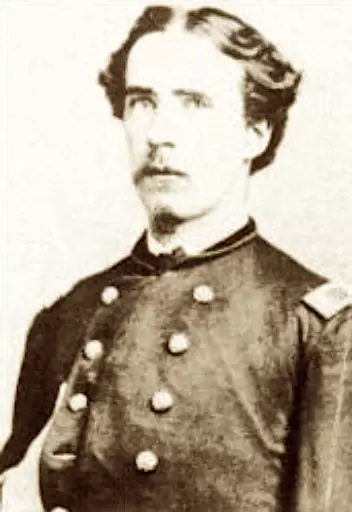
SCOTT, NIELS (or NILES, NEIL, NIEL, MILES) SORENSON (or SOVENSON, SUANSEN, SWANSON) (1845-1909). Private, 93rd New York Infantry, Companies B and A. Born in Vella, Denmark, his family immigrated to Brooklyn when he was a young boy. On July 18, 1864, he enlisted at Williamsburg, Brooklyn, as a private, and mustered into Company B of the 93rd New York that day. His soldier records list his name as Niel Swanson. He was transferred to Company A on November 6, 1864, and mustered out on June 9, 1865, at Washington, D.C.
After the Civil War, he was the owner of the N. S. Scott Showcase Company on Adelphi Street in Brooklyn, and was active in community affairs, especially in the Stuyvesant neighborhood where he was one of the oldest residents, having resided for more than twenty years at 547 Halsey Street. He died from nephritis at his country home in Saddle River, New Jersey. Section 196, lot 30469, graves 1 and 2.
SCOTT, ROBERT (1842-1895). Private, 37th Regiment, New York State National Guard, Company B. A native of New York City, Scott enlisted there on May 29, 1862, mustered immediately into the 37th Regiment’s National Guard, and mustered out after three months on September 2 at New York City. He mustered into the G.A.R.’s James McQuade Post #557 in June 1888. His last residence was 334 West 16th Street in Manhattan. The cause of his death was phthisis. Section 184, lot 19445, grave 6.
SCOTT, WALTER (1842-1915). Sergeant, 83rd New York Infantry, Company I; private, 97th Regiment, New York Infantry, Company F. Scott, who was originally from England, enlisted as a private on July 17, 1861, mustered that day into Company I of the 83rd New York, rose to corporal at some point, and was promoted to sergeant on October 25, 1863. He was wounded at the Battle of Spotsylvania Court House, Virginia. Scott mustered out on July 16, 1864, at New York City. He also served as a private in the 97th New York but the specifics are unknown. On September 2, 1864, he applied for an invalid pension that was granted under certificate 57,927. His last address was in Bath, New York, most likely at the Soldiers’ Home there where he died of myocarditis. Section 183, lot 19216, grave 3.
SCOTT, WALTER (1845-1930). Drummer, 47th New York Infantry, Companies D and K. Originally from Stanford, New York, he enlisted at Stanfordville, New York, on August 6, 1861, as a drummer. He mustered into Company D of the 47th New York on August 28, 1861, and was discharged on August 27, 1864. On November 29, 1864, he re-enlisted as a private at New York City, mustered into Company K of the 47th and mustered out at Portsmouth Grove, Rhode Island, on July 8, 1865. He received an invalid pension in 1891, certificate 832,529. His last residence was 462 East 46th Street in Brooklyn. Shortly after his death from cancer in 1930, his wife applied for a widow’s pension that was granted under certificate a 6-31-31. Section 194, lot 28751, grave 2.
SCOTT, WALTER B. (1843-1919). Sergeant, 131st New York Infantry, Company E. After enlisting as a private on August 19, 1862, Scott, who was born in England, mustered into Company E of the 131st New York on September 6. He was promoted to corporal on July 1, 1863, and rose to sergeant on April 1, 1865. He mustered out on July 26, 1865, at Savannah, Georgia. In 1890, his application for an invalid pension was approved, certificate 600,194. He last lived in Sea Cliff, New York. His death was attributed to arteriosclerosis and myocarditis. Abby Scott, who is interred with him, applied for and received a widow’s pension shortly after his death in 1919, certificate 872,602. Section 72, lot 10980.
SCOTT, WILLIAM (1844-1863). Private, 7th New Hampshire Infantry, Company C. Born in either Ireland or New York City and resident of Cornish, New Hampshire, Scott enlisted as a private on October 2, 1861, and mustered into the 7th New Hampshire on November 6. After he was wounded on September 7, 1863, at Morris Island, South Carolina, he succumbed on November 5 at Fort Schuyler, New York Harbor. Section 85, lot 5057, grave 27.
SCOTT, WILLIAM F. (1831-1861). First sergeant, 83rd New York Infantry, Company A. A New York State native, Scott enlisted at New York City as a first sergeant on on May 27, 1861, and immediately mustered into the 83rd New York. While stationed with his unit at Bolivar, West Virginia, he contracted typhoid fever and was discharged there on July 25, 1861. He died from the disease on September 17, 1861, at his residence at 200 Varick Street in Manhattan. On December 23, 1861, his wife, applied for a widow’s pension, application 645. Section B, lot 9895, grave 690.
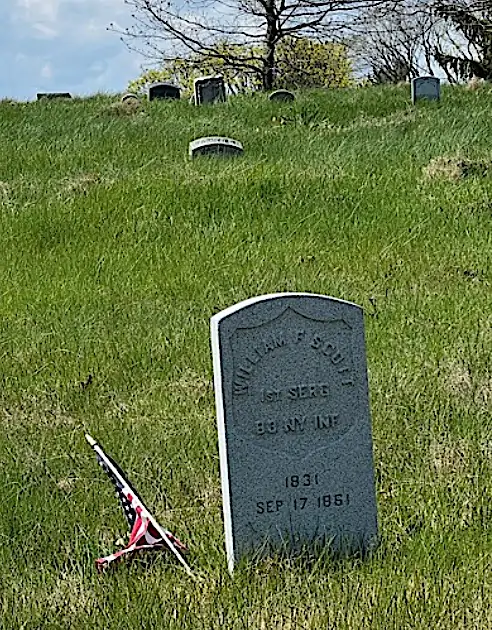
SCOTT, WILLIAM H. (1838-1899). Private, 8th Regiment, New York State Militia, Company G. Scott enlisted at New York City and mustered into the 8th Regiment, also known as the Washington Grays, on April 20, 1861. He fought at First Bull Run, Virginia, before he mustered out with his company on August 2, 1861. After the War, he changed his name to William H. Hopkins. However, his gravestone bears his given name. He last lived at 134 Smith Street in Brooklyn. Section 135/136, lot 30010, grave 314.
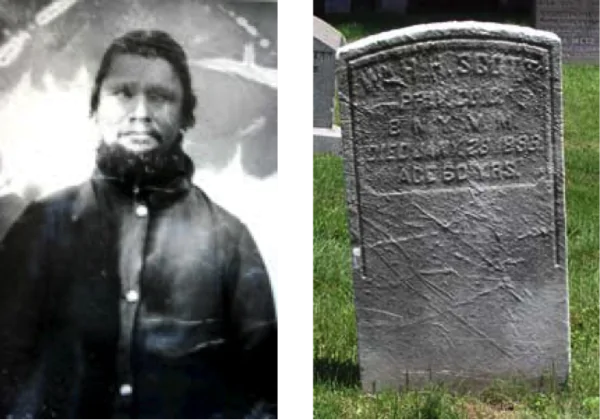
SCRIBNER, JOHN (1838-1863). Seaman, United States Navy. A New York City native, Scribner enlisted there as a seaman at the Naval Rendezvous in May 1861. He was 5′ 8″ tall with a fair complexion. As per an article about his death, Scribner drowned in Baltimore Harbor on May 13, 1863. At that time, he was assigned to the gunboat USS Commodore Barney. Interment at Green-Wood was on May 31, 1863. Section 57, lot 6418.
SCRIBNER, JOSEPH M. (1824-1861). Second lieutenant by brevet, 12th Regiment, New York State Militia, Company C. Born in New York State, he enlisted at New York City on April 19, 1861, as a second lieutenant, for a tour of three months. On May 2, 1861, he was commissioned into Company C of the 12th Regiment with a promotion to second lieutenant by brevet. He mustered out on August 5, 1861. Scribner last lived at 99 Prince Street, Brooklyn. His death was attributed to cancer of the liver. Juliette Scribner applied for and was granted a widow’s pension in 1862, certificate 1,662. Section 22, lot 8213.
SCRIMGEOUR, WILLIAM B. (1841-1862). Private, 84th New York (14th Brooklyn) Infantry, Company D. A native of England, Scrimgeour enlisted on September 17, 1861, mustered in on September 25, and died of “congestion of the brain” on September 10, 1862, at Leesburg, Maryland. Section 190, lot 17737.
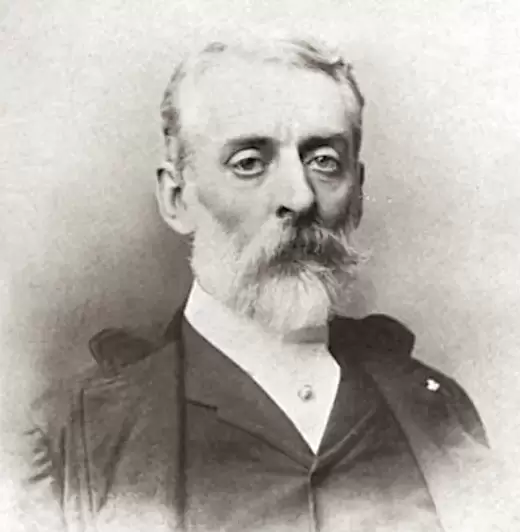
SCRYMSER, JAMES ALEXANDER (1839-1919). Second lieutenant, 43rd New York Infantry, Companies K and D. A native of New York, Scrymser enlisted as a second lieutenant at Washington, D.C., on October 2, 1861, and was immediately commissioned into Company K of the 43rd New York Infantry. On July 18, 1862, he was transferred intra-regimentally to Company D and was discharged on February 26, 1863.
A pioneer in establishing communication lines between the United States and Latin America, Scrymser was president of the Central and South American Cable Company and the Mexican Telegraph Company. When the former company was opened in 1882, the charge for sending a message between the U.S. and Buenos Aires was $7 a word (brought down to $6.50 during his tenure). His companies were responsible for 14,300 miles of cable and 2,500 miles of land wires. According to his obituary in The New York Times, he strived for 48 years to establish the first American-owned direct line between the U.S. and Brazil, an exclusive right previously held by British companies.
Active in education policy, Scrymser implemented the first vacation schools in New York City, a program that was replicated worldwide, and fathered an amendment to the New York State Constitution that prohibited the use of public funds for sectarian education. A philanthropist, he spearheaded the building of the Red Cross Headquarters in Washington, D.C., in 1911 as a memorial to the contribution of women to the Civil War. He belonged to the Loyal Legion, was director of the New York Botanical Gardens, and was a fellow of the Metropolitan Museum of Art. In 1915, his autobiography, Personal Reminiscences of James A. Scrymser, In Times of Peace and War, was published. That monograph, which chronicled his experiences in the Civil War and in the communications industry, also included a chapter, “Memorial to the Women of the Civil War.” After he retired in 1916, he spent much time in Jekyll Island, Georgia, but died of phthisis at his home at 107 East 21st Street in Manhattan. Section 100, lot 915.
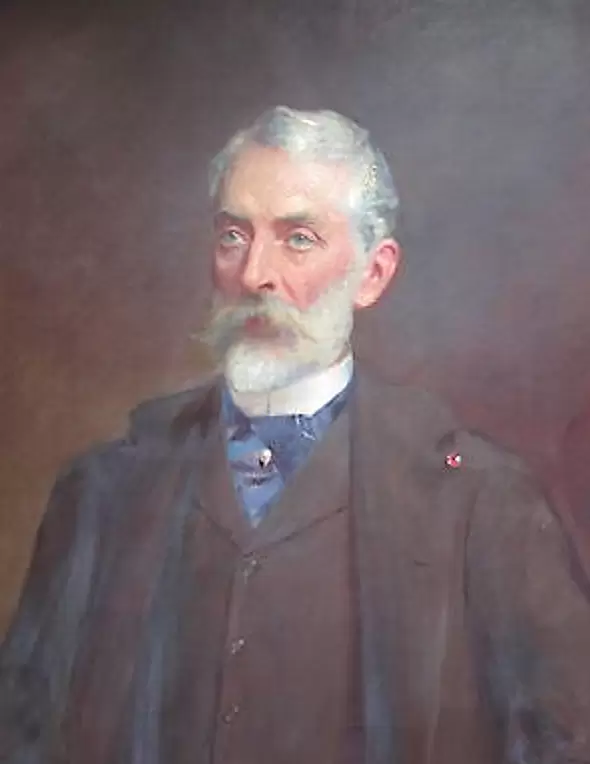
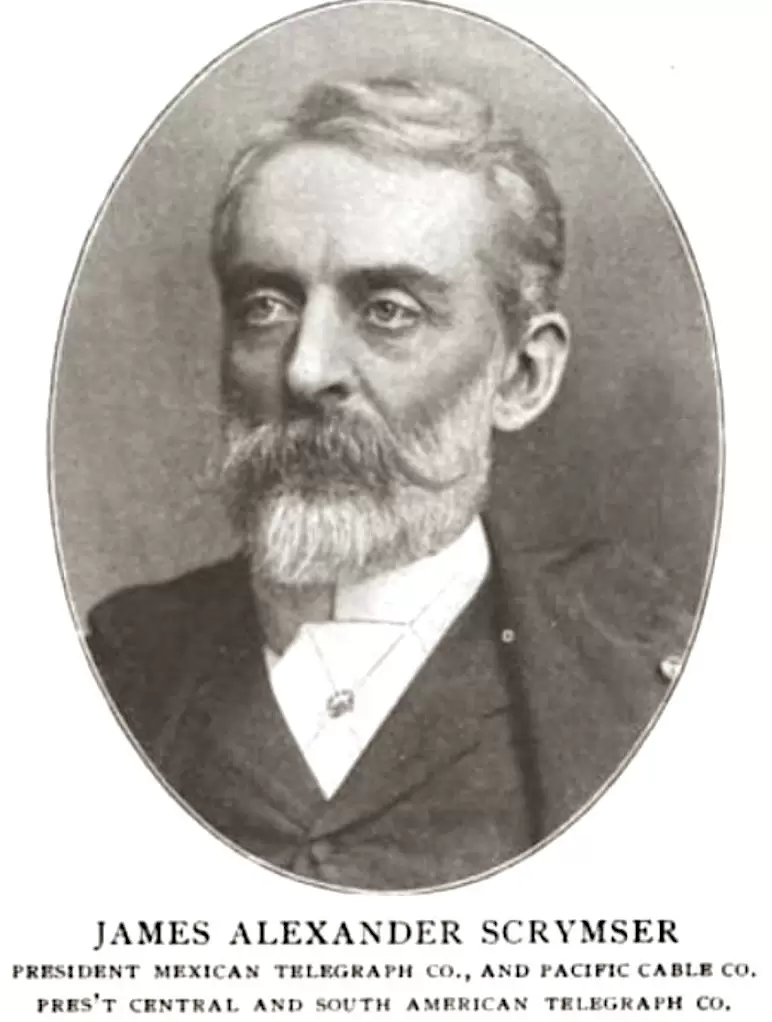
SCUDDER, JOSEPH (1826-1877). Chaplain, 59th New York Infantry. Born in India, he enlisted as a chaplain at New York City on November 13, 1861, was commissioned into the Field and Staff of the 59th New York the same day, and was discharged on November 6, 1862. He last resided in Red Hook, Brooklyn. His death was recorded in cemetery records as “of the brain.” Section 92, lot 2618.
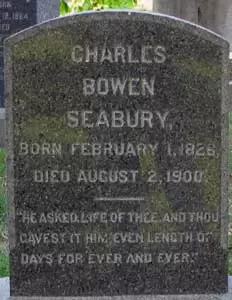
SEABURY, CHARLES BOWEN (1826-1900). Private, 8th Regiment, New York State Militia, Company F. Seabury, who was born in New York State, enlisted in 1861 and served with the 8th Regiment for its 30-day activation. He last lived at 326 West 51st Street in Manhattan. The cause of his death was chronic nephritis. Section 9, lot 5287.
SEACH, THOMAS (1829-1866). Musician, 74th New York Infantry, Company H. Of Irish origin, Seach was a musician with the 74th New York. Further details are unknown. He died in New York City’s Bellevue Hospital from consumption. Section 121, lot 7639, grave 44.
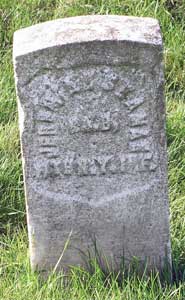
SEAMAN, JEREMIAH (1837-1900). Private, 11th New York Infantry, Company B. Serving in 1861, he enlisted at New York City on April 20, mustered into the 11th New York on May 7, and was discharged for disability at Newport News, Virginia, on October 22. Seaman’s death was caused by chronic nephritis. Section 17, lot 17245, grave 2023.
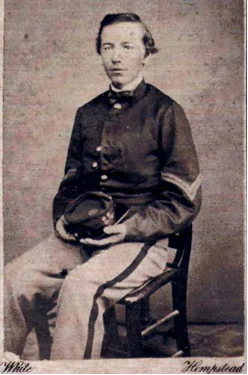
SEAMAN, JOHN WHITSON (1843-1922). Private, 95th New York Infantry, Companies I and H. Seaman, who was born in Wantagh, New York, was a Quaker who served with the 95th New York. According to family lore, many in his family were shocked when he enlisted, and his mother never spoke to him again. In the first of many letters to his sister, he wrote from Bristoe’s Station, Virginia, on October 23, 1863, lamenting the lack of proper stationery for corresponding to ladies and added, “…P.S. Dear sister, all that I have time to write now is that I am well contented & happy in the conviction of doing my duty to my God my country & myself. I have many hardships & privations to endure — more than I am willing to acquaint you with, & three years seems a long time but never fear for me. If I come home I shall come the same John W Seaman in every respect that I left.”
On April 23, 1864, Seaman wrote from Culpepper, Virginia, “…If I should by any chance get taken prisoner you should not feel so worried because they are speedily exchanged now, & if I am wounded I will contrive to let you know…” That same letter also indicated a promotion to corporal but that promotion was not mentioned in his soldier history. A month later, he was wounded in the right arm, near the elbow, at the Battle of the Wilderness, Virginia, on May 3, 1864, was captured and escaped a few days later, and then sent to the hospital. He wrote to his sister from his hospital bed in Fredericksburg, Virginia, on May 13, “The Regiment is almost annihilated. Poor Mad (his best friend) is dead, shot by my side in the same volley that wounded me. We both fell together. Our men were driven back & I was taken prisoner. But since, with some others, made our escape in our lines, the wounded not being guarded.”
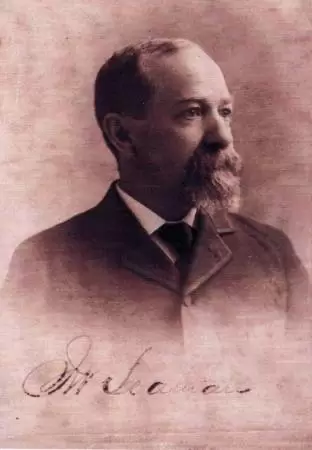
In another letter, written on May 19, Seaman told his sister not to write since mail delivery was haphazard and explained how he and three others spent two days in the woods during their escape. Of being taken prisoner, he related, “They took almost everything from me but my knife and that they offered to buy. Gave me $12 in 50 cent bills, said when I got to Richmond they would come in handy but I could not see that part of it.” Transferred to Grant’s General Hospital in Willets Point, New York, on October 8, 1864, he wrote to describe an operation to straighten his arm, “You cannot imagine what a funny sensation the ether gave me just as I was coming out of it. It was rather pleasant than otherwise. The boys are all laughing at me & telling the funny speeches that I made of which I have no recollection whatever & tell them I do not believe them.”
A week later, on October 14, he contemplated whether to return to his regiment or go to the Invalid Corps, “…Last night the Dr. asked me again which I had rather do. I then thought of you at home & know it would cause you some uneasiness to have me go back. I told him then that my friend wished me to go in the Invalids & as my arm & hand was weak, if I had the choice still left to me, I believed I would go there. He said he would see. So that is all I know about it. Have not heard anything since & may not any more for weeks…” He then served with Company H of the 95th in 1865, re-enlisting and mustering in at Tarrytown, New York, on January 24 and mustering out in Virginia on July 16.
Seaman wrote to his sister about adjusting to civilian life on June 26, “…Every thing of course is new & strange & I have a little more difficulty with the books than I anticipated. The money bothers me the most as there is so much counterfeit in circulation. Therefore I fear I am not worth much to Mr. Jones at present, but hope to soon learn something of business.” On November 23, 1865, his letter noted that he took care of official matters, “…I went yesterday to see about my pension & found everything lovely. My papers were already there from Washington & all that I had to do was to go to the Pension Office, take the Oath of Allegiance…” As per his obituary in the Brooklyn Standard Union, he lived in Wantagh until the last four months of his life and worked as a bank clerk. He last lived at 1236 Pacific Street in Brooklyn. His death was attributed to senility. Section 161, lot 11543.
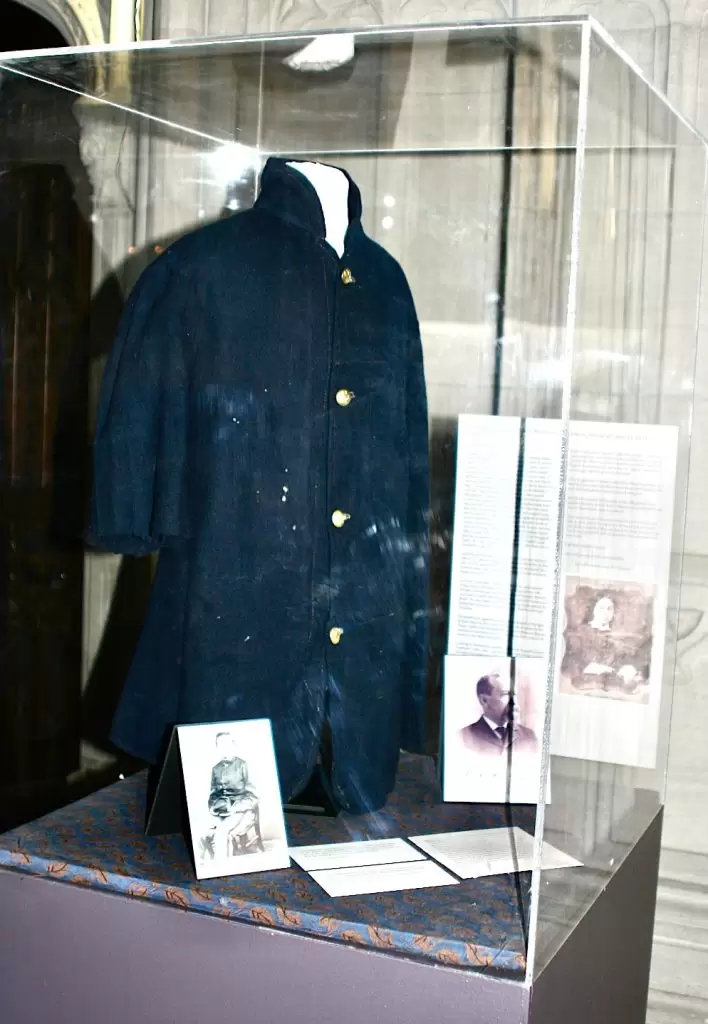
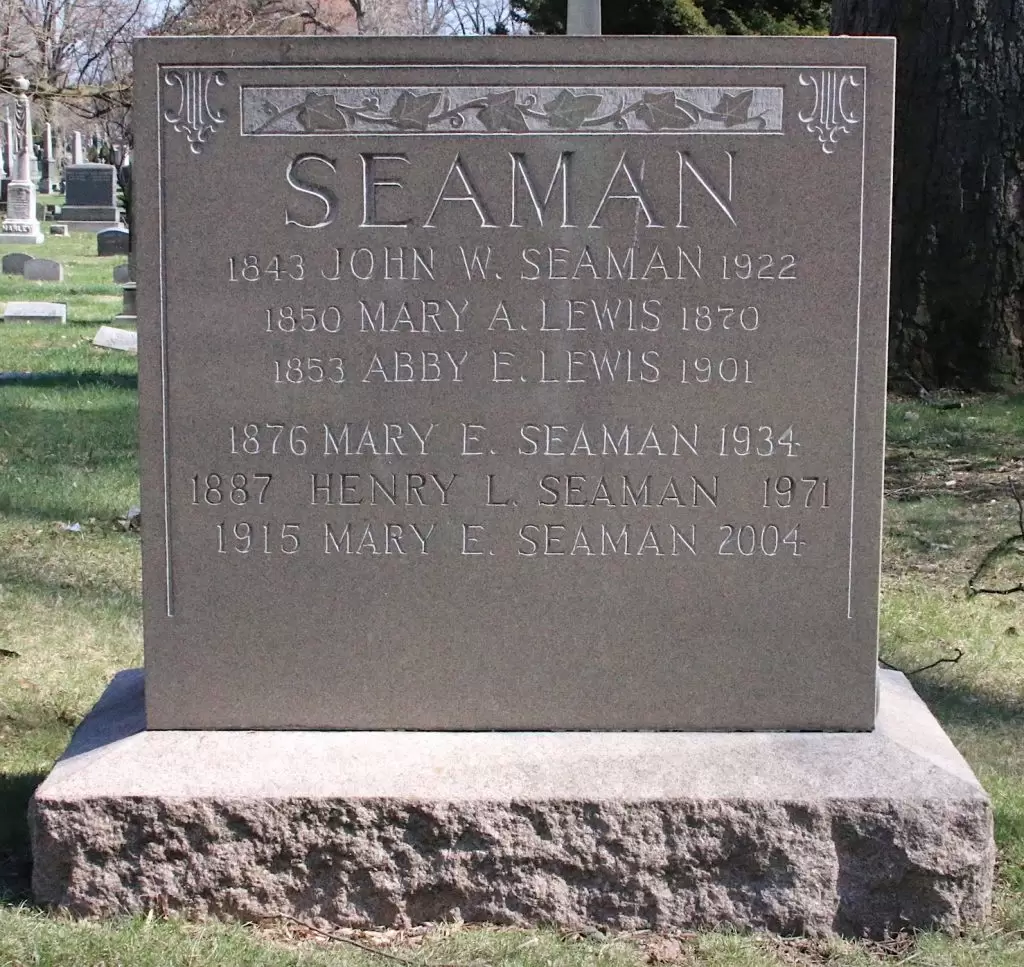
SEAMAN, WILLIAM S. (1836-1882). Sergeant, 13th Regiment, New York State National Guard, Company C. A Brooklyn resident, he enlisted as a sergeant on May 28, 1862, mustered into the 13th Regiment, and mustered out with his comrades on September 12, 1862, at Brooklyn. As per his obituary, which indicated a military funeral, he was active in the 13th Regiment for many years; members of his company escorted his body to Green-Wood, preceded by the Brooklyn Band. Seaman last lived on Fulton Avenue in Brooklyn. His death was caused by asthenia, an abnormal weakness or loss of energy. Originally buried in lot 8999, grave 486, his remains were removed from Green-Wood on October 17, 1868.
SEAVER, DANA B. (1833-1883). Captain, 37th Regiment, New York State National Guard, Company H. Originally from Boston, Massachusetts, Seaver enlisted at New York City as a second lieutenant on May 29, 1862, the same day that he was commissioned into Company H of the 37th Regiment. He mustered out three months later on September 2 at New York City. On June 24, 1863, he was promoted to first lieutenant, served 30 days with the same company and regiment, and mustered out on July 22 at New York City. After a promotion to captain on May 6, 1864, he returned to his unit for 30 days and on June 6, 1864, was discharged at Fort Richmond, New York Harbor. A traveling salesman for a Manhattan wholesale liquor dealer, he was found dead in his bed at the Grand Union Hotel in New Haven, Connecticut, of an apparent heart attack according to his obituary in The New York Times. His last residence was 269 Ryerson Street in Brooklyn. Section 186, lot 19620.
SEBERT, JOHN S. (1833-1877). Private, 4th New York Heavy Artillery, Battery G. A native of New York City, Sebert enlisted there on September 16, 1862, as a private. On that date, he mustered into Battery G of the 4th New York Heavy Artillery, and was dishonorably discharged on July 16, 1864. His last residence was 231 Sullivan Street in Manhattan. Sebert succumbed to phthisis (tuberculosis.) Section 189, lot 16396.
SEBRING (or SEABRING, SEYBRING, SABRING), ALFRED A. (1845-1862). Private, 5th New York Cavalry, Company I. Sebring was born in Wisconsin. His surname appeared on the rolls as Seabring, Seybring or Sabring. After enlisting as a private at New York City on October 6, 1861, he mustered into Company I of the 5th New York Cavalry, also known as the Ira Harris Cavalry, on October 31. As per his obituary in the Daily Tribune, which confirms his Civil War service, he died of typhoid fever on April 15, 1862, at Douglas Hospital in Washington, D.C. He last lived in Mount Vernon, New York. Section ?, lot 8999, grave 893.
SEE, WILLIAM H. (1825-1886). Captain, 32nd New York Infantry, Company H. A New Yorker by birth, he enlisted on May 2, 1861, at Tarrytown, New York, as a first lieutenant, and was commissioned into the 32nd New York on May 31. He was promoted to captain on July 21, 1862, and dismissed on March 20, 1863. He last resided at 60 East 124th Street in Manhattan. His death was caused by nephritis. Section 15, lot 8218.
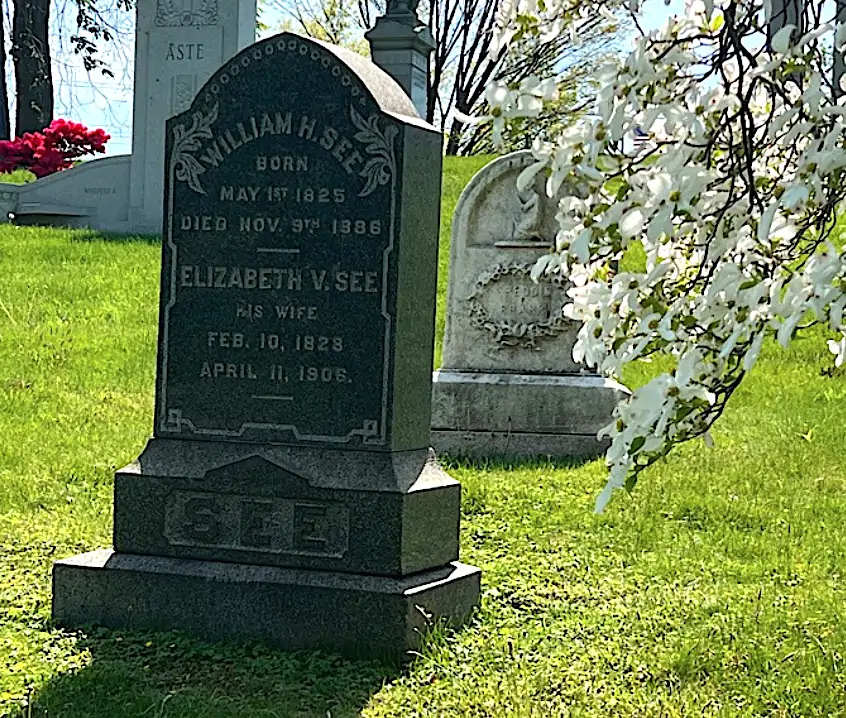
SEEBACH, WILLIAM (1825-1870). Captain, 11th Regiment, New York State National Guard, Company K. Born in Germany, he enlisted as a captain on May 28, 1862, was commissioned into the 11th Regiment that same day, and mustered out after three months on September 16 at New York City. When his unit was reactivated a year later, he was commissioned into the same regiment and company on June 16, 1863, and mustered out after 30 days on July 20 at New York City. He last lived on 84th Street in Brooklyn. Section 117, lot 10975, grave 91.
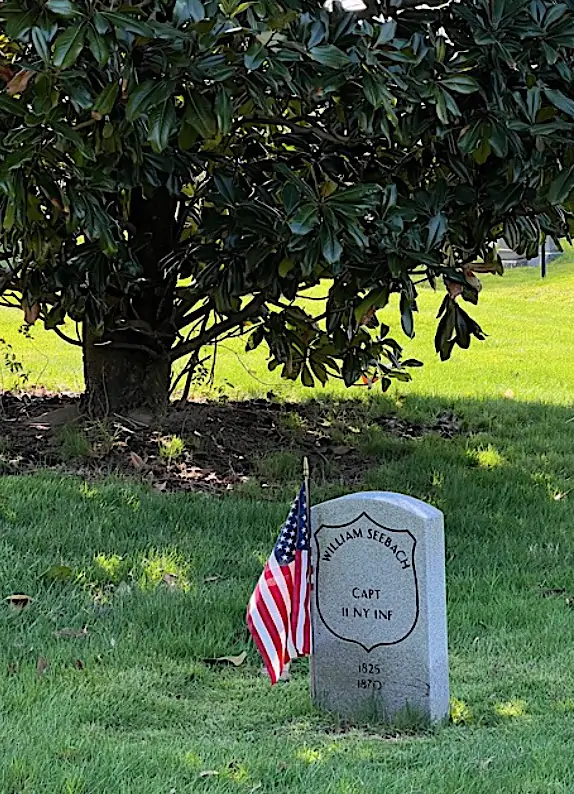
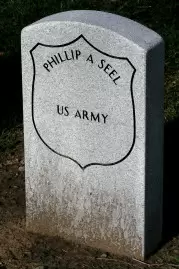
SEEL, PHILIP A. (1823-1877). Corporal, 7th New York Infantry, Company H. Born in Germany, Seel enlisted at New York City as a private on August 20, 1861, and mustered into Company H of the 7th New York three days later. He was wounded at the Battle of Fredericksburg, Virginia, on December 13, 1862. During the period of his service, he was promoted to the rank of corporal and was discharged on April 30, 1863. His death, on April 5, 1877, was reported to have been caused by the wounds received and the illness contracted during his service, according to the testimony of the Commander, George H. Moser, of the Riker Post #62 of the Grand Army of the Republic. His last residence was at 15 East 3rd Street, Manhattan. A government-issued stone was ordered for him early in the 20th century. Section 115, lot 13536 (Soldiers’ Lot).
SEELY, GEORGE W. (1844-1896). Corporal, 22nd Regiment, New York State National Guard, Company K. Seely served with his company in the 22nd Regiment for 30 days in 1863. He last resided at 88 Putman Avenue in Brooklyn. His remains were moved to the current location on October 14, 1910. Section 207, lot 3307, grave 2.
SEERY, PETER (1826-1891). Private, 24th New York Cavalry, Company L; 1st New York Provisional Cavalry, Company L. Of Irish origin, Seery enlisted at New York City as a private on February 13, 1865, and mustered into the 24th New York Cavalry ten days later. He transferred on June 17, 1865, when his unit was consolidated into the 1st New York Provisional Cavalry and mustered out of military service on July 19, 1865, at Cloud’s Mills, Virginia. Seery belonged to the Clarence D. Mackenzie Post #399 of the G.A.R. His last residence was 201 St. Marks Place in Brooklyn. His death was caused by an ulcer. Section 180, lot 13561.
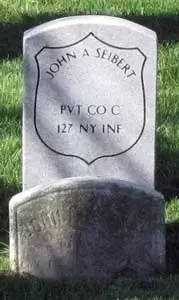
SEIBERT, JOHN ALEXANDER (1843-1886). Private, 127th New York Infantry, Company C. Born in Newburgh, New York, Seibert enlisted at Brooklyn as a private on August 30, 1862, mustered into the 127th New York on September 8, and mustered out on June 30, 1865, at Charleston, South Carolina. He was a member of the Henry M. Lee Post #21 of the G.A.R. His application for an invalid pension in 1885 was granted, certificate 309,455. He last resided at 52 Ralph Avenue in Brooklyn. At some point after his death from phthisis, his wife applied for and received a widow’s pension, certificate 229,648. Section 47, lot 5883.
SEIFFERT, JOHN (or GEORGE) (1824-1884). Private, 41st New York Infantry, Company G. Of German birth, Seiffert enlisted at New York City as a private on June 6, 1861, mustered into the 41st New York on that date, and mustered out on June 9, 1864, at Hilton Head, South Carolina. His last residence was 85 Eldridge Street in Manhattan. He succumbed to Bright’s disease. Section 13, lot 19694, grave 122.
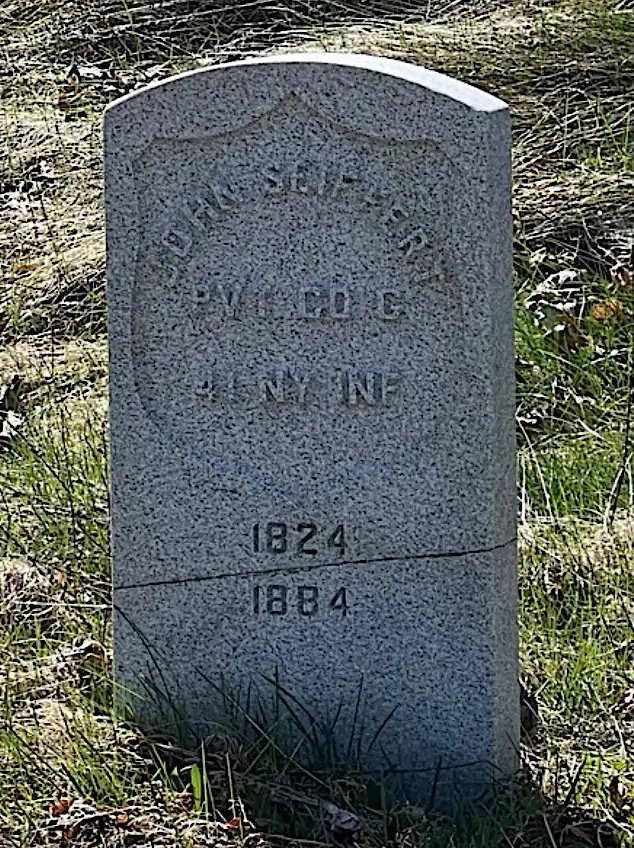
SELLECK, ROBERT L. (1825-1895). First lieutenant, 158th New York Infantry, Company F. He enlisted at Brooklyn and was commissioned into the 158th New York on August 26, 1862, and was discharged on July 16, 1863. At the time of his death. caused by diabetes, he was a resident of Brooklyn. Section 27, lot 8801.
SELMES, GEORGE M. (1847-1873). Private, 8th Infantry, United States Army, Company A. Selmes, who was born in New York State, served as a private in the 8th Infantry of the Regular United States Army. He enlisted on April 12, 1864, at New York City and was discharged on January 14, 1866. At the time of his enlistment, he was 5′ 6½” tall with hazel eyes, brown hair and a fair complexion. According to the 1870 census, he was a farmer. His last residence was in Middletown, New York. Section 17, lot 17245 , grave 183.
SELPHO, WILLIAM (1811-1890). Inventor and manufacturer of prosthetic limbs. Of English origin, Selpho immigrated to New York City in 1839 where he introduced his skills as a designer and manufacturer of prosthetics that he had learned in his homeland. Kim Norton wrote about Selpho in “A Brief History of Prosthetics,” an article that appeared in the magazine In Motion (November/December 2007). Norton noted that Selpho introduced the “Anglesey Leg,” first developed in Great Britain in 1800, to the United States in 1839, where it became known as the “Selpho Leg.” This prosthesis consisted of a wooden shank and socket, a steel knee joint and an articulated foot. The leg was controlled by catgut tendons that extended from the knee to the ankle. His undated pamphlet, “Selpho’s Patent Anglesey Leg, Artificial Arm; the Best Substitutes for Natural Limbs the World of Science Has Ever Invented,” is in the Harvard Library. His name, associated with prosthetic devices, appears in the New York City Business Directories beginning in 1843.
Selpho’s products were endorsed by the renowned surgeon Dr. Valentine Mott (see), who wrote his endorsement in 1851 that was included in later undated advertisements for the artificial limbs, “Best of all is the proof of those who wear them [Selpho’s legs]. …Some of my friends, whom I have mutilated, inform me that they are superior to all others.” In 1856, Selpho improved his design by patenting a knee controller with a rubber toe and sole.
As per the census of 1860, Selpho lived in Brooklyn with his wife and two sons, William and Edwin, and was in the artificial limb business; his real estate was valued at $30,000 and his personal estate was worth $3,000 (the total of $33,000 being the equivalent of just over $1 million in 2019 money). The 1865 New York State census reports that Selpho lived in Brooklyn with his two adult sons.
According to Ed Grabianowski’s article, “From Wooden Legs to Carbon Fiber Hands: How Technology Improves Prosthetic Limbs,” in Clarkesworld Magazine (May 2014), the number of amputees returning home from the Civil War motivated Selpho and other researchers to improve prostheses. Selpho’s design for an artificial arm included a control mechanism that improved the simple static hook. A strap running to the opposite shoulder could be pulled taut by shoulder movements or shrugging thereby activating a mechanism in the prosthetic hand that enabled the fingers to open and close. This innovation helped improve the quality of life for amputees. Norton also noted that Selpho made refinements in his mechanisms for artificial legs as the number of amputations during the Civil War rose astronomically.
The government provided Selpho’s prostheses, known for their lightness, simplicity and durability, at no charge to soldiers. Selpho’s twenty-six page illustrated book, “Mechanical Surgery as Applied to the Construction of Artificial Limbs,” published in 1867, is now in the Yale University Medical Library. William Selpho, listed as “son,” was working in “limbs” in the 1867 New York City Directory. His patent for artificial legs was extended on April 29, 1870. According to the 1870 census, he lived in Brooklyn with his two sons and was an artificial limb maker; his real estate was valued at $50,000 and his personal estate was worth $30,000. He retired in about 1872 when his son took sick and they travelled to Europe to restore his health. The 1880 census notes that he was a widower, lived at 149 Pierrepont Street in Brooklyn and was retired. An article in the New York Sun on September 26, 1881, “Making the Maimed Whole,” which confirmed that Selpho was instrumental in bringing artificial limbs to the United States, noted that 50,000 Americans were fitted with prosthetic limbs at that time, most of whom were maimed by railroads. The article stated that only 9,000 or 10,000 Civil War pensioners were fitted for the devices, which were replaced free of charge by the government, every five years. Selpho is listed as a member of the Long Island (now Brooklyn) Historical Society in 1882. Section 170, lot 13822.
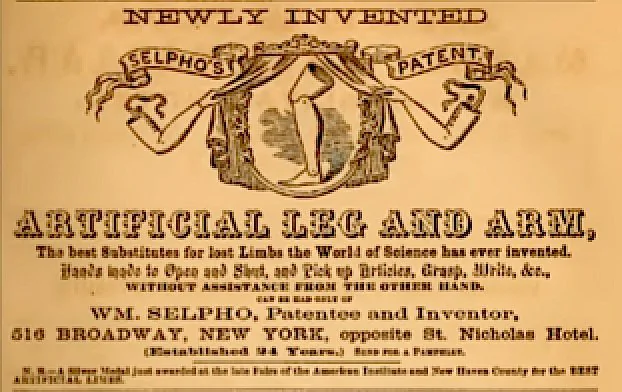
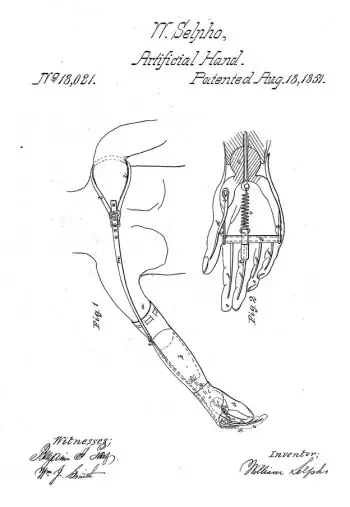
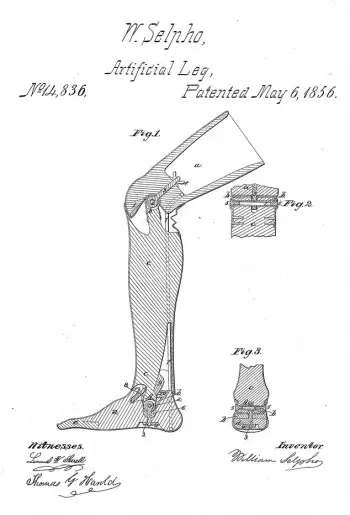
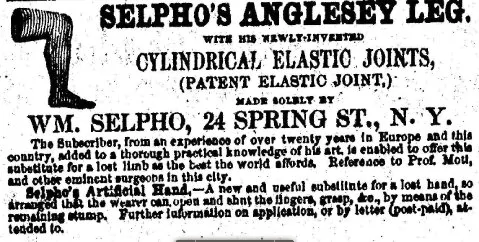
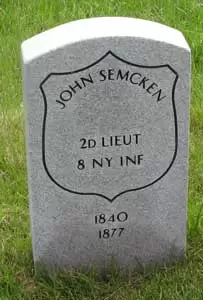
SEMCKEN, JOHN (1840-1877). Second lieutenant, 8th Regiment, New York State Militia, Companies G and E. A New York State native (although one document incorrectly says that he arrived in New York City as an immigrant in 1840), Semcken enlisted as a private at New York City on April 20, 1861, mustered into Company G of the 8th Regiment, and mustered out at New York City on August 2. On May 29, 1862, he was commissioned a second lieutenant in Company E of the 8th Regiment, New York State National Guard, and mustered out after three months on September 29 at New York City.
According the the IRS Assessment List for 1865, John Semcken & Co., retail dealers in liquor, was located at 486 Cherry Street in New York City. He was listed as being in the liquor business in the 1872 New York City Directory. At the time he applied for a passport in 1873 (listing his birthplace as New York City), he was 5′ 10½” tall with blue eyes, brown hair, fair complexion, high forehead, straight nose, medium mouth, round chin and a round face. In 1874, he was elected recording secretary of the New York Liquor-dealers’ Protective Union. The 1877 and 1878 New York City Directories state that he was in the liquor business. His last residence was 29 Corlear Street, New York City. He died from heart disease. Section 58, lot 1403.
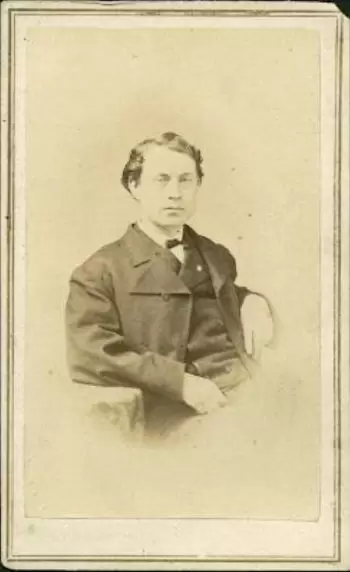
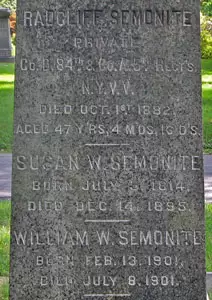
SEMONITE, RADCLIFFE (1835-1882). Private, 84th New York (14th Brooklyn) Infantry, Company D; 5th New York Veterans Infantry, Company A. He enlisted on August 22, 1862, at Brooklyn, and mustered into the 14th Brooklyn on August 28. He transferred into the 5th Veterans on June 2, 1864, and mustered out at Alexandria, Virginia, on May 31, 1865. His death was caused by phthisis. Section 141, lot 23991.
SENGENS, ADAM (1818-1890). Private, 31st New York Infantry, Companies F, B, and H. Born in Germany, Sengens enlisted as a private at New York City on May 27, 1861, and mustered into Company F of the 31st New York. During his service, he was transferred within the regiment to Company B, Company H, and back to Company F. He was discharged for disability from Fairfax General Hospital at Alexandria, Virginia, on July 7, 1862. His last residence was 247 East 41st Street in Manhattan. His death was due to peritonitis. Section 6, lot 20118, grave 279.
SENIOR, ALFRED H. (1836-1921). Corporal, 71st Regiment, New York State Militia, Company A. Born in New York City, Senior enlisted as a corporal and served for three months in 1861 with the 71st Regiment. He was reduced in rank to private before he was discharged. He applied for an invalid pension in 1890, application 907,346, but there is no certificate number. His last residence was 135 Elm Street, Newark, New Jersey. Section 13, lot 9608.
SENNE (or SENNA), ERNEST (1849-1911). Musician, 82nd Illinois Infantry, Companies K and G; 2nd Missouri Infantry, Companies I and B; 2nd United States Infantry, Company D, F, G and Band; private, 16th New York Cavalry, Company C. A resident of Belleville, Illinois, he enlisted on August 15, 1862, as a private, and mustered into Company K of the 82nd Illinois on September 26. Records indicate that he deserted from his unit. Subsequently, Senne enlisted as a private at Camp Wyndam, New York, on August 6, 1863, the same date that he mustered into the 16th New York Cavalry. On February 2, 1864, he transferred into the 82nd Illinois Infantry from which he deserted on April 17, 1864. However, this might be an error since his pension record shows additional service as a musician in the 2nd Missouri Infantry and the 2nd United States Infantry.
Service records state that he enlisted in the 2nd U.S. Infantry on January 12, 1865, and re-enlisted on January 28, 1868. He is listed as a deserter at Sandusky, Ohio, on an unknown date. In 1902, he received a pension, certificate 1,026,189; if he had been a deserter, he would not have received a pension. Rebecca Senna, who is interred with him, applied for and received a widow’s pension shortly after his death in 1911, certificate 725,126. Section 206, lot 21347.
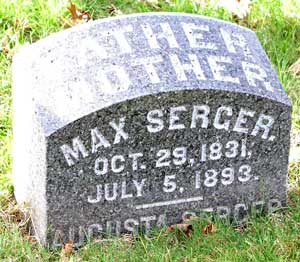
SERGER, MAX (1831-1893). Quartermaster sergeant, 41st New York Infantry, Companies D, H, C, and F. A German native, Serger enlisted at New York City as a first sergeant on June 6, 1861, and immediately mustered into Company D of the 41st New York. On March 1, 1862, he was reduced in rank to sergeant and transferred into Company H. Subsequently, he was promoted to quartermaster sergeant and transferred into the Field and Staff on January 1, 1863. Later that year, he was reduced in rank to sergeant and transferred to Company C on April 14, and then transferred into Company F on December 5. He mustered out on June 27, 1864, at New York City.
In 1890, Serger’s application for an invalid pension was granted, certificate 826,465. His last residence was on Charles Street in Manhattan. Upon his death in 1893, Augusta Serger, who is interred with him, applied for and received a widow’s pension, certificate 383,888. Section 121, lot 15734.
SERRELL, EDWARD WELLMAN (1826-1906). Brigadier general by brevet; colonel of engineers, 10th Army Corps; colonel, 1st New York Volunteer Engineers. Serrell is not buried at Green-Wood; the cenotaph in his family’s lot honors his memory. Born in London, England, Serrell’s family immigrated to the United States in 1831, although an article in The New York Times mistakenly listed him as being born in New York City. A civil engineer, he engaged in railroad and bridge design beginning in 1845 as an assistant engineer for the Central Railroad of New Jersey. He then was involved in projects in the United States, Panama, Canada and England. Also a financier, he was associated with the Credit Mobilier who was responsible for funding the Union Pacific Railroad.
At the outbreak of the Civil War, Serrell enlisted as a lieutenant colonel in 1861 and was commissioned into the Field and Staff of the 1st New York Volunteer Engineers, a regiment that he helped raise and later led as its colonel. Subsequently, he was promoted to Colonel of Engineers in the 10th Army Corps under General Benjamin P. Butler and was his chief of staff in 1864. In the latter capacity, he designed and supervised the construction of the “Swamp Angel,” a huge muzzle-loading artillery rifle that took part in the Union bombardment of Charleston, South Carolina. In all, he participated in 126 actions of the Civil War. On March 13, 1865, he was promoted to brigadier general by brevet for “meritorious services during the war.”
Among the inventions and ideas credited to Serrell were long wire, armor plate, impromptu gun carriages and iron viaducts. He even attempted, unsuccessfully, to develop a helicopter-like flying machine. After the Civil War, he was a consulting engineer for many corporations, wrote reports on bridges and canals, was consulting engineer to the American Isthmus Ship Canal Company, and was president of the Washington County Railroad dating from 1887. According to an article in The New York Times on December 1, 1880, Serrell was present at a meeting organizing the Lafayette Post #140 of the G.A.R. which hoped to establish a museum containing artifacts from American wars that might be of interest to foreigners or other students of history. He was an honorary pallbearer at the funeral of U.S. Grant.
As per an article in The New York Times on September 8, 1900, he married a family friend at a time when he was critically ill. A widower at that time, his new wife, Marion Roorbach, hoped to bring him to her Staten Island home and nurse him back to health but in the end, he outlived her. According to his obituary in the New York Herald, he was a member for eighteen years of the General Society of Mechanics and Tradesmen of the City of New York, the Loyal Legion, the Department of the South and South Atlantic Blockading Squadron Association, and the 1st New York Volunteer Engineer Veterans’ Association, of which he had been commander and president. The obituary confirmed his membership in the Lafayette Post of the G.A.R. and requested its comrades to attend his funeral in uniform. Serrell is buried in Saint Luke’s Cemetery in Staten Island. The cenotaph that bears his name at Green-Wood reads, “In Loving Memory of Marion Seaton, Daughter of Orville W. Roorbach Sr. and Wife of Gen. Edward W. Serrell, Born 1844, Died 1904.” Section 182, lot 9579.
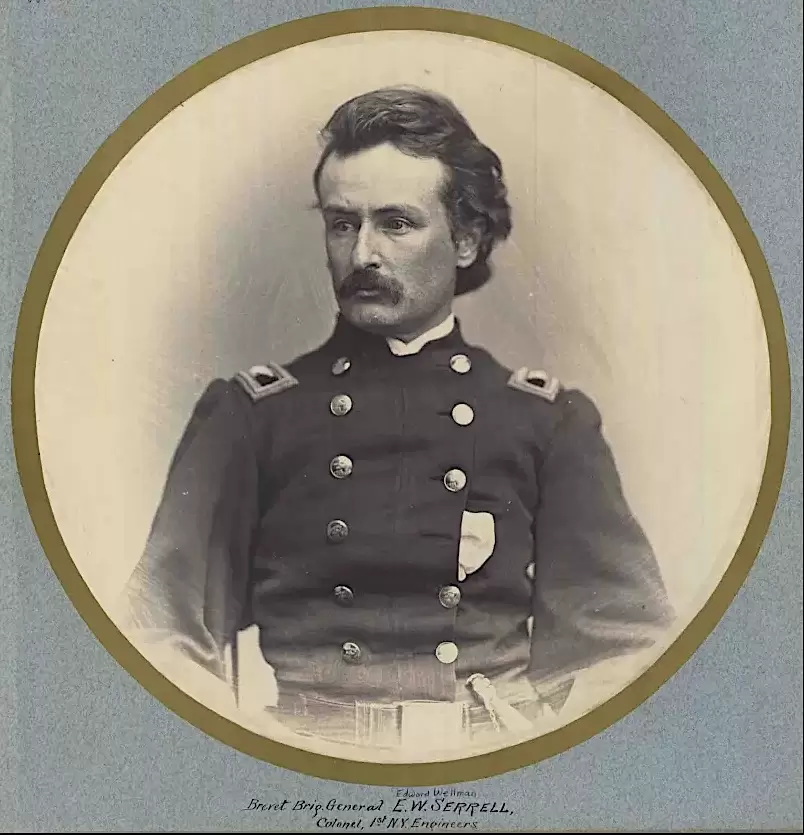
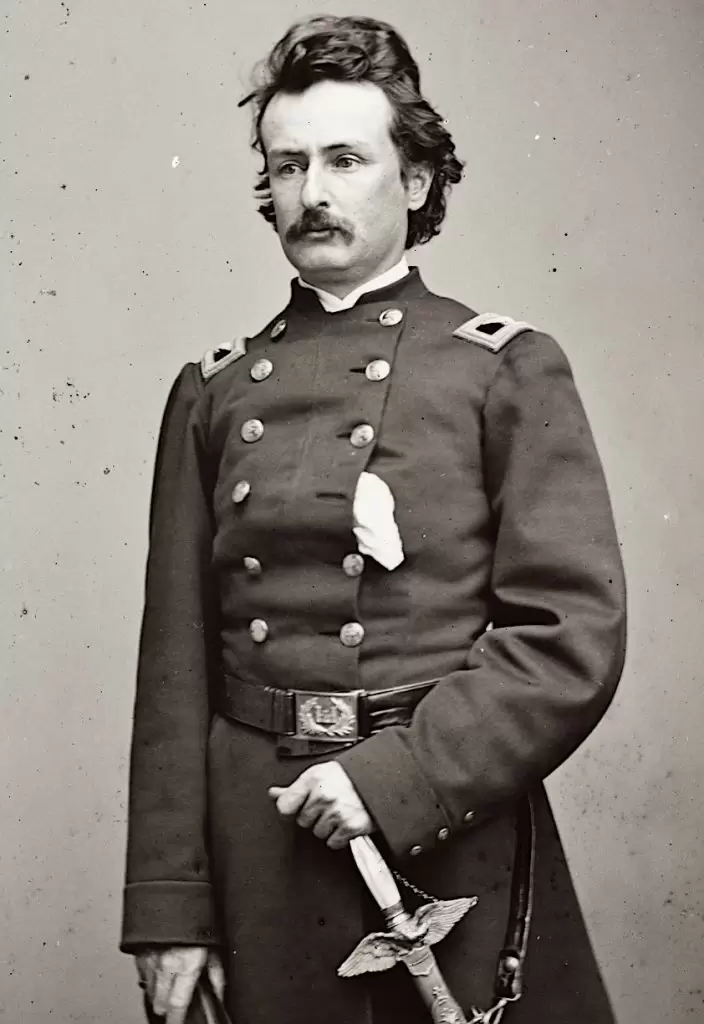
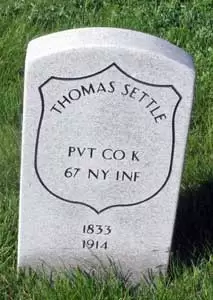
SETTLE, THOMAS (1833-1914). Private, 67th New York Infantry, Company K. Of English origin, Settle enlisted at New York City as a private on June 4, 1861, and mustered into the 67th New York on June 24. He deserted on November 30, 1861, at Washington, D.C. His last residence was 52 New Street in East Orange, New Jersey. Section 15, lot 17263, grave 1458.
SEVERS, CHARLES H. (1841-1912). Private, 4th New Jersey Infantry, Company B. Originally from New Jersey (although one document says Philadelphia, Pennsylvania), Severs married Jane Elizabeth Hudson in 1862; the couple had three children. During the Civil War, he enlisted as a private on May 14, 1864, and mustered immediately into Company B of the 4th New Jersey Infantry. According to his obituary in the Brooklyn Standard Union, Severs was one of the men who escaped from the infamous Libby Prison by tunneling his way out. Further details of his incarceration and escape are unknown. However, this may not be accurate; Libby became a prison for Union officers, not privates, in 1862. On July 9, 1865, he mustered out at Hall’s Hill, Virginia.
In 1881, Severs applied for and received an invalid pension, certificate 1,087,649. A member of the G.A.R., he was prominent in real estate in the Parkville section of Brooklyn. He last lived at 260 Washington Avenue in Brooklyn. After his death from arteriosclerosis in 1912, his wife applied for and was awarded a widow’s pension, certificate 737,730. Section J, lot 33688.
SEWELL, GEORGE (1824-1895). Chief engineer, United States Navy. After enlisting as an acting second assistant engineer on March 13, 1847, Sewell joined the United States Navy. He was promoted to first assistant engineer on July 10, 1847, then promoted to chief engineer on July 15, 1852, serving in that rank during the Civil War. Pursuant to an Act of Congress on July 15, 1870, his promotion to chief engineer was effective as of March 11, 1851. He retired from the United States Navy on December 17, 1885. A member of the Grand Army of the Republic as of December 1889, his last residence was 177 Putnam Avenue in Brooklyn. His death was caused by pulmonary congestion. Section 154, lot 27249, grave 4.
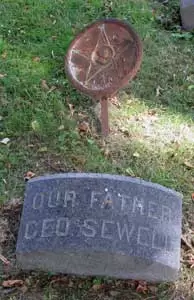
SEWELL, THOMAS P. (1845-1868). Private, 13th Regiment, New York State National Guard, Company F. Born in Brooklyn, he enlisted in 1862 for a period of three months and mustered into Company F of the 13th Regiment (Heavy Artillery). A member of the Ulysses S. Grant Post #327 of the G.A.R., Sewell last resided in Greenbush, New York, where he died of consumption. Section 54, section 7432.
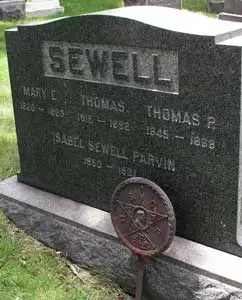
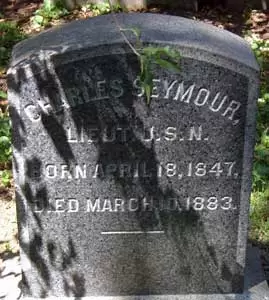
SEYMOUR, CHARLES (1847-1883). Midshipman, United States Navy. Originally from Batavia, New York, he served as a midshipman during the Civil War, beginning his service on July 28, 1864. He was a graduate of the Naval Academy in June 1869, having been made an ensign on April 19 of that year, then rose to master on July 12, 1870, and lieutenant on June 4, 1874. Most likely, he was the brother of Edward Seymour (see). His last residence was in Charlestown, Massachusetts. He succumbed to pneumonia. Section 164, lot 14910.
SEYMOUR, EDWARD (1845-1869). Private, 10th New York Infantry, Company A. A native of Jersey City, New Jersey, he enlisted as a private at New York City on October 10, 1861, mustered into the 10th New York that day, and was discharged for disability on November 4, 1861, at Fort Monroe, Virginia. He was likely the brother of Charles (see). He last lived in Hackensack, New Jersey. His death was attributed to pneumonia. Section 164, lot 14910.
SEYMOUR, GEORGE (1845-1905). Landsman, United States Navy. Seymour, an African-American who was born in New York City, was 5’8″ and a waiter by trade. He enlisted as a landsman for two years at New York City on March 23, 1865. On March 31, he began service aboard the Fort Morgan. He returned to that vessel on June 30 and August 22 of the same year. After the Civil War, he lived in Brooklyn. He died of bronchitis. Section 137, lot 30109, grave 3.
SEYMOUR, JAMES (1836-1861). Private, 84th New York (14th Brooklyn) Infantry, Company H. Seymour’s remains were placed in the Receiving Tomb at Green-Wood on November 24, 1861, but were removed from the cemetery the next day. A native of Orange County, New York, he enlisted at Brooklyn on April 18, 1861, and mustered into the 14th on May 23. He was killed in battle at Falls Church, Virginia, after being shot through his head on November 18, 1861. A resident of Brooklyn, his heroic death was heralded in the local press and solemnities were conducted by the regiment’s chaplain, Reverend J. S. Inskip (see), and attended by members of the 14th who were at home. Services for a fellow soldier, Walter G. Taylor (see), were conducted at the same time. He last lived at 74 Duffield Street in Brooklyn.
SEYMOUR, JAMES C. (1834-1916). Third sergeant, 8th Regiment, New York State Militia, Company B. A New York City native, Seymour enlisted as a private and served in the 8th Regiment for three months in 1861. A year later, he re-enlisted as a corporal on May 29, 1862, mustered immediately into the same regiment and company, now part of the New York State National Guard, and mustered out at New York City on September 10. In 1863, he returned to the 8th Regiment, served for 30 days in the same company as a third sergeant, and mustered out at the expiration of his enlistment. He applied for and was granted an invalid pension in 1896, certificate 909,091. His last address was 756 Kelly Street in the Bronx. He succumbed to broncho pneumonia. Section E, lot 21965, grave 4.
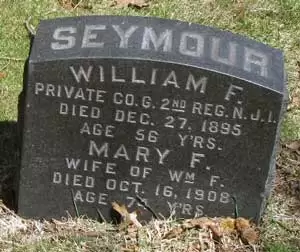
SEYMOUR, WILLIAM F. (1839-1895). Private, 2nd New Jersey Infantry, Company G. Seymour enlisted as a private and mustered into the 2nd New Jersey on June 27, 1861, and mustered out on June 21, 1864, at Newark, New Jersey. He filed for an invalid pension in 1880, certificate 282,727. His last address was 446 Sixth Avenue, Brooklyn. He died of pneumonia. The inscription on his gravestone commemorates his Civil War service. In 1896, Mary Seymour filed for a widow’s pension, certificate 423,978. Section 135, lot 14964, grave 144.
SHAFFORD, GEORGE E. (1841-1907). Sergeant, 83rd New York Infantry, Company G; 97th New York Infantry, Company B. After he enlisted as a private at New York City on September 11, 1861, he mustered into the 83rd New York that same day. He rose to corporal on January 1, 1863, and to sergeant on November 1 of that year. Shafford was wounded and captured as a prisoner of war on May 6, 1864, at The Wilderness, Virginia, and was transferred into the 97th New York on June 7 of that year. He last resided in Manhattan. Shafford’s death was caused by a stomach ulcer. Section 41, lot 23762, grave 1.
SHANNON, FRANCIS (1829-1872). Private, 2nd New York Mounted Rifles, Company E. Of English origin, Shannon enlisted as a private at Covington, New York, the same date that he mustered into the 2nd New York Mounted Rifles. He mustered out on June 9, 1865, from McDougall General Hospital in New York Harbor. He last lived on West 52nd Street in Manhattan. His death was caused by peritonitis. Section 183, lot 20303.
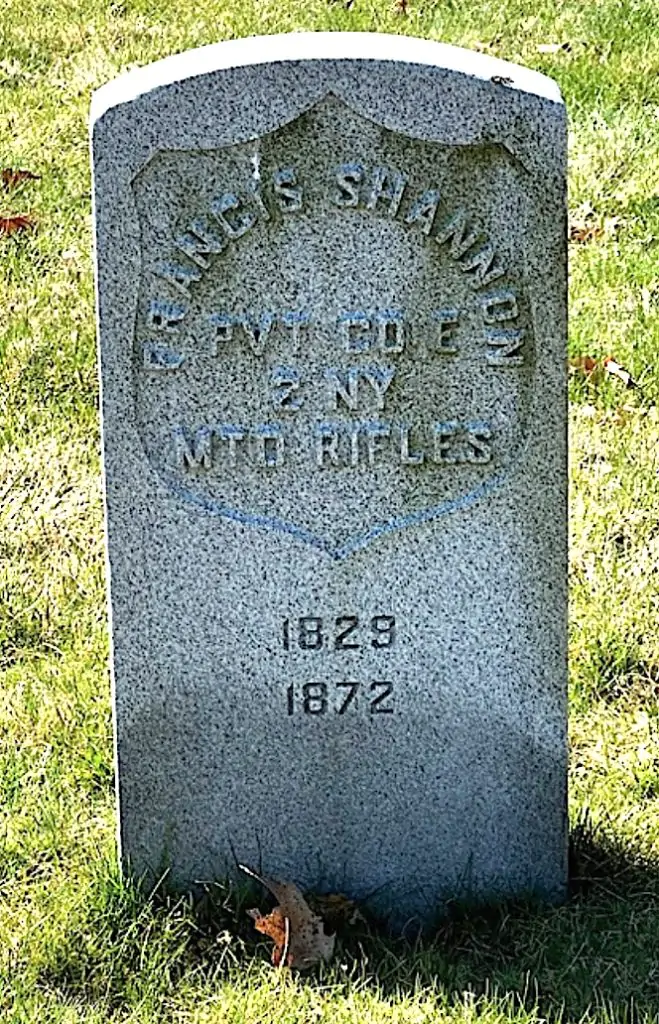
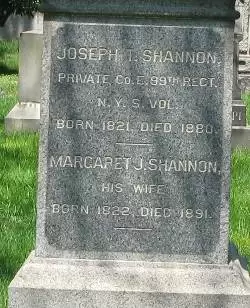
SHANNON, JOSEPH T. (1821-1880). Private, 99th New York Infantry, Company E. Of Irish origin, Shannon enlisted at age 39 at New York City as a private on September 18, 1861, mustered into the 99th New York that same day, and was discharged for disability on August 17, 1863, at Convalescent Camp, Virginia. His last residence was 322 12th Street in Brooklyn. He died of Bright’s disease, a kidney- related disease. Section 187, lot 17872.
SHANNON, WILLIAM F. (1843-1878). Quartermaster sergeant, 1st New York Mounted Rifles, Companies I and M. Born in New York State, Shannon enlisted at New York City as a private on September 4, 1862, the same date that he mustered into Company I of the 1st New York Mounted Rifles. On May 11, 1863, he was promoted to quartermaster sergeant. He re-enlisted on September 20, 1864, transferred intra-regimentally to Company M on July 21, 1865, and mustered out that same day at Richmond, Virginia. In 1877, he applied for an invalid pension, application 240,384, but apparently died before it was certified. His last residence was 306 West 14th Street in Manhattan. His death was attributed to exhaustion. Section 33, lot 4794.
SHAPTER, JOHN F. (1841-1872). Artificer, 1st New York Engineers, Company F; private, 12th Regiment, New York State National Guard, Company I. A native of New York State, Shapter enlisted as a private at New York City in 1862, served with the 12th Regiment for three months, and was discharged at the expiration of his enlistment. On February 13, 1865, he re-enlisted at New York City as a private, mustered immediately into the 1st Engineers, was promoted to artificer on April 1, and mustered out on June 30, 1865, at Richmond, Virginia. He last lived on East 27th Street in Manhattan. He died of phthisis. Section 189, lot 16516.
SHARDLOW, JOSEPH A. (1838-1862). Corporal, 33rd New York Infantry, Company E. Shardlow, a native of New York State, was a farmer in Livingston County according to the census of 1860. He was 6′ 3½” tall with blue eyes, brown hair and a light complexion. After enlisting as a private at Avon, New York, on May 9, 1861, he mustered into the 33rd on May 22. He rose to corporal on June 15, 1862, and succumbed to dysentery at Fort Monroe, Virginia, on September 17 of that year. His body was transported to Brooklyn by the Adams Express Company, a freight and cargo transport business that is now an investment fund headquartered in Maryland. Section 60, lot 3889.
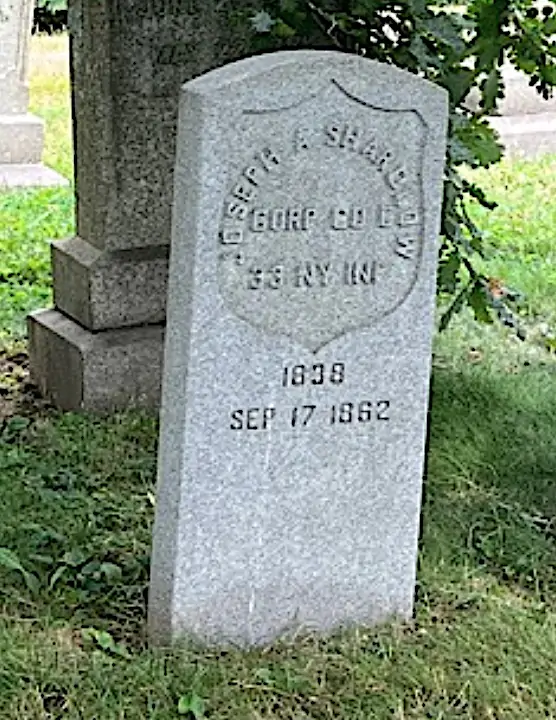
SHARP, GREEN W. (1837-1871). Private, 70th Ohio Infantry, Company A. Sharp served in the 70th Ohio’s Company A. Further details of his service are unknown. His last residence was 621 2nd Avenue in Manhattan where he died from smallpox. Section A, lot 17244, grave 10.
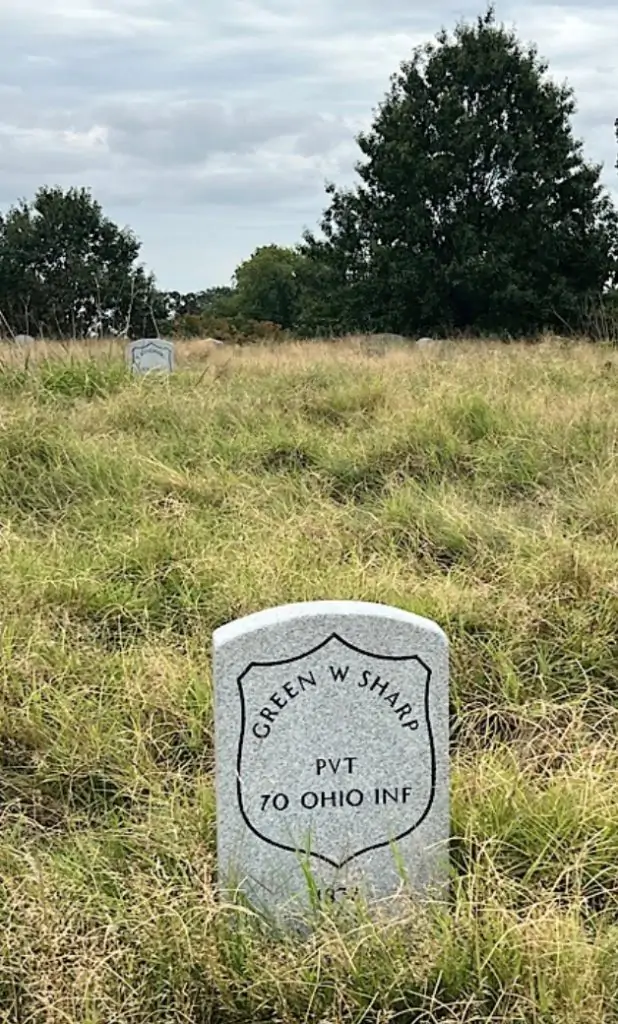
SHARP, JR., ROBERT PHILIP (1837-1914). Private, 8th Regiment, New York State National Guard, Company F. The New York State census of 1855 indicates that he was living in New York City. During the Civil War, Sharp enlisted as a private on May 28, 1862, mustered into the 8th Regiment, and mustered out on September 10, 1862, at New York City. In 1892, his application for an invalid pension was approved, certificate 850,322. He last lived at 37 Marcy Avenue in Brooklyn. His cause of death was nephritis. Section 128, lot 34042, grave 1.
SHARP, WILLIAM (1822-1865). Private, 61st New York Infantry, Companies G and D. He enlisted on August 5, 1864, at Oswego, New York, at age 42, and mustered into Company G of the 61st New York that same day. On December 21, 1864, he was transferred to Company D. Sharp was killed in action at Fort Stedman, Virginia, on March 25, 1865, and was interred at Green-Wood on April 29, 1869 (transferred from Evergreens Cemetery). Section, 174, lot 18318.
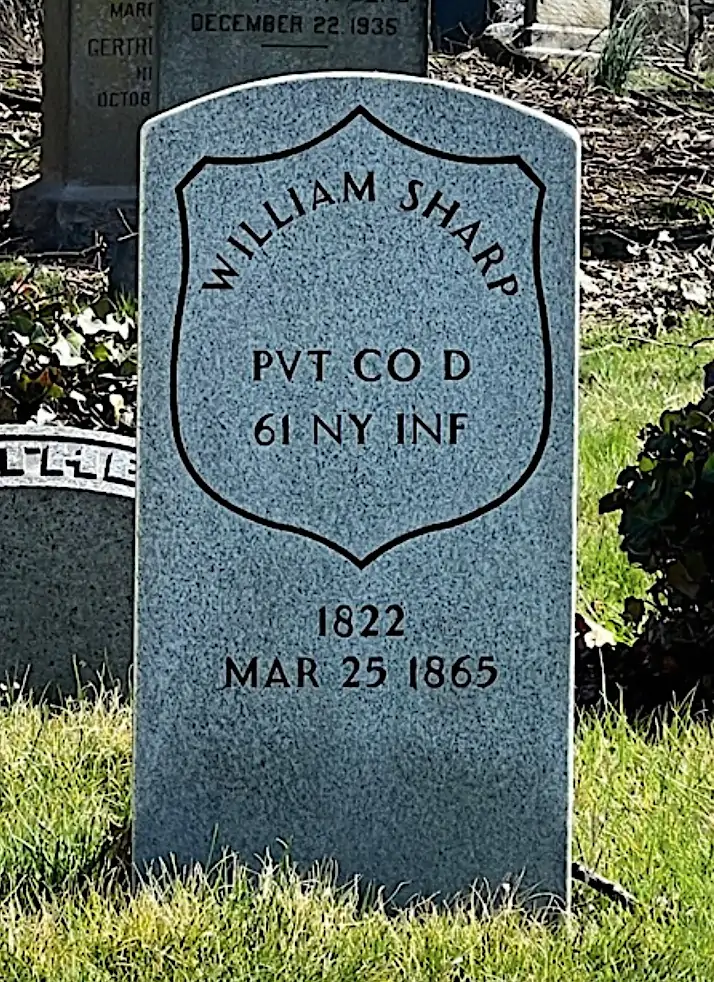
SHAURMAN, NELSON (1820-1880). Brigadier general by brevet; colonel, 90th New York Infantry; private, 13th Regiment, New York State Militia, Company G. Born in New York City, Shaurman was a carpenter, police captain and ferry superintendent before the Civil War. He was also a member of the Brooklyn City Guard, a militia unit, and a baseball player. A much beloved police captain, he was honored by fifty friends and associates who said of him, “…in doing your duty you have never withheld your sympathy from suffering, and have sought to crush out crime and not the criminal.” Shaurman was then presented with a gold watch bearing the seal of the Charter Oak baseball club.
At the onset of the Civil War in April 1861, Shaurman left his position as superintendent of the Union Ferry Company and served in the 13th New York State Militia as a private for three months. The 13th served in Maryland, keeping order, seizing arms, and rooting out secessionist violence in Baltimore and Annapolis. The 13th returned home to a warm welcome and parade at Fulton Ferry Landing in Brooklyn. Shaurman re-entered service in early 1862 as a captain of the 90th New York, which he helped recruit, and was promoted to major in July of that year.
The 90th was assigned to Key West, Florida, where Joseph S. Morgan, the colonel of the regiment, got embroiled in controversy when he freed the slaves there before the Emancipation Proclamation went into effect. Morgan then posted an order that in effect evicted the civilian population of Key West from their homes and into the war zone; this order was in retaliation for crimes committed by Confederate troops. Many officers, but not Shaurman, wrote to the Brooklyn Daily Eagle, tendering their resignations and refusing to carry out the order “which virtually wages war against unoffending women and children and known Union citizens of this Key- imitating as it does that kind of warfare that has cast on our enemies the stigma of all civilized nations.” Morgan’s order was rescinded, Lincoln signed the Lieber Code in April 1863 outlawing the inhumane treatment of enemy civilians, and Morgan was eventually court-martialed for drunkenness and dereliction of duty. He was replaced as commander of the 90th by Shaurman who was promoted to lieutenant colonel in August 1863.
The 90th fought at the siege of Port Hudson, Louisiana, then joined the Army of the Shenandoah in Virginia in September 1863. Shaurman was promoted to colonel in June 1864. At the Battle of Cedar Creek, Virginia, in October 1864, Shaurman was injured by a twenty pound shot that grazed his breast and left arm, severely bruising his body; the Brooklyn Daily Eagle incorrectly reported that he had lost his arm in the fight. On March 13, 1865, Shaurman was brevetted brigadier general of volunteers for his Civil War service.
Shaurman held many jobs during his lifetime. The 1866 Brooklyn Directory lists him as a builder; the 1868 Brooklyn Directory indicates that he was the commissioner of jurors. In addition, he was a livery operator, and was elected city auditor in 1871. In 1873, he ran for City Clerk, but his campaign stumbled when he disclosed that he had been offered, and had rejected, a bribe but he refused to name names. The Brooklyn Daily Eagle accused him of hypocrisy; Shaurman did not budge and lost the election. As of 1877, he was employed as an excise inspector and remained in that position until his death, from apoplexy. According to his obituary in The New York Times, he at one time became wealthy but mismanaged his funds and lost his fortune. His last address was 429 Henry Street in Brooklyn. Section 185, lot 22975.
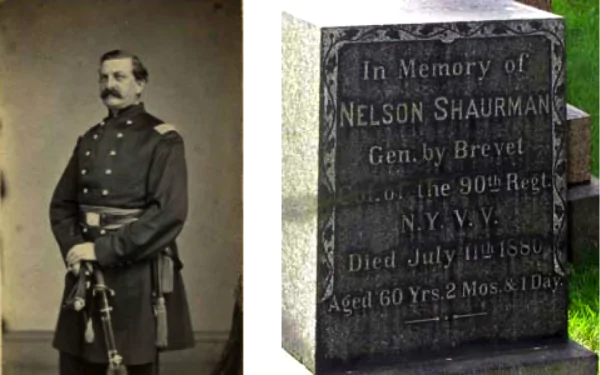
SHAVE, EDWARD A. (1844-1912). Private, 4th New York Light Artillery. Originally from New York City, Shave enlisted there as a private on October 10, 1861, and mustered into the 4th New York Light Artillery on that same day. He deserted on August 22, 1863, at Washington, D.C. The 1880 census reports that he was living in Brooklyn and working as a conductor; the 1909 Directory for Belleville, New Jersey, listed him as a watchman. His cause of death was “collapse of heart and acute attack of indigestion.” Shave last lived at 17 Miller Street in Nutley, New Jersey. In 1930, Annie Shave applied for a widow’s pension, application 1,664,341, but it was not certified. Section 195, lot 25494.
SHAVE (or SHAVER), JOHN (1839-1913). Artificer, 1st New York Engineers, Company L; private, 4th New York Light Artillery, Independent Battery. According to cemetery records, Shave was born at sea. He enlisted at New York City as a private on October 10, 1861, the same date that he mustered into Company L of the 4th New York Light Artillery. On December 12, 1863, he transferred into the 1st New York Engineers as a private. At some point, he was promoted to artificer before he was discharged on October 9, 1864, at Bermuda Hundred, Virginia.
In 1900, Shave joined the John Howard Kitching Post #60 of the Grand Army of the Republic. His application for an invalid pension was granted in 1904, certificate 1,108,581. His last residence was 256 Jessemine Street in Yonkers, New York. Shave’s death was attributed to injuries suffered in an auto accident. Section 97, lot 2664.
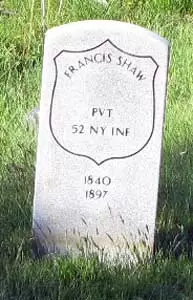
SHAW, FRANCIS (1840-1897). Private, 52nd New York Infantry. Shaw, who may have been listed in the records as Francis Sharr, enrolled as a private on August 27, 1863, at New York City, and mustered that day into the 52nd New York. He was not assigned to a company and may never have joined the regiment. His last address was in New York City. He succumbed to nephritis. Section 206, lot 21347, grave 454.
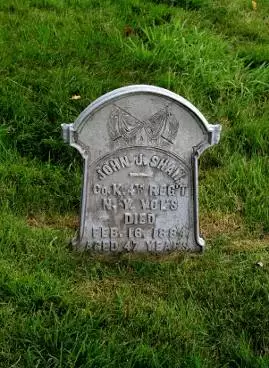
SHAW, JOHN J. (1837-1884). Corporal, 4th New York Infantry, Company K. He enlisted at New York City as a private on April 23, 1861, and mustered in on May 2. After his promotion to corporal on December 1, 1861, he was reduced to the rank of private on August 28, 1862, and mustered out on May 25, 1863, at New York City. Shaw died of phthisis. Section 17, lot 17245, grave 1689.
SHAW, OREN (or ORIN, ORRIN, ORREN) RECORD (1818-1903). Captain, 1st Massachusetts Cavalry, Company C. A native of Mercer, Maine, Shaw was a resident of Boston, Massachusetts, when he enlisted as a private on September 11, 1861. He mustered into Company C of the 1st Massachusetts Cavalry six days later and was promoted to captain on November 25. Shaw resigned on January 30, 1862.
According to the 1865 Brooklyn Directory, he was living at 350 Hicks Street and was a clerk; the 1867-1870 Brooklyn Directory indicates that he was in the grain business at the Atlantic dock. As per the 1870 Brooklyn Directory, he was living at 350 Hicks Street and working as a superintendent. In 1884 he was working as a superintendent at 20 Commercial Wharf. On December 21, 1894, the Brooklyn Daily Eagle reported that Shaw and his wife celebrated their 50th anniversary with a Golden Wedding Jubilee. Martha Shaw, who is interred with him, applied for and received a widow’s pension in 1904, certificate 585, 541. Section 154, lot 22218.
SHAW, WILLIAM MATHIAS (1836-1898). Private, 5th New York Infantry, Company K; 146th New York Infantry, Company K. Born in Philadelphia, Pennsylvania, Shaw was 5′ 8″ with gray eyes and dark hair. Employed as a painter when he enlisted at New York City on August 13, 1862, he mustered into the 5th the next day. He transferred into the 146th New York Infantry, Company K, on May 4, 1863, deserted a month later on June 29 at Frederick, Maryland, and returned on April 2, 1864. Listed as sick at City Point, Virginia, on October 27, 1864, he was hospitalized in New York City, and mustered out on June 3, 1865. He succumbed to apoplexy. Section A, lot 8998, grave 156.
SHAY, CYRUS (1815-1861). First lieutenant, 25th New York Infantry, Company C. Shay was born in New York. At the time of the 1855 New York State census, he lived in Manhattan with his wife and two-year-old son and worked as a merchant; a second son was born in 1858. As per his obituary, which confirms his Civil War service, he was a prominent political figure in the Ninth Ward and a close friend of William Poole, known familiarly as “Bill the Butcher.” (Poole, who is buried at Green-Wood, was the model of Martin Scorcese’s Daniel Day Lewis character in the movie “Gangs of New York.”)
Stating that he was 42 because the age limit for enlistment was 45, Shay, who appears to have been 46 years old at the time, enlisted as a first lieutenant on May 11, 1861, at New York City for a term of two years. He was commissioned into Company C of the 25th New York on June 14, and was mustered out soon thereafter on June 20, 1861, apparently due to illness. As per his muster roll, Shay was paid $119.10 from May 11 through June 14, 1861. He last lived at 160 Greene Street in Brooklyn. His death, five days after he mustered out, was attributed to typhoid fever. Section 115, lot 8999, grave 597.
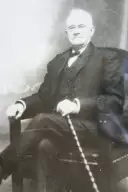
SHAY, WILLIAM C. (1832-1898). Private, 2nd District of Columbia Infantry, Company D; 1st District of Columbia Infantry, Company B. He served as a private in 1st and 2nd District of Columbia Infantries. His last residence was at 241 Cleveland Street, Brooklyn. His death was attributed to apoplexy. Section 145, lot 23364, grave 1.
SHEARER, ARCHIBALD (1842-1865). Private, 4th New York Light Artillery; 15th New York Light Artillery. Born in New York City, he enlisted there as a private on October 21, 1861, and mustered into the 4th New York Light Artillery the same day. On December 12, 1863, he transferred into the 15th New York Light Artillery serving with that unit until he mustered out on October 21, 1864, at New York City. He last resided at 40 Cornelia Street in Manhattan. Section B, lot 8575, grave 694.
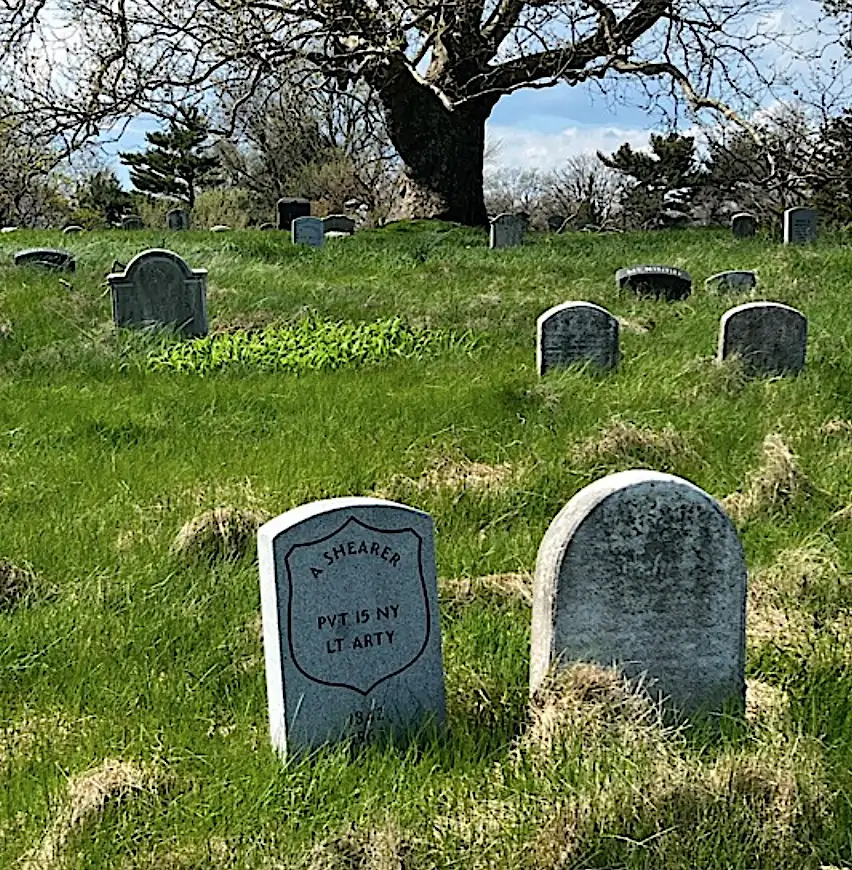
SHEARER, JOHN (1826-1900). First lieutenant, 79th New York Infantry, Companies I, D, and A. Of Scottish birth, he enlisted as a sergeant at New York City on May 13, 1861, mustered into Company I of the 79th New York on May 28, was wounded at the Battle of Bull Run, Virginia, on July 21 of that year, and was discharged on May 31, 1864, at New York City. When he returned to the 79th in 1865, he was promoted to second lieutenant and commissioned into Company D on March 29, and promoted to first lieutenant on July 1 effective upon his transfer that day to Company A. Shearer mustered out thirteen days later at Alexandria, Virginia. He last lived in Jamaica, Queens, where he died of heart disease. Section 116, lot 1561.
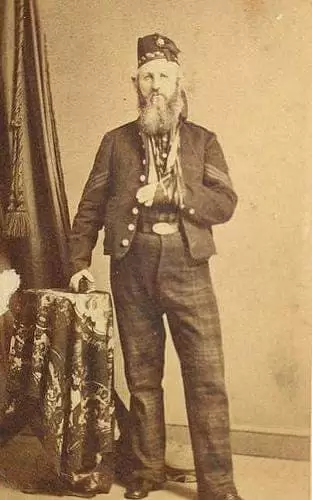
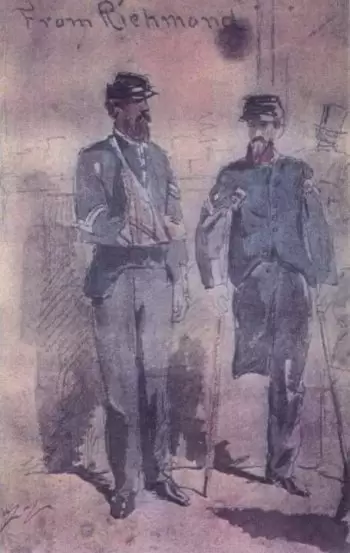
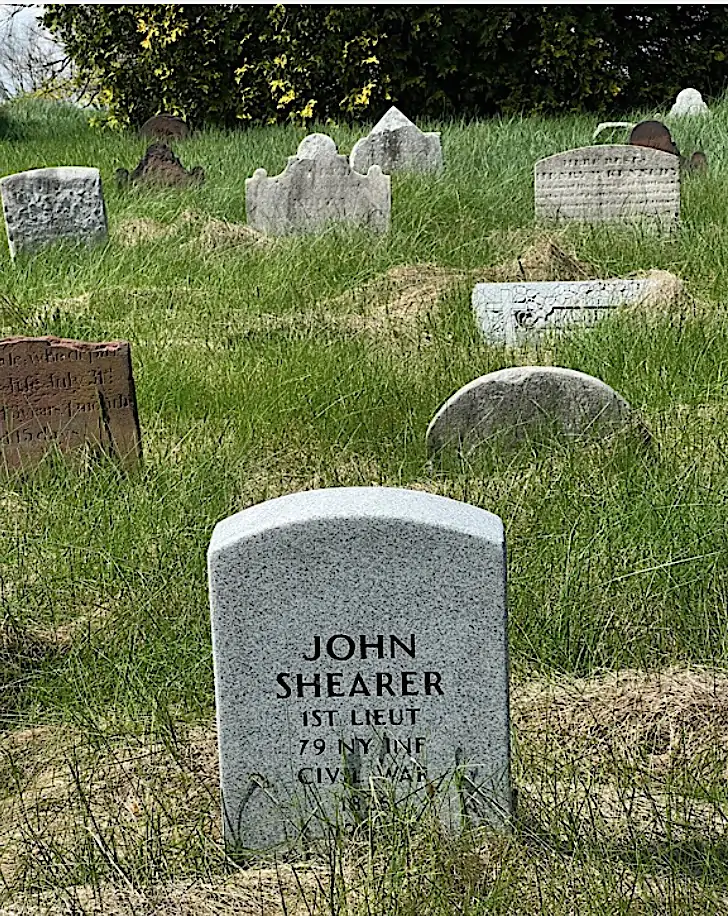
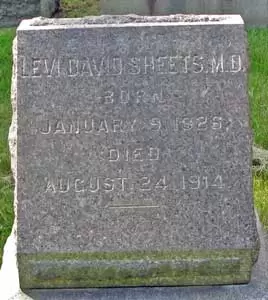
SHEETS, LEVI DAVID (1826-1914). Captain by brevet; assistant surgeon, United States Volunteers Medical Staff. Born in Emmitsburg, Maryland, Sheets enlisted as an assistant surgeon on February 1, 1864, was commissioned into the United States Volunteers Medical Staff three days later and mustered out on October 9, 1865. On October 10, 1865, he was promoted by brevet to captain “for faithful and meritorious service.” He also served as an assistant surgeon in the United States Navy.
The 1868 Brooklyn Directory lists him as a pharmaceutist (old-fashioned name for pharmacist) and the 1880 census reports that he was a physician. On September 13, 1898, he applied for an invalid pension that was granted, certificate 865,692. He is listed as a physician in the Orange, New Jersey, City Directory of 1904 and the Monclair, New Jersey, City Directory of 1910. As per his obituary in The New York Herald, which confirmed his service in the Civil War, he was a captain of New York State’s Military Order of Loyal Legion; companions of his order were invited to attend his funeral. His last residence was 182 Bay Avenue in Glen Ridge, New Jersey. Shortly after his death from chronic nephritis, Amanda Sheets applied for and received a widow’s pension in 1914, certificate 787,702. Section 157, lot 19859.
SHEFFIELD, ALONZO (1825-1920). Private, 51st New York Infantry, Company G. A native of Connecticut, he enlisted at Brooklyn as a private on August 31, 1861, mustered into the 51st New York on September 12, and deserted a month later on October 29 at New York City. The Brooklyn Directories for 1864 and 1865 list him as a baker. His last address was 509 East 23rd Street in Brooklyn. Sheffield succumbed to arteriosclerosis. Section 6, lot 22611.
SHELDON, HENRY LAWRENCE (1831-1906). Assistant surgeon, United States Navy; United States Army, Medical Department. Originally from Connecticut, Sheldon enlisted in the United States Navy on April 17, 1856, as an assistant surgeon. After he left the Navy on July 5, 1861, he enlisted in the United States Army as an assistant surgeon where he was appointed assistant medical director in the Department of the Gulf from 1863-1865. During his time in the service, he was stationed at Portsmouth, New Hampshire; West Point, New York; and New Orleans, Louisiana.
After resigning his commission in the Army on July 1, 1866, Sheldon lived in Montevideo, Connecticut, and New York. In 1906, he applied for a pension, certificate 1,164,586. His obituary in the New York Herald confirms his service as a surgeon in the Navy and Army. A physician, his last residence was in Lakewood Township in Ocean County, New Jersey. Shortly after his death, caused by apoplexy, Harriette Bartow Sheldon applied for and was granted a widow’s pension, certificate 719,400. Section 68, lot 542.
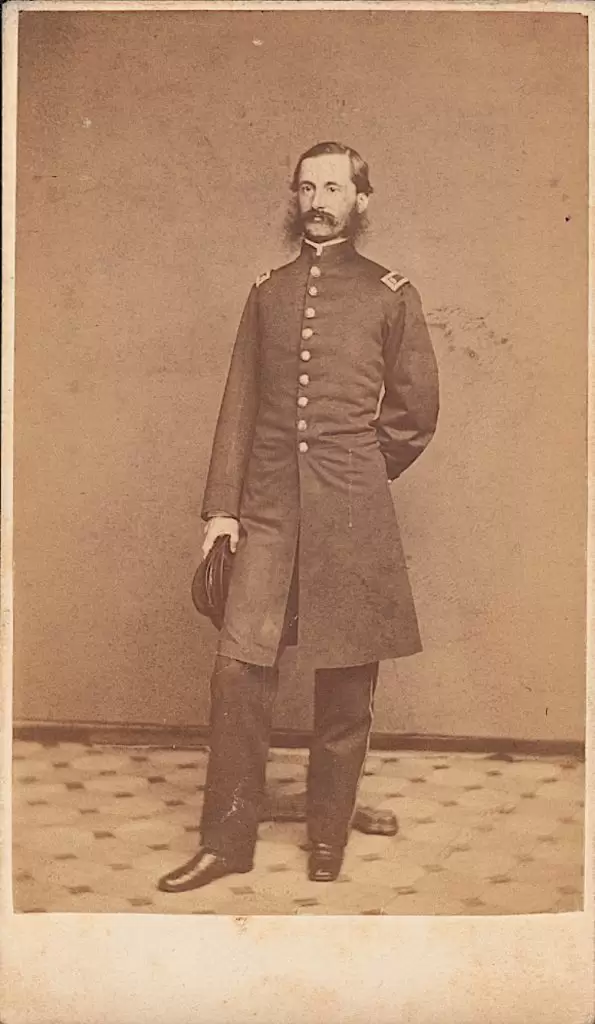
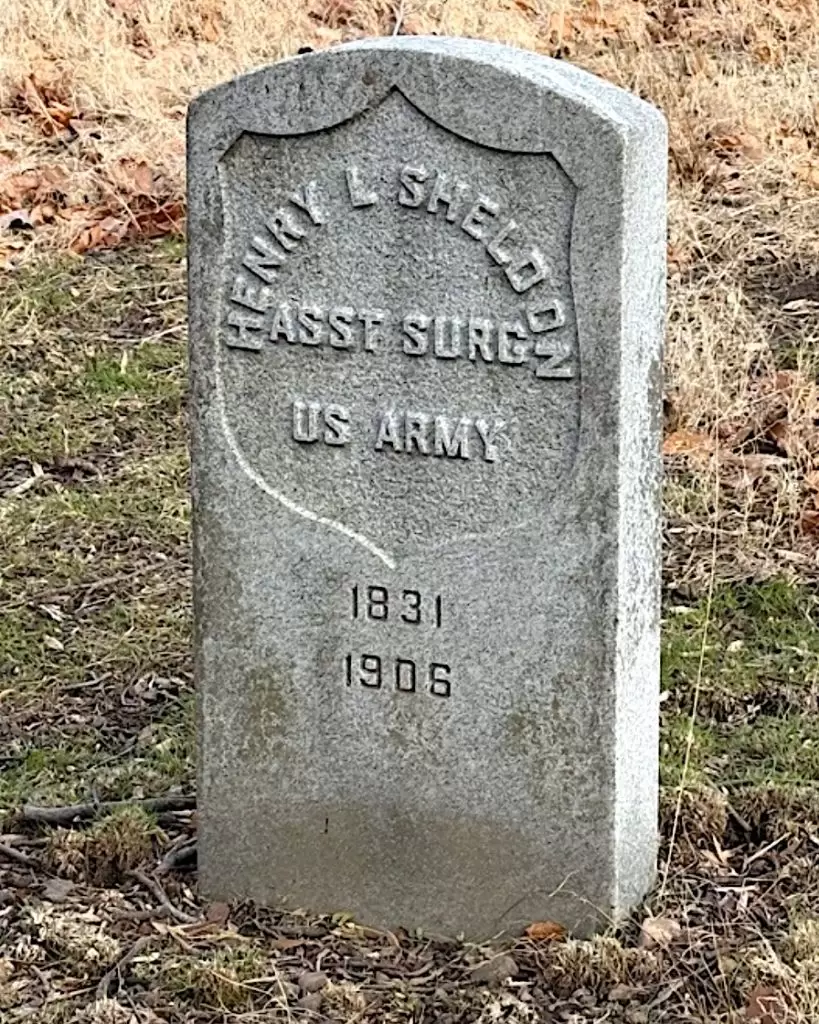
SHELDON, ROLLIN B. (or V.) (1844-1871). Corporal, 37th Regiment, New York State National Guard, Company E. A native of New York State, Sheldon enlisted as a corporal in 1863, mustered into the 37th Regiment for its activation of 30 days, and was discharged at the termination of his enlistment. He last lived in Paris, France. Section 66, lot 6857.
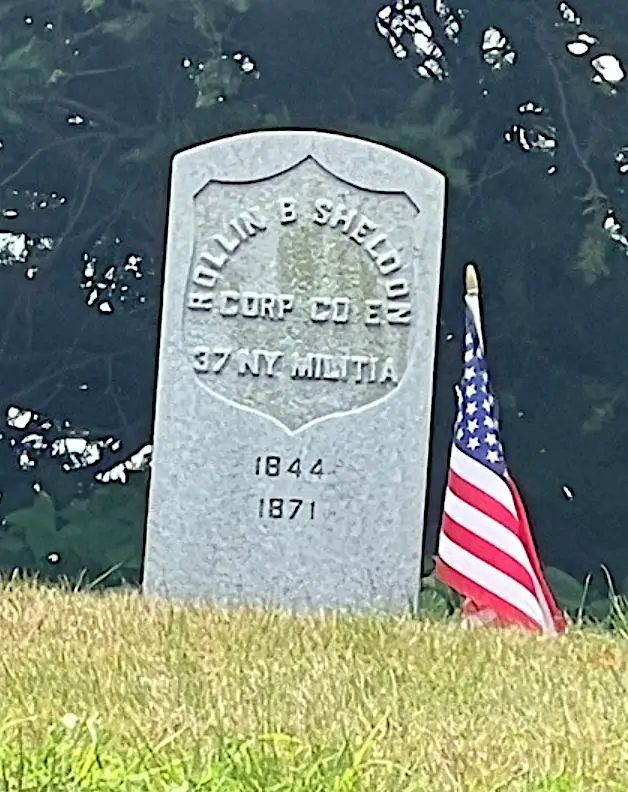
SHELLEY (or SHELLY), FRANCIS B. (1834-1893). Guide, 71st Regiment, New York State Militia. A New York native, Shelley served as a guide in the 71st Regiment when the unit was activated for three months in 1861. One record notes that he was assigned to the Field and Staff; his pension index card notes that he mustered out as a sergeant but was not assigned to a company.
As per the 1880 census and the 1890-1892 Brooklyn Directory, Shelley was a truckman living in Brooklyn. In 1891, he applied for an invalid pension, application 1,054,895, but it was never certified. His last residence was 860 Atlantic Avenue, Brooklyn. After his death from “heart paralysis due to pulmonary congestion,” his wife applied for and received a widow’s pension, certificate 376,760. Section 63, lot 7218.
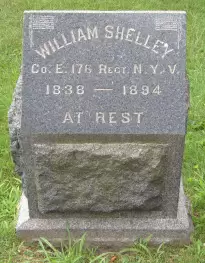
SHELLEY (or SHELLY), WILLIAM (1838-1894). First lieutenant, 30th New York Infantry, Company A; 176th New York Infantry, Company E. New Jersey-born Shelley enlisted on April 25, 1861, at Lansingburg, New York, as a first sergeant, and mustered into the 30th New York on June 1. He received a promotion to first lieutenant on August 18, 1862, to date from August 30, 1862. On May 24, 1863, the volunteers who enlisted for three years were transferred into the 176th New York. The 30th’s company mustered out on June 18, 1863, at Albany, New York. His last residence was at 461 17th Street in Brooklyn. His death was caused by phthisis. Section 197, lot 28767.
SHEPARD, WILLIAM FAULKNER (1837-1910). Corporal, 5th New York Infantry, Company G. Shepard was born in New York City according to most sources; one source says Jersey City, New Jersey. A resident of New Brighton, Staten Island, he enlisted as a private at New York City on April 25, 1861, and mustered into the 5th New York on May 9. As per his muster roll, Shepard was 5′ 5″ tall with brown eyes, brown hair and a fair complexion. At the time of his enlistment, he was a law clerk and acting lawyer in the office of Luther R. Marsh.
In August 1862, Marsh attempted to obtain a commission for Shepard by writing a letter to New York Governor Edwin D. Morgan praising “his superior attainments [and] remarkable clearness of head” and noting his “irreproachable character.” Alfred Davenport, the historian of the 5th New York who wrote about his field experiences during the Civil War, described Shepard “as a good soldier and prominent in the company from his education and standing.” Shepard was wounded in the right thigh and the left side of his neck at the Second Battle of Bull Run, Virginia, on August 30, 1862, when the 5th was overrun and initially treated at Ebenezer Hospital in Washington, D.C., before being admitted to St. Luke’s Hospital in New York City on October 5. He was promoted to corporal on September 6, shortly after his injury and was discharged for disability from St. Luke’s on January 7, 1863.
The New York Evening Post reported that William Shepard married Rosa Macneven Wilson in New York City on October 18, 1865. As per records of the Dutch Reformed Church, he and his wife had a son, Gerald Faulkner Shepard, who was born on September 15, 1867; Rosa’s brother, Philip Lee Wilson, also served in the 5th New York. Rosa died in August 1868 following the birth of the couple’s daughter, Elsie, who died in July 1868; Rosa is interred with her husband.
In 1869, Shepard was working as a lawyer at 170 Broadway and lived at 91 Livingston Street in Brooklyn. His application for an invalid pension was approved in 1885, certificate 314,015. In 1885, he lived in Middletown, New York, then, by 1906, lived in Tompkinsville, Staten Island. From 1907 until his death, Shephard lived on Second Avenue in Staten Island. Shepard’s death certificate notes that he was a widower who lived at 47 Second Avenue in Staten Island; his cause of death was chronic myocarditis (heart disease). He was survived by his son Gerald, a lawyer and genealogist. Section 8, lot 7798.
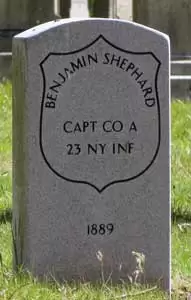
SHEPHARD, BENJAMIN (1828-1889). Captain, 23rd Regiment, New York State National Guard, Company A. He was commissioned into the 23rd on June 18, 1863, and mustered out after 30 days on July 22, 1863, at Brooklyn. His death was attributed to senile dementia. Section 179, lot 11577.
SHEPPARD (or SHEPPERD), DENNIS VAN LIEU (1843-1933). Musician, 30th New Jersey Infantry, Company F. A New Jersey native, he enlisted as a musician on September 3, 1862, mustered into the 30th New Jersey on September 17, and mustered out on June 27, 1863, at Flemington, New Jersey. In 1897, his application for an invalid pension was approved under certificate 1,114,117. He last lived at 56 West 11th Street in New York City where he died of influenza. Section 207, lot 32905.
SHEPPARD, JAMES (1830-1866). Sergeant, 127th New York Infantry, Company D. Born in Connecticut, he enlisted as a private on July 22, 1862, at New York City, and mustered into the 127th New York on September 8. During his service, he was promoted to sergeant. Sheppard died of consumption at his residence on 124th Street in Manhattan. Section 71, lot 1059.
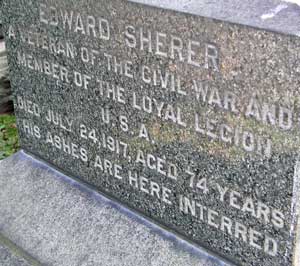
SHERER, EDWARD (1844-1917). Adjutant, 178th New York Infantry; first lieutenant and adjutant, 159th New York Infantry, Company K; first lieutenant, 67th New York Infantry, Companies G and H; private, 23rd Regiment, New York State National Guard, Company H. Born in Brandenbury, Kentucky, Sherer began his service as a young man, enlisting at Brooklyn as a second lieutenant on June 20, 1861, and was commissioned into Company G of the 67th New York on that day. He was promoted but not commissioned to first lieutenant on December 1, 1861, and transferred at that time to Company H. On May 1, 1862, he was transferred back to Company G and was discharged in October 1862. He mustered in as a first lieutenant and adjutant of the 159th on October 10, 1862. On November 1, 1862, he was relieved and assigned to Company K. Then, on November 22, 1862, he was discharged from the 159th and appointed adjutant of the 178th (Hawkin’s Zouaves, 2nd Regiment). Mustering out on April 21, 1863, he soon re-enrolled at Brooklyn in Company H of the 23rd New York State National Guard as a private and served from June 18 to July 22, 1863.
In 1904, Sherer applied for an invalid pension that was granted under certificate 1,149,409. As per his obituary in the Brooklyn Daily Eagle, he had been the secretary of the Metropolitan Savings Bank of New York. His tombstone confirms his Civil War service and notes that he was a member of the Loyal Legion, a patriotic organization of Union officers who served in the Civil War. He died of enlargement of the heart in Plainfield, New Jersey. Genevieve Sherer applied for and received a widow’s pension, certificate 847,029. Section 51, lot 12790.
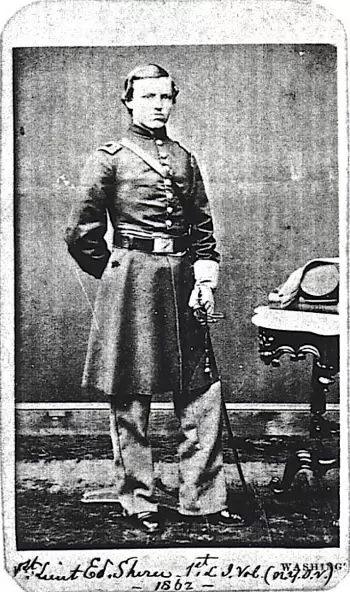
SHERIDAN, JOHN A. (1836-1914). Private, 4th New York Cavalry, Company B; 10th Veteran Reserve Corps, Company A. A native of Ireland, he enlisted at New York City on February 3, 1862, and mustered into the 4th New York Cavalry that day. On August 27, 1863, he was reassigned to the 10th Veterans, and mustered out on February 3, 1865. His last residence was in Manhattan. His cause of death was cancer. Section 148, lot 8699.
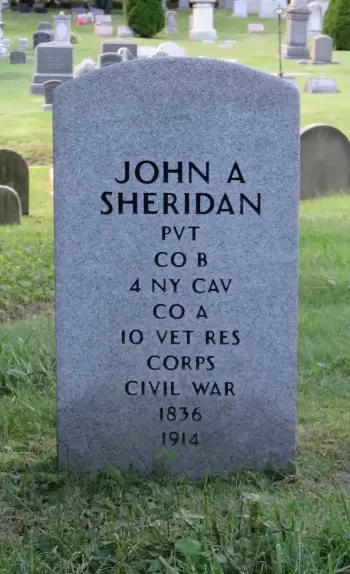
SHERIDAN, RICHARD B. (1842-1888). Hospital steward, 44th Pennsylvania Infantry; 69th Pennsylvania Infantry. After Sheridan enlisted as a hospital steward on July 1, 1863, he mustered into the Field and Staff of the 44th Pennsylvania the same day, and mustered out on August 27, 1863. At some point during the War, he was a hospital steward assigned to the Field and Staff of the 69th Pennsylvania Infantry. According to his pension index card, he also served in the 32nd Massachusetts Infantry, Company D. His last address was 853 Willoughby Avenue in Brooklyn. His death was caused by pulmonary tuberculosis. In 1890, his widow, Catherine Sheridan, applied for a pension, application 425,342, but there is no indication that it was certified. Section 59, lot 1428, grave 21.
SHERLOCK, ANDREW C. (1823-1900). Corporal, 82nd New York Infantry, Company B. Born in Newark, New Jersey, Sherlock enlisted as a corporal at New York City on April 17, 1861, and mustered in on May 21. A saddler by trade, he was 5′ 6″ with grey eyes, brown hair and a light complexion. Although he was listed as a deserter at Washington, D.C., on August 9, 1861, his pension records indicate that he was honorably discharged on August 31 of that year.
Even at age 75, Sheridan sought work at a horse-drawn cab company on Broadway and had $162 in the bank when he died. His application for an invalid pension because of a fistula and nervous debility was granted in 1891, certificate 722,129. His last address was at 413 West 34th Street in Manhattan. His death was attributed to Bright’s disease. Phebe H. Sherlock, who is interred with him, applied for and received a widow’s pension in 1900, certificate 507,093. Section D, lot 19982, grave 7.
SHERMAN, ALBERT GEORGE (1845-1914). Private, 7th Regiment, New York State National Guard, Company G. Originally from New York City, he enlisted there as a private on May 25, 1862, and mustered into Company G of the 7th Regiment’s National Guard on that same day. He mustered out with his company after three months on September 5 at New York City. He returned to the same regiment and company when it was activated for 30 days in 1863. His pension record indicates that he was also a right general guide in the 13th New York State National Guard but the details of that service are not known. In 1901, he was awarded an invalid pension, certificate 1,048,565. His last residence was in Winchendon, Massachusetts. His death was caused by cirrhosis of the liver. Section 82, lot 4579.
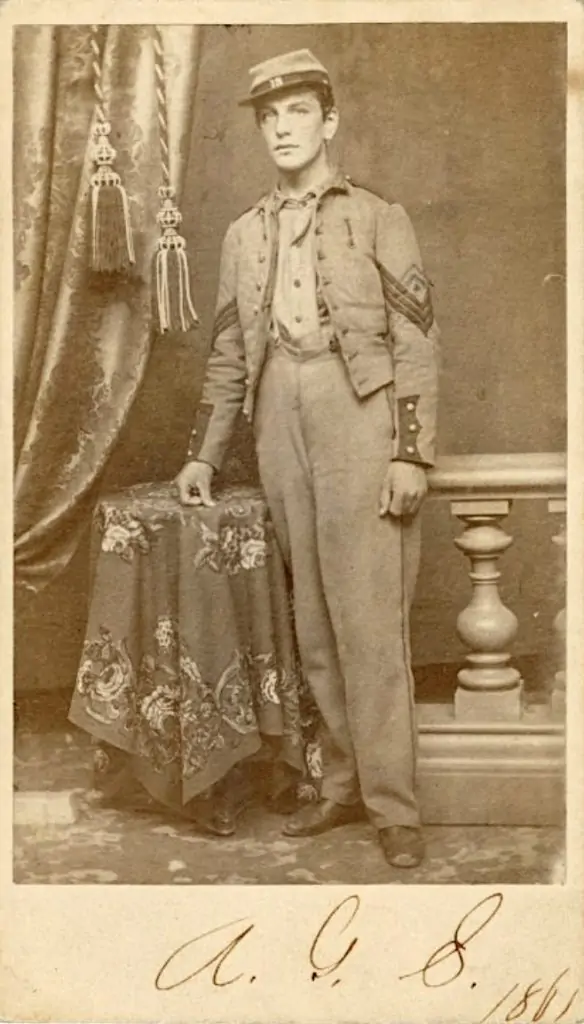
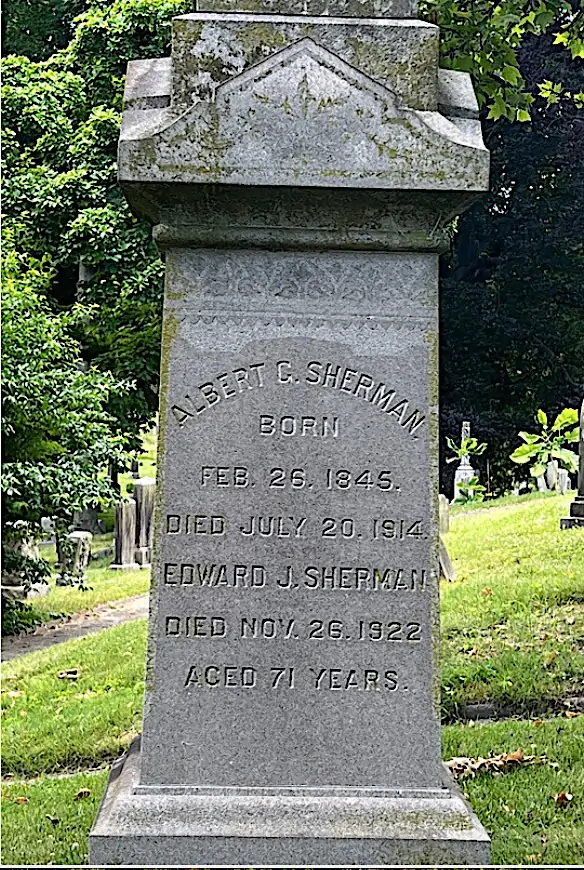
SHERMAN, JOHN R. (1834-1873). Captain, 133rd New York Infantry, Company K. Sherman, who was born in New York City, enlisted as a captain at Staten Island on September 17, 1862, and was commissioned into the 133rd New York one week later. On July 16, 1863, he was dishonorably discharged at Port Hudson, Louisiana. His last residence was 536 East 120th Street in Manhattan. Sherman succumbed to Bright’s disease. Section B, lot 8575, grave 1182.
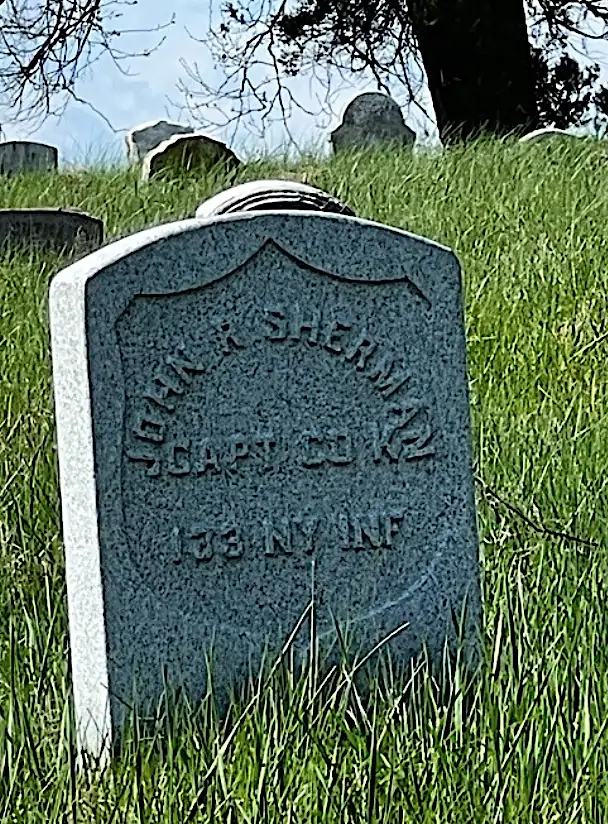
SHERMAN, JOSEPH B. (1844-1908). Private, 13th Regiment, New York State National Guard, Company D. Born in the United States, he enlisted as a private at Brooklyn on May 28, 1862, and mustered into the 13th Regiment that day. He mustered out with his company after three months on September 12 at Brooklyn. When his unit was activated in 1863, he served for 30 days.
After the Civil War, Sherman continued his service with the 13th Regiment and was discharged as a sergeant at the expiration of his duty in 1878. The 1878 Brooklyn Directory lists him as a builder; the 1880 schedule of Carpenters and Builders notes that Sherman had $300 invested in his business with two employees with an average work day of 10 hours and an average pay of $2.50 per day. In 1892, he received a Long and Honorable Service Medal from the 13thRegiment, pictured below. According to the 1905 New York State census, he was a carpenter living at 113 Fourth Avenue in Brooklyn. In 1907, Sherman applied for and received an invalid pension, certificate 1,140,884. He is identified as a Civil War veteran in the obituary of Mildred Sherman, his widow. Section 134, lot 29725, grave 522.
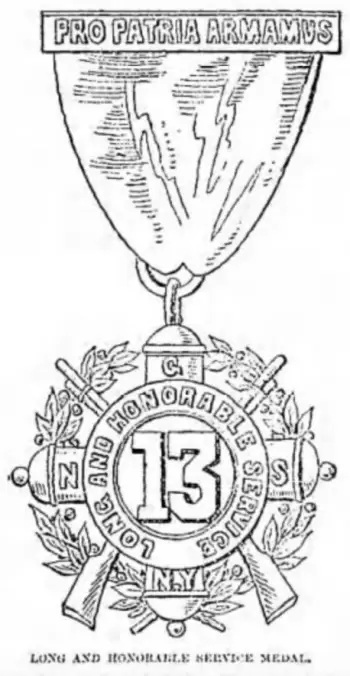
SHERMAN, SYLVESTER J. (1825-1885). Private, 7th Regiment, New York State Militia. Sherman was born in New York. As per the 1850 census, he lived with his mother and siblings in New York City. The 1855 New York State census reports that he lived with his mother and other family members in Brooklyn. According to the 1860 census, he was married with two sons, lived in Brooklyn and worked as a hoop-skirt manufacturer.
An 1861 newspaper notice reports that Mr. S. J. Sherman was missing. He was described at 5′ 10″ tall, 225 pounds, and wearing black pants, black velvet vest, black overcoat, black silk hat and black silk stockings. He also wore a large double-case gold watch with fob chain and three plain gold studs with his initials. The missing man lived at 264 Fulton Street; Sylvester Sherman worked on Fulton Street, so it is likely the same man.
During the Civil War, a S. J. Sherman served for 30 days in the 7th Regiment, New York State Militia, in 1861; that is likely the man interred at Green-Wood. The 1863 Brooklyn Directory states that he was in the shirt business. On July 3, 1864, a male child of S. J. Sherman was buried at Green-Wood (section 84, lot 6133). The 1865 New York State census reports that S. J. Sherman lived in Brooklyn with his wife and two children; one son, Clarence, who was listed on the 1855 and 1860 censuses does not appear on the 1865 census, and is possibly the child who was interred.
Working in many trades, the 1868 Brooklyn Directory indicates that Sylvester Sherman was employed in photographs at 270 Fulton Street and lived at 33 Johnson Street. The Brooklyn Directory for 1869 shows that he was in hoop-skirts and still lived on Johnson Street. The 1870 Brooklyn Directory notes that he resided at the same address and was working in real estate. As per the Brooklyn Directory for 1874, he was in the real estate business at 320 Fulton Street. Section 152, lot 18191.
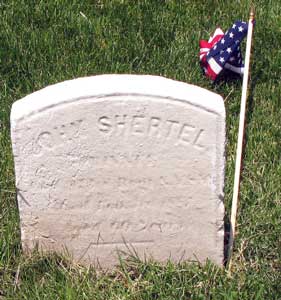
SHERTEL (or SHERTEN), JOHN (1827-1887). Private, 2nd United States Light Artillery, Company I. A German native, the specific details of Shertel’s military history are not available, but his service is memorialized on his gravestone, circa 1900. He last resided at 677 4th Avenue in Brooklyn. Section 127, lot 14838.
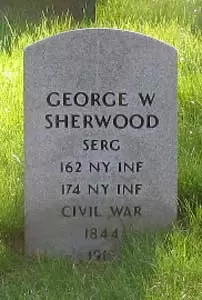
SHERWOOD, GEORGE W. (1844-1915). Sergeant, 162nd New York Infantry, Company B; private, 174th New York Infantry, Company B. A native of New York City, Sherwood enlisted as a private on September 2, 1862, mustered into the 174th New York on October 17, and transferred into the 162nd New York on February 17, 1864, as a corporal. He was reduced to the rank of private three months later on May 20. On November 1, 1864, he was promoted to corporal, rose to sergeant on August 1, 1865, and mustered out on October 12, 1865, at Savannah, Georgia. In 1905, his application for an invalid pension was granted under certificate 1,116,657. He last lived at 549 10th Street in Brooklyn. In 1915 he died from broncho pneumonia. Section 2, lot 7671.
SHERWOOD, JOSEPH (1844-1867). Corporal, 173rd New York Infantry, Company D. A New Yorker by birth, he enlisted at Brooklyn as a private on September 19, 1862, and mustered into the 173rd on October 30. He was wounded at Port Hudson, Louisiana, most likely on May 27, 1863. Sherwood was promoted to corporal on February 15, 1864, and mustered out on October 18, 1865, at Savannah, Georgia. He last lived in New York City. His death was caused by an abscess. Section 91, lot 1633.
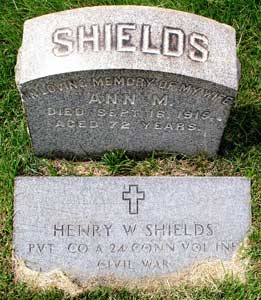
SHIELDS, HENRY (1836-1919). Private, 24th Connecticut Infantry, Company A. Born in Astoria, Queens, he was a carpenter, 5’6″ tall, with light complexion, brown hair and hazel eyes. Shields enlisted as a private on August 31, 1862, at Middletown, Connecticut, where he was then a resident. He mustered into the 24th Connecticut on November 8, and mustered out at Middletown on September 30, 1863.
After the War, Shields lived for a time in Brooklyn, where he worked as a ship caulker. In 1891, he applied for and received a pension, certificate 830,630. In 1900, he moved to Noroton Heights, Connecticut. As per his obituary in the Brooklyn Standard Union, which confirms his Civil War service, he was one of the oldest members of the Frank Hess Post #17 of the G.A.R. The obituary also notes that he was promoted to sergeant through his “bravery in action”; that promotion is not confirmed on his soldier history. He died from chronic myocarditis at Fitch’s Home for Soldiers in Noroton Heights, Connecticut. His gravestone confirms his service in the 24th Connecticut. Section 16, lot 14888, grave 1118.
SHIELDS, THOMAS H. (1841-1888). Private, 57th New York Infantry, Companies F and E; 61st New York Infantry, Company K. A native of New York City, he enlisted there as a private on November 1, 1861, and mustered immediately into Company F of the 57th New York. After his three year term ended, Shields re-enlisted on January 1, 1864, and was transferred intra-regimentally to Company E on that day. He transferred out on December 20, 1864, when he joined Company K of the 61st New York, during which time he was wounded at some point before his discharge. His last residence was in New York City. He died of pneumonia. Section 4, lot 21072, grave 201.
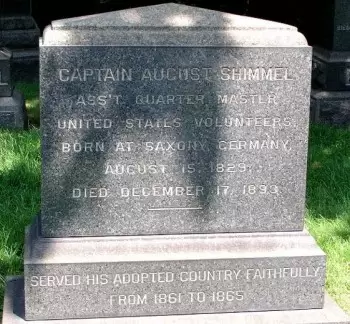
SHIMMEL, AUGUST (or AUGUSTUS) (1829-1893). Captain and assistant quartermaster, United States Volunteers Quartermaster’s Department; first lieutenant and quartermaster, 8th New York Infantry. Born in Saxony, Germany, Shimmel enlisted as a first lieutenant at Arlington, Virginia, on August 1, 1861, was commissioned in that day with a promotion to first lieutenant and quartermaster, and was discharged on October 31. He was subsequently promoted and commissioned into the United States Volunteers Quartermaster’s Department as a captain and assistant quartermaster on February 19, 1862. He was cited by Generals Ingalls and Steinwehr for “valor and energy in protecting our property,” during an attack by Stuart’s cavalry on the field-train of the 11th Corps on August 23, 1862. He formed his train at Catlett’s Station, Virginia, and with a guard of 20 men from the 45th New York repulsed the assault.
Shimmel was present at many battles of the Civil War including these in Virginia: Bull Run, Cross Keys, Strasburg, Culpepper, Slaughter Mountain, White Sulphur Springs, Warrenton, Fredericksburg, and Chancellorsville. In addition, he was at the Battle of Chattanooga, Tennessee, and in Georgia at Resaca, Big Shanty, Kennesaw Mountain, Chattahoochee River, Atlanta, and Savannah. He was discharged on April 22, 1865. According to William Swinton’s History of the Seventh Regiment (1876), Shimmel also served in Company F of that unit; the dates of his service were not noted. His gravestone notes that he “served his adopted country faithfully from 1861 to 1865.” Section 203, lot 28703.